The Ultimate Guide to Visiting The Forbidden City
Why is it called the forbidden city.
The Forbidden City is also called the Palace Museum. It was off-limits to the general public for over 500 years. Only the emperor, his family, and authorized officials were allowed to enter, giving it an aura of secrecy and exclusivity.

Forbidden City Tip: Logistics
How to buy the Forbidden City tickets?
Five crucial facts you should Know!
#1 The Forbidden City is not open on Monday!!!
#2 This is super important!! There are a limited number of tickets every day. (It can be sold out during the low season; There are only 50000 tickets every day till now)
#3 The tickets can be booked seven days before at 8 pm. So try to get your tickets as early as you can.
#4 Time-slot reservation policy and ticket inspection measures For example, if you booked the morning tickets, you should get in before noon, and afternoon tickets can only go inside the afternoon.
# 5 The business shooting is prohibited, so the gimble and triple cannot be taken inside.
3 WAYS TO BUY FORBIDDEN CITY TICKETS
NO.1 All domestic tourists buy tickets from WeChat; however, international tourists do not recommend it since all the apps are in Chinese, and you must pay via WeChat or Alipay. If you can use WeChat, search for “故宫博物院,” and”you will be led to the ticket booking site.
NO.2 You can easily book the tickets from the official website of the Forbidden City. ( The Palace Museum (dpm.org.cn) )
NO 3. Send an email to the Forbidden City to book the tickets.
Internatio”al visitors can reserve admission tickets up to seven days before the day of visit and are required to submit by email the full name, passport number, and intended visit date of each visitor to the Museum’s offMuseum’scket reservation email address at [email protected] at a minimum of one calendar day in advance. An individual may only reserve one admission ticket on any given visit date.
I will keep you updated! You can also send me an email to check the new policy.
How To Get There?
Address: No.4 Jingshanqian Street, Dongcheng District, Beijing, China Zipcode: 100009
Taxi or subway
Show the taxi driver: 天安门广场
The Forbidden City is friendly and easy to reach. It is just the north of Tiananmen Square. So before visiting the Forbidden City, you may also like to walk around Tiananmen Square first.
Hop on the Beijing subway, and get yourself to Tiananmen East station (located almost in the middle of the Beijing subway map, on the red Central Line 1 ).
If you keep your eyes peeled, you’ll notice a notice telling you which exit to go to reach Tiananmen Square (Go out from Exit B).
Once you’ve left your driveway station exit B , you’ll find yourself at the end of a long line waiting for security to enter Tiananmen. (The Security queue can be long and easily take half an hour.)
From the doorway down the Tiananmen Tower, it is about 200 meters to get to the Forbidden City.
If you have limited time and don’t want to wait for the long security queue, you can skip Tiananmen Square and walk to the Forbidden City directly. You can visit Tiananmen Square in the afternoon; the line is usually shorter.
Opening Hours & Ticket Prices
The best time to visit.
As time changes, the Forbidden City looks different with its specialties. So you can visit the Forbidden City almost the whole year. (It is not open all Monday)
Forbidden City is the busiest attraction in Beijing, so it is always full of people. Some tips for you to avoid the crowds:
1. Go earlier. It opens at 8:30 am, so arrive at 8 am and queue at the beginning. You can go in front of the groups and enjoy the Forbidden City by yourself.
2. Go late. The Forbidden City closes at 5 pm, so if you go around 2 pm, it is not as busy as in the Morning.
3. It is better not to visit the Forbidden City at the weekend.
4. Avoid all the important Chinese holidays, such as National Day and the Chinese New Year.
Food and drink
There are six restaurants inside the Forbidden City, like fast Chinese food; the quality is OK, and the budget is around 100RMB per person. (I have marked them out on the map below). But it is straightforward to find shops to sell water and snacks. A bottle of water is 4 RMB.
Hear entertaining stories of the Forbidden City
Discover the hidden tales and untold history of the Forbidden City. Prepare yourself for an extraordinary journey by reading the stories behind this majestic imperial palace.
20 Intriguing Secrets and Facts Revealed in Forbidden City
Forbidden City Tips: Seeing the highlights
Forbidden city map + best travel routes (From Local guide suggestion)
1 Meridian Gate (午门)
The Meridian Gate, the main entrance of the Forbidden City in Beijing, is located on the north-south axis of the Forbidden City. You can always go up to the Gate to see a bird ‘ s-eye view of the Forbidden City before you go deep inside. When you enter the Forbidden City, turn left, and you will find the stairs up to the Meridian Gate. There are always some excellent temporary exhibitions from all over the world.
2 Hall of Supreme Harmony (outer court) (太和殿)
The Hall of Supreme Harmony is the largest structure in the Forbidden City and was once the tallest building in the capital. It was used for state occasions, such as the emperor’s crown ceremony and the nomination of military leaders.
3 Palace of Heavenly Purity (inner court) (乾清宫)
This is the residence of Ming and early Qing emperors and later an audience hall for receiving foreign envoys and high officials. The highlights are the decorations inside. 1. How did the Qing emperor choose his successors ? 2. What is the emperor’s bedroom like? 3. 6 big mirrors inside, do you know what it is for?…
4 Six Western Palaces (西六宫)
A dozen smaller palace courtyards lie to the west and east of the three lesser central halls. It was in these self-contained abodes where most emperors and empresses lived.
The 6 Western Palaces are the Original Forms of the Old Life. You can easily find the palace where the last emperor lived and Cixi’s palacCixi’s
5 Eastern Palaces(东六宫)
Like the 6 Western Palaces, these are also the palaces where the concubines live. But they have changed into exhibitions now. The bronzes exhibition at the Palace of Celestial Favour and Palace of Enteral Harmony. Ceramic show at the Palace of Prolonging Happiness.
6 Treasure Gallery (珍宝馆)
On the northeastern edge of the complex is what feels like a mini Forbidden City all of its own. The Palace of Tranquil Longevity was built around 1771 for Qing Emperor Qianlong, though he never moved in.
Nine dragon screen is just at the entrance. There are a lot of exhibitions inside, such as the Jade exhibition at the Palace of Tranquil Longevity and the Drum-shaped stone locks exhibition at the Hall of Imperial Supremacy.
7 Imperial Garden (御花园)
The Imperial Garden is 130 meters wide over 90 meters long. In the Garden, there are ancient towering pines and junipers. Grass. Strange flowers and rocks . The whole garden is where ladies living in the forbidden city like to walk around. It is exquisite.
Jinshan Park (景山公园)
Jinshan Park does not belong to the Forbidden City; it is at the north exit of the Forbidden City. It is a super nice view if you go up the hill to see the Forbidden City, which can make your Forbidden City visit complete .
So I advise now to go to the excellent gift shop, the Forbidden City, and the sights around are too good to devote just one day to; use the guide to pinpoint exactly what else you’d like to do and mark them for the next time.
Jingshan Park Travel Guide
Forbidden City travel FAQS
How to avoid the crowd?
Early bird and late bird!
Early bird is always helpful to avoid the crowd. But it is not my favorite time to go early.
I don’t recommend you go early because everyone thinks the same, especially the tour groups. A long queue waits at the front door(medium gate) before opening. If you only have 1 or 2 hours to visit, I highly recommend you go after 1:30 pm. It is much better.
Every day from 10:00 am to 1:00 pm , the Museum receives the most visitors.
If you want to stay inside for a whole day, be the early bird since it is vast.
There are some Chinese holidays; it is always busy. If you can skip them, it helps you get a better travel experience.
Dates to avoid visiting China!
How do I visit the Forbidden City by myself?
If you want to see as much as possible, please read the blog below. It can easily take you 4 hours or more.
Forbidden City Map + Best Travel Routes (Without BACK AND FORTH)
If you don’t have one, choose some interesting sights to see.
Tour Guide or Audio Guide
A tour guide is essential to learn more details about the Forbidden City. But you can also quickly get an audio guide at the entrance (The cost of renting any version of the device is CNY 40 (Chinese and Cantonese are both CNY 20); return at the exit, no deposit needed). It includes 35 languages.
What should I wear?
There is nothing you should be concerned about regarding the dress. Just wear comfortable walking shoes as it is big inside with many steps.
What MUST I take?
Your passport. It would be best if you had access to the Forbidden City. A security check is always near the square, so it is a must before you visit.
Wheelchair Accessible
Yes. Just around the axis of the Forbidden City.
Where to finish the Forbidden City trip?
There are two exits in the Forbidden City: the North gate and the East gate.
Most people choose the north gate to go out.
Going out from the east gate is good!
A. Your time is minimal . You can jump in, take some photos, and leave. It can help you save a lot of time. You may especially waste time in the queue. B. You are with people who are not good walkers . This is an easy way for people to understand the Forbidden City. C. If you want to take a fantastic photo of the Forbidden City. The best time is 10 minutes before it closes. Going out from the north gate may be rushed, so the east gate is the best choice.
Other sights near the Forbidden City
After completing the Forbidden City trip, it is better to go up to Jingshan Park to enjoy a bird’ s-eye of the Forbidden City.
The Forbidden City turret is also a great place for photos.
Beihai Park is a 5-minute from the North Gate of the Forbidden City.
Good restaurants near the Forbidden City
After the long walk, I guess you must feel a bit tired and hungry. Unfortunately, there is no good restaurant near the north gate of the Forbidden City, but you may like to go to a good coffee restaurant.[ Alley Coffee 寻常巷陌 It is near the east entrance of Jinshan Park, about a 5-minute walk from the North Gate of the Forbidden City.
Can I visit the Great Wall and the Forbidden City in 1 day?
It is doable if you have limited time, such as a layover. But both will be a bit rushed; I suggest you do them in 2 days.
Related posts (Tips and details)
11 theme Permanent Galleries in the Forbidden City
4 Most Important People with Forbidden City History
Why there are 9999.5 rooms in the Forbidden City? Where is the half room?
Forbidden City Detail (2): Why the emperor’s bedroom so small?
Leave a Reply
This site uses Akismet to reduce spam. Learn how your comment data is processed .
- Other Sights in Beijing (39)
- World Heritage (19)
- Beijing Food (6)
- Beijing Surrounding (13)
- Beijing Travel News (3)
- Jiankou Great Wall (7)
- Jinshanling Great Wall (10)
- Mutianyu Great Wall (10)
- Other Sections (8)
- Photo Gallery (12)
- Reviews (1)
- Stories (6)
Hi, I am Leo Kui . Your new friend from Beijing. I’m a Beijing local with my finger on the pulse of the city and a passion for sharing the real Beijing with travelers from around the world. Allow me to help make your stay in Beijing extra special , and help give you the tools, tips, and tricks you’ll need to explore this wonderful city with confidence.
Beijing travel FAQS
- The Ultimate Guide to Visit The Forbidden City
- How to visit the Mutianyu Great Wall on my own?
- All You Should Know Before Visiting Beijing Summer Palace
- Ultimate Jinshanling Great Wall Travel Guide
- 12 Fantastic Facts Of The Great Wall
- Six Places To See Incredible Views Of The Beijing Skyline
- A Grief Guide to Beijing Layover Tour
Quick Inquiry
Tour and Subject * :
Message * :
please answer 7-5=?
Beijing Walking Tours delivers an uniquely authentic tour experience. Be immersed in authentic Beijing with stories and people you'll remember.
TripAdvisor Excellence
Beijing travel tips.
Which is the best section of the Great Wall to visit? Badaling, Mutianyu or Jinshanling?
Top 10 things you must know before you visit Beijing
Hike from Jiankou to Mutianyu Great Wall on your own!
Tangjialing New Town T09-1502, Haidian District, Beijing, China Tel(whatsapp): +86 13581665548 Wechat: Beijingwalkingtours Email: [email protected]
Stay Connected
Copyright © 2012. All Rights Reserved to Beijing Walking Tours.
Privacy Policy Contact Us Sitemap
TRAVEL CHINA WITH NING
- Jun 15, 2023
Your Ultimate Guide To The Forbidden City: Everything You Need To Know
Updated: Oct 7, 2023
Photography of the Forbidden City.

The Forbidden City, nestled in the heart of Beijing, holds a distinguished place as a UNESCO World Heritage site and stands as an enduring symbol of China's rich cultural heritage. For more than 500 years, it served as the regal abode for Chinese emperors and their households during the illustrious reigns of the Ming and Qing dynasties. Occupying a sprawling complex that spans an impressive 180 acres, this architectural marvel encompasses a staggering 9,999 rooms. The Forbidden City astounds visitors with its resplendent traditional Chinese architecture, enchanting courtyards, and an unparalleled collection of priceless artifacts.
Reading “Your Ultimate Guide to the Forbidden City: Unlocking the Secrets of China's Imperial Wonder” is really important if you’re planning to visit this incredible historical site. It's packed with insider tips, practical information, hidden gems, cultural insights, and extra recommendations to make your experience truly memorable and special. Trust me, you will get everything you need to know about The Forbidden City!
Here are two ways to book The Forbidden City tickets
Tips For Visiting The Forbidden City
Tips For The Security Check At The Forbidden City
What Can You Do After Visiting The Forbidden City
Here are two ways to book The Forbidden City tickets:
1. Wechat Mini Program: Search for the Wechat mini program called "故宫博物院" (Palace Museum). Through this platform, you can book your tickets up to 7 days in advance.
2. Official Website: Visit the official website at https://en.dpm.org.cn/visit/tickets/ for all the necessary booking information. You can book tickets via email, and the museum usually responds within 2 days.
Important information:
Due to the high demand for tickets to the Forbidden City, there is no guarantee that you will be able to purchase them.
The Forbidden City is closed on Mondays.

Things You Need To Know About Visiting The Forbidden City:
To make the most of your visit and ensure a memorable experience, we have gathered some insider tips to guide you through the wonders of the Forbidden City.
1. Plan Your Visit in Advance:
The Forbidden City is a vast complex with numerous halls, palaces, and gardens. To avoid feeling overwhelmed, it's essential to plan your visit in advance. Start by checking the opening hours and plan to arrive early in the morning to beat the crowds. Allocate sufficient time to explore the main highlights, such as the Hall of Supreme Harmony, the Palace of Heavenly Purity, and the Imperial Garden.
2. Wear Comfortable Shoes and Dress Appropriately:
The Forbidden City is vast, covering an area of 180 acres, so be prepared for a lot of walking. Wear comfortable shoes to ensure a pleasant exploration of the complex. Additionally, dress appropriately for the weather and respect the conservative culture by avoiding revealing clothing. Remember to bring a hat, sunscreen, and stay hydrated, especially during the hot summer months.
3. Follow the Recommended Route:
To make the most efficient use of your time, follow the recommended route provided by the Forbidden City. This route ensures that you don't miss any of the must-see attractions and helps you navigate through the complex seamlessly. Be sure to pick up a map at the entrance and familiarize yourself with the main landmarks along the way.
To ensure a smooth, enjoyable and flexible self-guide visit to The Forbidden City, consider to rent Audio guides (Audio guides are available in multiple languages). "This Automatic Guided Map is like a tour guide and will explain the history as you walk to each part of The Palace Museum." (Comment from Reddit user kuanyuchen99 ).

(Photo from Reddit user kuanyuchen99 ).
4. Take Breaks at the Scenic Spots:
Throughout the Forbidden City, you'll find picturesque courtyards, gardens, and pavilions. Take advantage of these scenic spots to rest, soak in the ambiance, and capture stunning photos. Don't rush through the visit; allow yourself moments of tranquility to appreciate the beauty and serenity of the surroundings.
5. Explore the Two Extra Galleries:
While most of the attractions within the Forbidden City are included in the general admission ticket, there are two additional paid museums that you can visit:
Palace Museum Treasure Gallery: Located in the northeastern section of the Forbidden City, the Palace Museum Treasure Gallery showcases a stunning collection of imperial treasures, including gold, silver, jade, and precious gems. Admission to this gallery requires an additional fee.
Clock and Watch Gallery: Situated in the Hall of Ancestry (Fengxian Dian), the Clock and Watch Gallery exhibits a remarkable collection of ancient timepieces, ranging from mechanical clocks to intricate Chinese water clocks. Access to this gallery also requires a separate ticket.

Tips For The Security Check At The Forbidden City:
The security check at the Forbidden City is very strict.
1. Please carry a valid identification document , such as a passport or ID card.
2. Follow the instructions of the security personnel and queue up for the security check.
3. Prohibited items include flammable, explosive, toxic, or other dangerous substances. For example, sunscreen sprays are also not allowed, so please do not carry them.
4. Place personal belongings, such as packages and handbags, in the security screening equipment for inspection.
5. Cooperate with security personnel for the inspection of handheld items, such as mobile phones and cameras.
6. Adhere to the rules and designated no-photography areas within the Forbidden City.
7. Large luggage or excessively heavy items are not allowed inside the Forbidden City.
8. Maintain silence and respect other visitors and the preservation of cultural relics.

What Can You Do After Visiting The Forbidden City:
After exploring the grandeur of the Forbidden City, there are plenty of other attractions and activities to enjoy in Beijing. Here are some recommendations for what you can do next at the same day:
1. Visit Tiananmen Square: Located just outside the Forbidden City, Tiananmen Square is one of the world's largest public squares and an important historical site. Take a stroll, admire the iconic Tiananmen Gate, and learn about China's rich history.
2. Explore Jingshan Park: Located north of the Forbidden City, Jingshan Park offers breathtaking panoramic views of Beijing's cityscape. Climb to the top of the park's artificial hill and take in the stunning scenery while enjoying a peaceful atmosphere.
3. Discover the Hutongs: Take a rickshaw ride or a leisurely walk through Beijing's traditional hutong neighborhoods. These narrow alleyways lined with courtyard homes provide a glimpse into the city's old-world charm and local culture.
4. Visit the Temple of Heaven: Head to the Temple of Heaven, a magnificent imperial complex where emperors of the Ming and Qing dynasties would offer prayers for good harvests. Explore its stunning architecture and tranquil gardens.
5. Explore Beihai Park: Visit Beihai Park, a picturesque imperial garden located in the heart of Beijing. Enjoy serene lakes, beautiful pagodas, and historic temples while strolling through its well-manicured gardens.
6. Indulge in Beijing's Cuisine: After a day of sightseeing, treat yourself to Beijing's famous culinary delights. Sample Peking duck, dumplings, and other local specialties at one of the city's many renowned restaurants.
7. Shop at Wangfujing Street: Experience Beijing's bustling shopping scene at Wangfujing Street, a famous pedestrian street known for its luxury shopping malls, traditional shops, and delicious street food.

Recent Posts
Mid-Autumn Festival: Traditions and Celebrations
How Foreign Visitors Can Travel in Tibet - From Tibet Entry Permit to Top Sights
Hainan Travel: 30-Day Visa-Free Policy and Hidden Gems
Matador Original Series
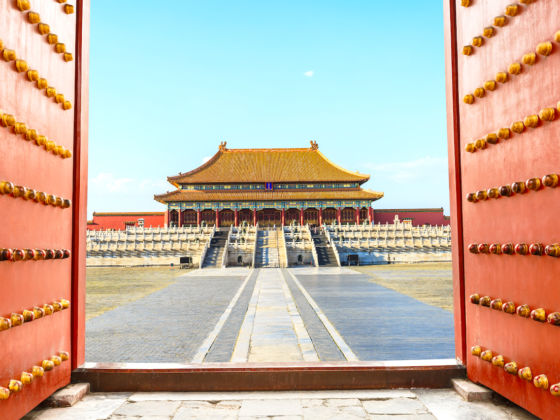
The Ultimate Guide to Spending One Day in Beijing's Forbidden City
W alking north across infamous Tiananmen Square under the constant watch of security cameras, you’ll soon find yourself staring right into the eyes of Mao Zedong. The framed picture of the leader of the Communist revolution hangs high on Tiananmen Tower, through which you’ll access the Meridian Gate leading to the Forbidden City, welcoming tens of thousands of daily visitors who want to get a glimpse of China’s long-gone imperial past.
Within its six centuries of history, Beijing’s Forbidden City has turned from being the residence of Ming and Qing emperors to being one of the most visited open-air museums in the world. One of China’s top attractions together with the Great Wall, the Forbidden City is a complex consisting of 980 buildings that were once inaccessible to commoners.
Known today as the Palace Museum, the impressive size of this red and yellow fortress is intimidating. This condensed guide is meant to help you make the most out of your day in the Forbidden City, giving you ideas on how to plan your visit and navigate this huge palace complex.
What is the Forbidden City?
The best time to visit the forbidden city, how to get to the forbidden city, price, and hours of operation.
- How to organize your visit and the best things to see
If you have more time
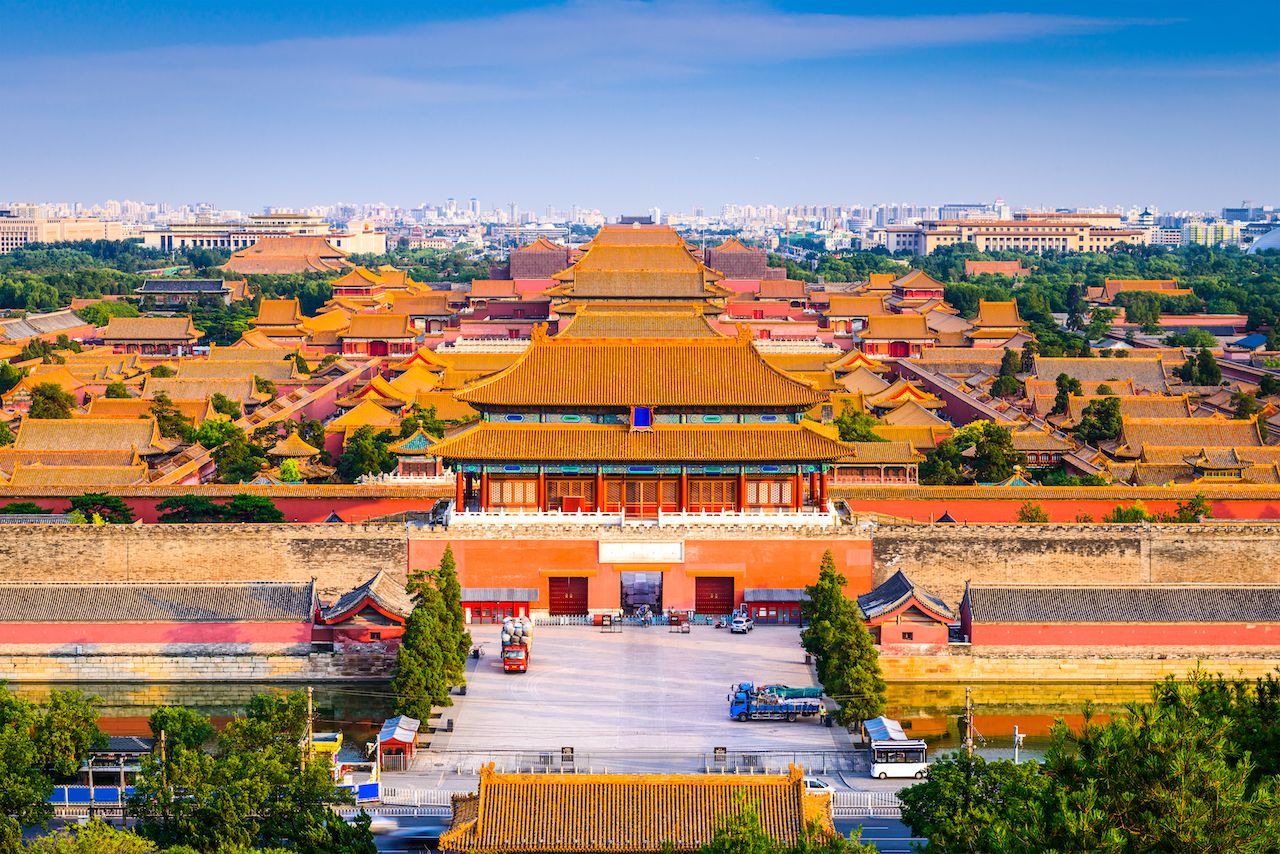
Photo: ESB Professional /Shutterstock
Located in the very center of the Chinese capital city, Beijing’s Forbidden City is a treasured remnant of China’s imperial past. Today, the fortified citadel that for centuries housed the emperors, their families, and their servants has become a UNESCO-protected historical site known as the Palace Museum.
With nearly 15 million visitors every year, the complex is far from “forbidden” these days. Its name, however, reminds us of an era during which a ticket was not enough for entering the 26-foot thick walls of the fortress. During the Ming and Qing dynasties, only the relatives of the emperor and government officials were allowed in, while commoners would be punished with death for trespassing.
Completed in 1420 under the orders of the Ming dynasty’s Yongle emperor, the Forbidden City has been the center of Chinese political power for almost 500 consecutive years. Millions of workers were employed in the construction of the palaces under the supervision of architect Kuai Xiang, although most of the architectural elements visible today have been damaged and restored over time.
The Forbidden City hosted 24 different emperors until 1911, when Puyi, the last emperor, was ordained to abdicate by the revolutionary forces. Luckily for us, the opposers of imperial power that governed China in the following decades recognized the cultural importance of this architectural wonder, preserving it for the world to see and appreciate. It was declared a key historical relic by the Chinese government in 1961 and a World Heritage site by UNESCO in 1987.
Beijing’s Forbidden City sees millions of tourists coming from all over China and abroad every year. Avoiding crowds is no easy task, but because the complex covers 178 acres of ground, you will definitely be able to find a quiet spot.
The high season is from the beginning of April to the end of September. For the best weather, plan your visit between March and June or between September and October. The middle of summer can be very hot, white you are likely to find fog during cold winter days.
Avoid the days around Chinese holidays such as the Spring Festival, also known as Chinese New Year (date varies from mid-January to early February), National Day (October 1), and the Mid-Autumn Festival (date varies from mid-September to early October) at all costs. During these festivities, the amount of visitors increases dramatically and navigating through massive crowds can be a gong show.
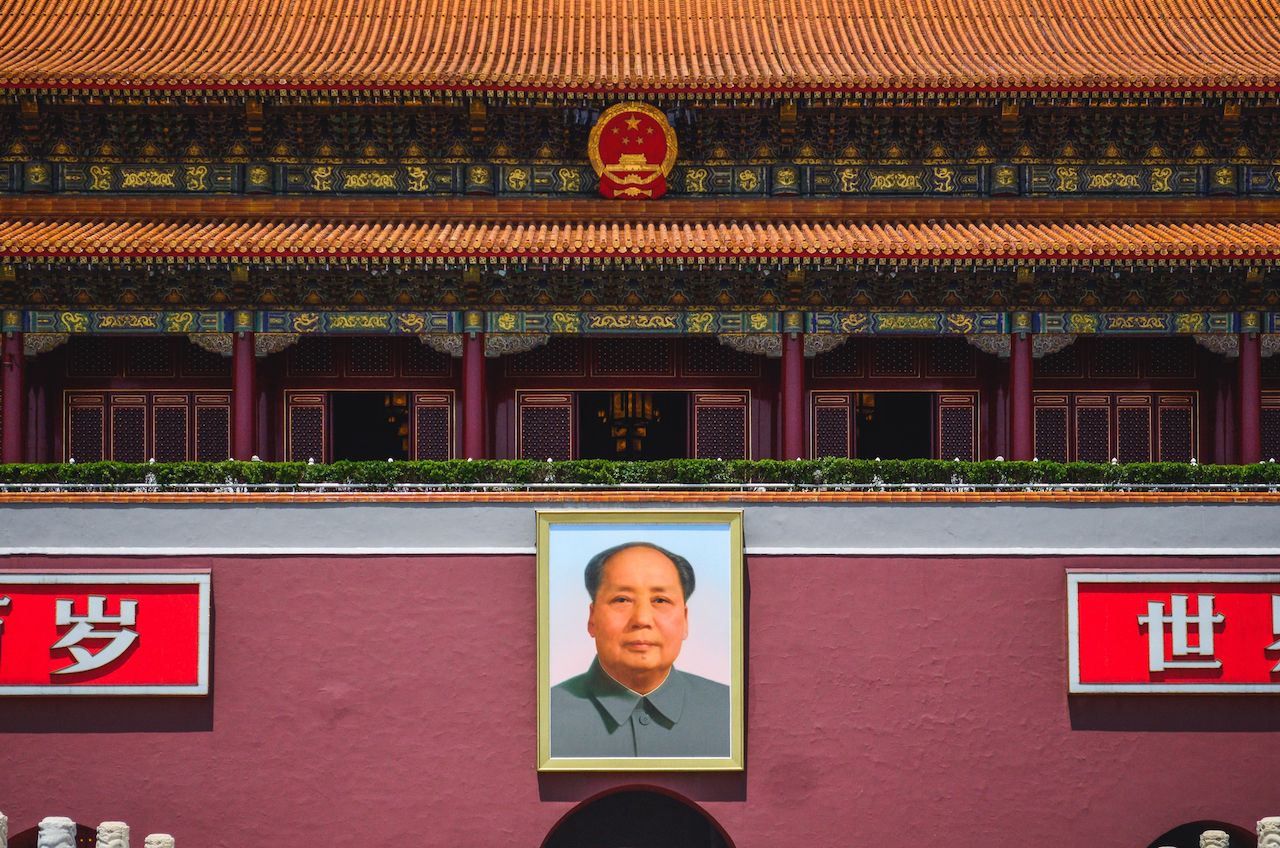
Photo: Angelo Zinna
The Forbidden City is impossible to miss. It is located right in the heart of Beijing, at the northern edge of Tiananmen Square. Tiananmen Square East is the closest subway station, steps away from the entrance. If you can’t spot Mao’s face from a distance, you will find English language signs guiding you as soon as you emerge from the station.
When visiting the Palace Museum, make sure you bring your passport along. You will have to show it both at the security checks when you enter Tiananmen Square and when purchasing your entrance ticket. The cost of visiting differs depending on when you go. In the high season (April 1 to October 1) tickets cost 60 Chinese yuan (about 8.50 USD), while in the low season the price goes down to 40 yuan (5.70 USD).
Since 2015, the Chinese government has set the limit of daily visitors to 80,000. If you can, buy tickets in advance through the official website , however, patience is key unless you can read Chinese. Keep in mind that booths at the Meridian Gate only sell same-day tickets.
Children enter for free and visitors over 60 receive a 50 percent discount. Audio guides are available for an additional 40 yuan (5.70 USD) and there are luggage storage facilities. The Forbidden City opens at 8:30 AM and closes at 5:00 PM in the high season and 4:30 PM in the low season. It is closed on Mondays.
How to organize your visit
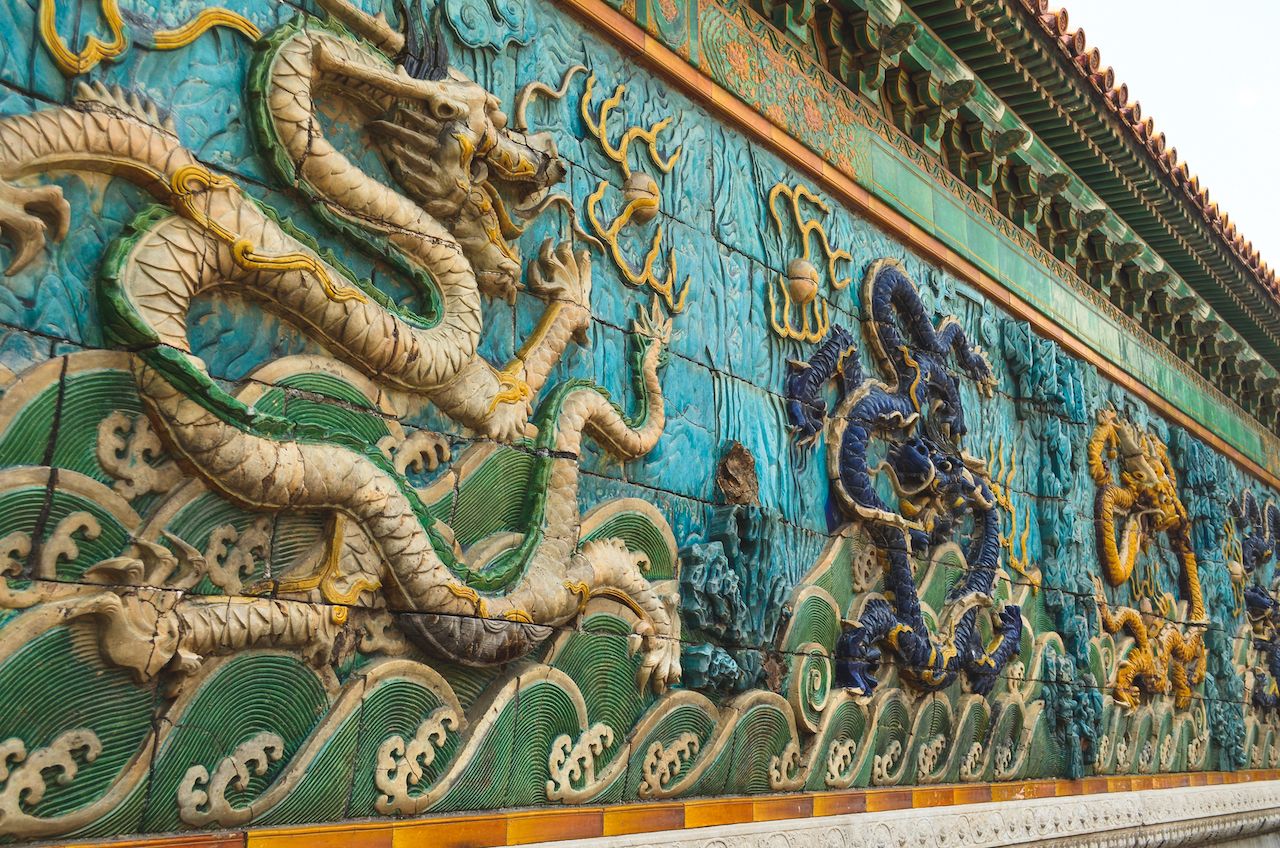
Hidden behind the thick saffron-colored walls that form the fortress stand 980 buildings that contain nearly 9,000 rooms. While most of the interior spaces are not accessible to the general public, such numbers give you an idea of the sheer size of the Palace Museum. One can easily spend a full day exploring this ancient citadel, but if that seems too much, allow yourself a bare minimum of four hours to visit.
Once you cross the main gate you can roam freely through the courtyards, however, you’ll notice immediately that the vast majority of visitors tend to follow a similar path along the central alley. The main artery of the Forbidden City travels south to north from the ticketing booths at the Meridian Gate (Wumen) toward the Gate of Divine Prowess (Shenwumen). While crowds are hard to avoid, if you don’t enjoy being part of a massive stream of people, you can choose to deviate toward either side.
The city is split between two main parts. There is the wide outer court, also known as the southern section, where official ceremonies, weddings, and military parades used to be conducted, and an inner court, or northern section, that forms the residential area where the emperors and their wives used to live. The classic route for visitors covers these two sections and can be done in about three hours.
The outer court

When entering from the Meridian Gate, you’ll find yourself in front of the Golden Water River. By crossing it on one of the five available bridges, you’ll reach the Gate of Supreme Harmony, where three palaces adorned with white-marble terraces and tiled roofs will appear in all of their majesty. The Hall of Supreme Harmony is the most impressive of the three outer court structures because of its dimensions and intricate woodwork. The Hall of Central Harmony and the Hall of Preserving Harmony are smaller, but nevertheless awe-inspiring.
The inner court
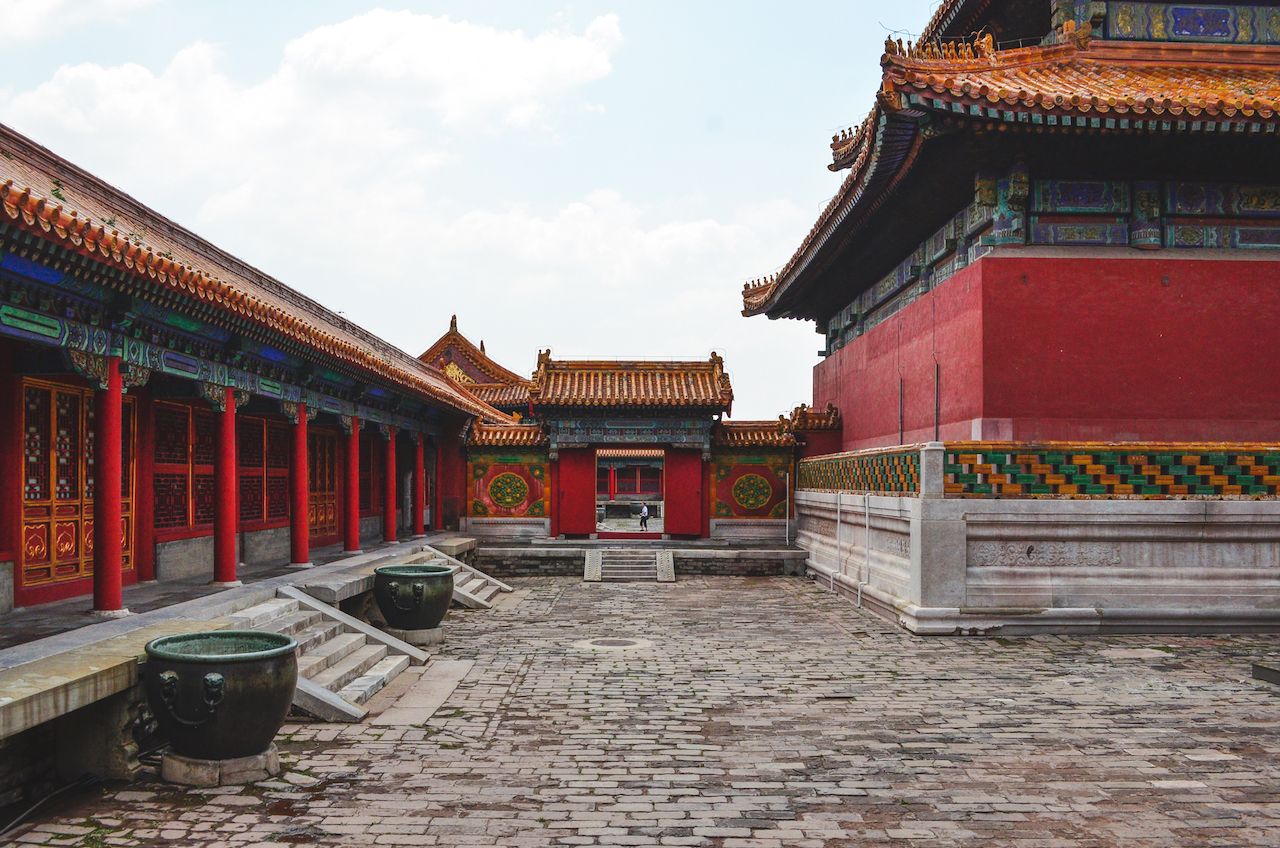
Once you enter the inner court through the Gate of Heavenly Purity, you’ll discover the Palace of Heavenly Purity, the Palace of Earthly Tranquility, and the Hall of Celestial and Terrestrial Union. These three structures have changed their function over the course of the centuries. The emperors of the Qing dynasty would use the Palace of Heavenly Purity as an audience hall, while during the Ming era it became the emperor’s official residence. Similarly, the Palace of Earthly Tranquility switched from being the residence of the empress to a space dedicated to spiritual practice. The Hall of Celestial and Terrestrial Union used to host the celebrations for the empress’ birthday. Among the most intriguing attractions of this last building is the wooden chime clock made in 1798, which has been continuously running for over two centuries.
The Treasure Gallery
Whatever you do, don’t skip the Treasure Gallery, a museum inside the Forbidden City. Located near the Palace of Tranquil Longevity, this gallery hosts a large collection of everyday objects used by the imperial families of the Qing dynasty. From clothes to jewels to daily utensils, the Treasure Gallery provides insight into what life used to be like in the Forbidden City.
The eastern and western wings
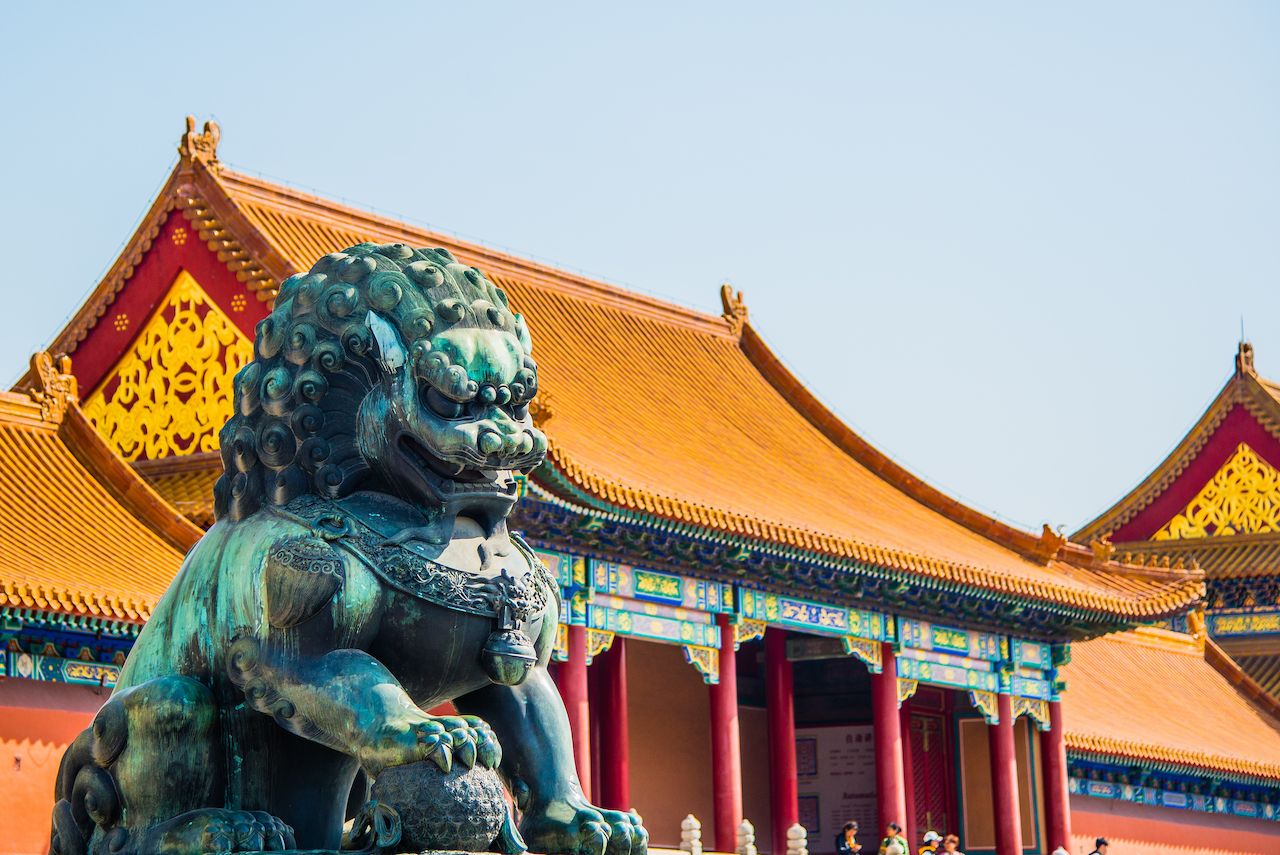
Photo: Vincent JIANG /Shutterstock
Once you’ve crossed the city through outer and inner courts, if time is on your side, extend your visit to the eastern wing, western wing, or both. The main attraction on the eastern side of the fortress are the six eastern palaces, easily reachable from the Palace of Earthly Tranquility. The Palace of Great Benevolence, the Palace of Celestial Favour, the Palace of Eternal Harmony, the Palace of Great Brilliance, the Palace of Purity, and the Palace of Lasting Happiness were completed in 1420 to house the imperial concubines. Not far from the six eastern palaces is the Palace of Tranquil Longevity, erected in 1772 by Emperor Qianlong as a place to retire after his resignation.
Mirroring the eastern wing is the western section of the Forbidden City with its own six palaces. Here you will find another residential complex meant to house the emperor’s wives and concubines, and just steps away is the Hall of Mental Cultivation built by Emperor Jiajing in the 16th century. Originally constructed as a space for the emperor to rest, the Hall of Mental Cultivation became a full-time residency of the rulers in the 18th century. Here you’ll be able to view what is considered the emperor’s “office” — a room with a throne placed behind a desk.
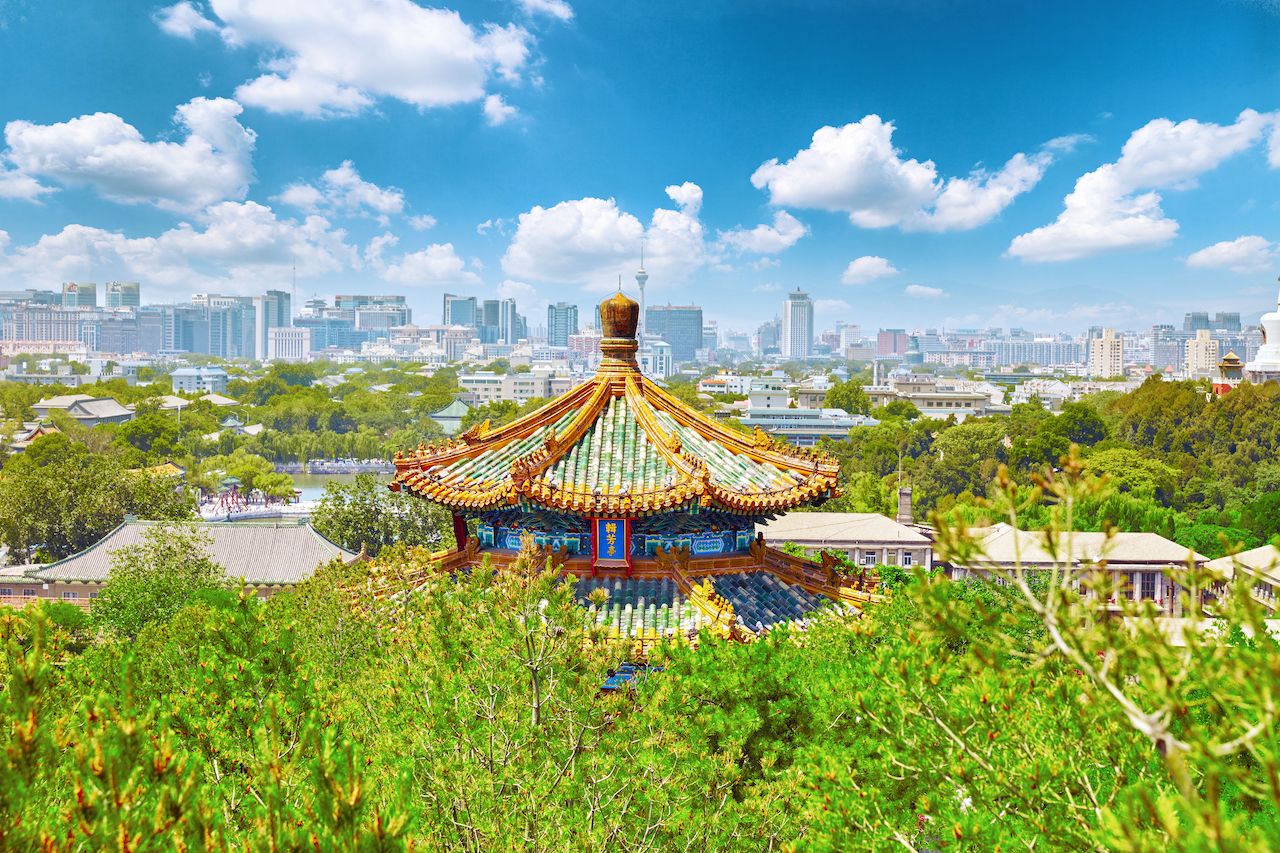
Photo: V_E /Shutterstock
If you have time at your disposal, check out Jingshan Park for incredible views over the Forbidden City. This patch of green is located on the artificial Jingshan Hill behind the palatial complex, opposite the northern gate where you exit the walls.
During the Ming and Qing dynasties, this 57-acre area used to be an imperial garden filled with fruit trees and pavilions. Jingshan Park was opened to the public in 1928, and was renovated with paved walking paths two decades later.
On top of offering stunning views of the city, the park is an ideal opportunity for a break from Beijing’s traffic.
More like this
Trending now, spain banned tourists from taking popular tiktok video of the country's most famous building, discover matador, adventure travel, train travel, national parks, beaches and islands, ski and snow.
Must-see attractions in Forbidden City & Dongcheng Central
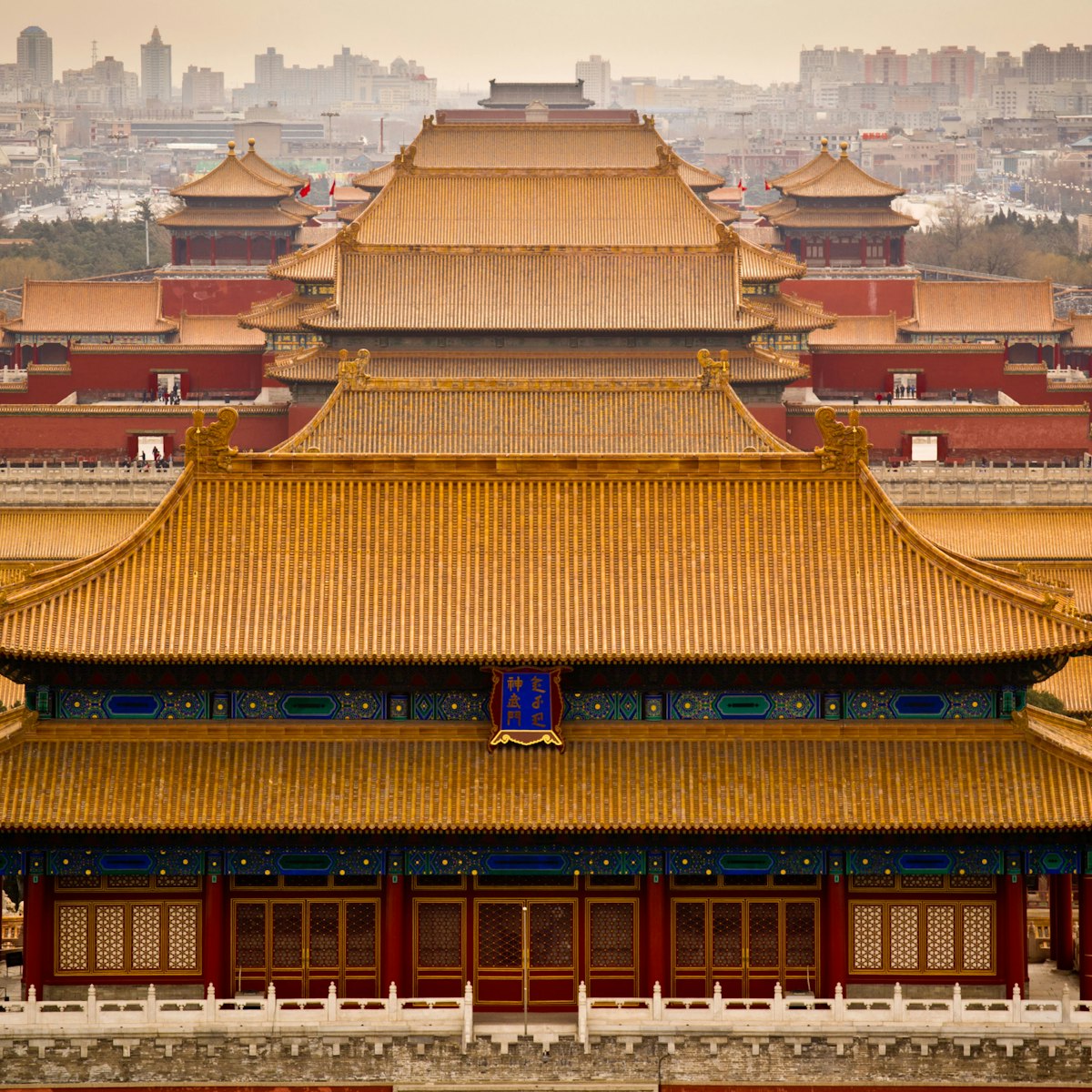
Forbidden City
Forbidden City & Dongcheng Central
Enclosed by 3.5km of citadel walls at the very heart of Beijing, the Unesco-listed Forbidden City is China’s largest and best-preserved collection of…
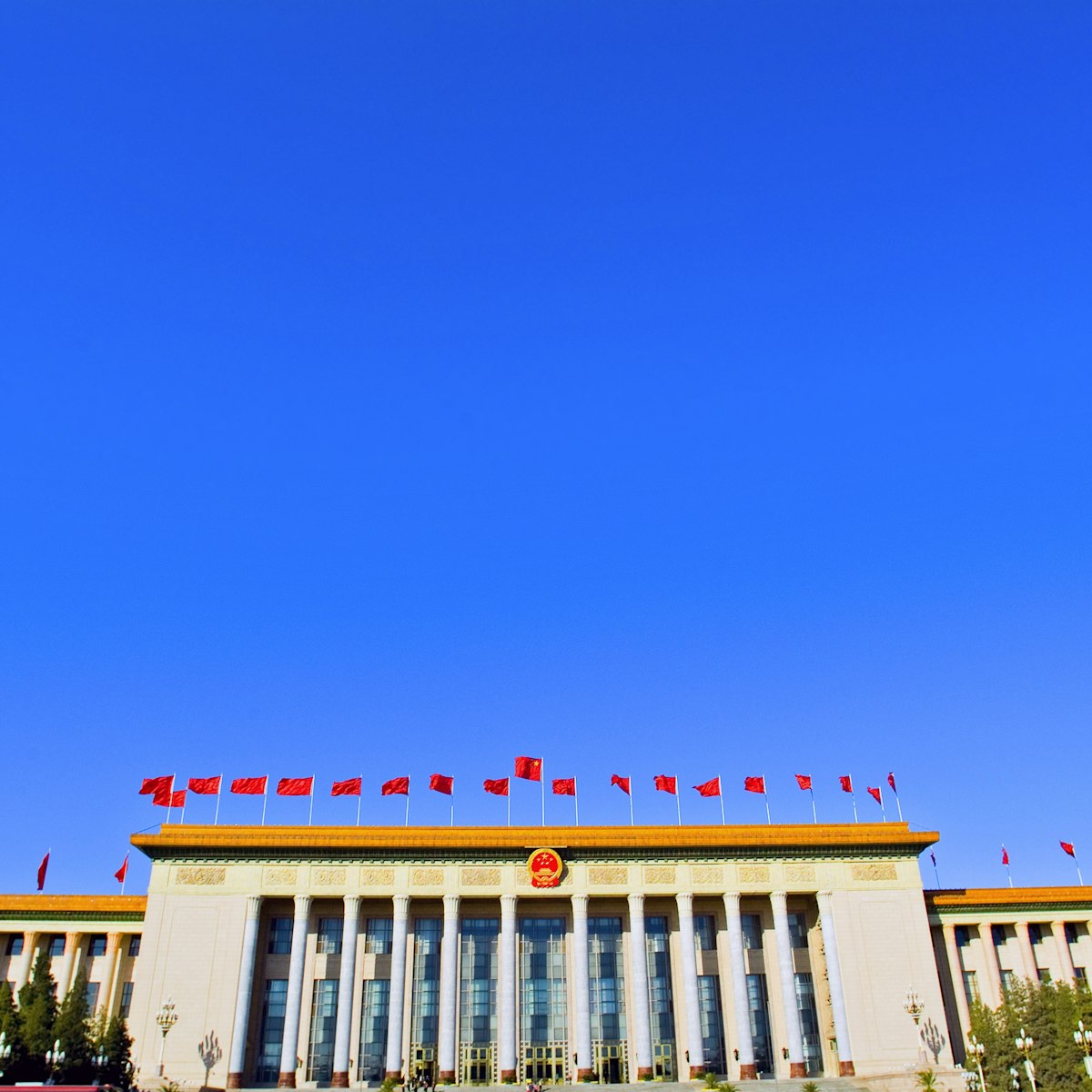
Tian'anmen Square
Flanked by triumphalist Soviet-style buildings, Tian'anmen Sq is an immense void of paved stone (440,000 sq metres, to be precise) at the symbolic centre…
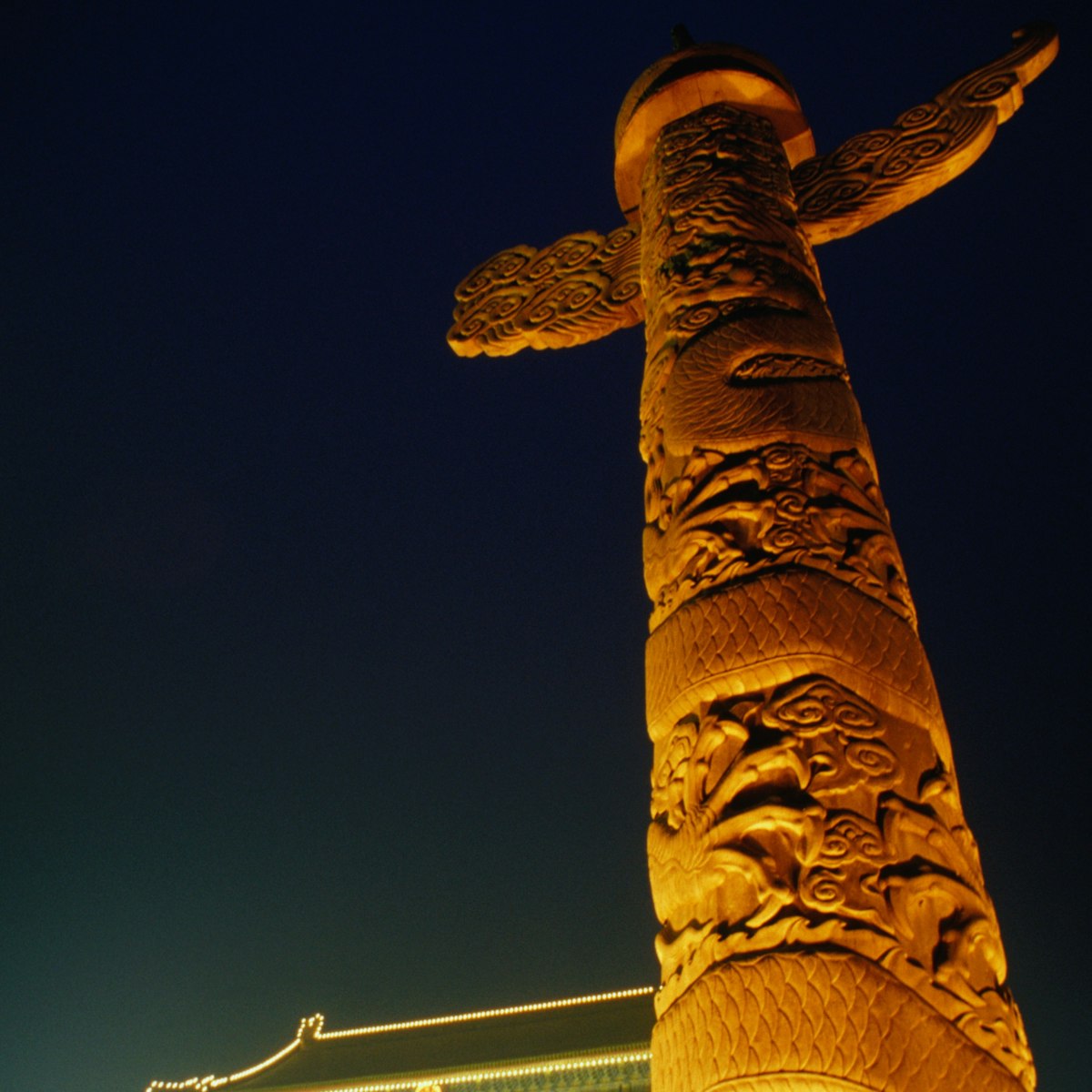
Gate of Heavenly Peace
Instantly recognisable by its giant framed portrait of Mao, and guarded by two pairs of Ming dynasty stone lions, the double-eaved Gate of Heavenly Peace …

Chairman Mao Memorial Hall
One of Beijing's more surreal spectacles is the sight of Mao Zedong's embalmed corpse on public display within his mausoleum. The Soviet-inspired memorial…
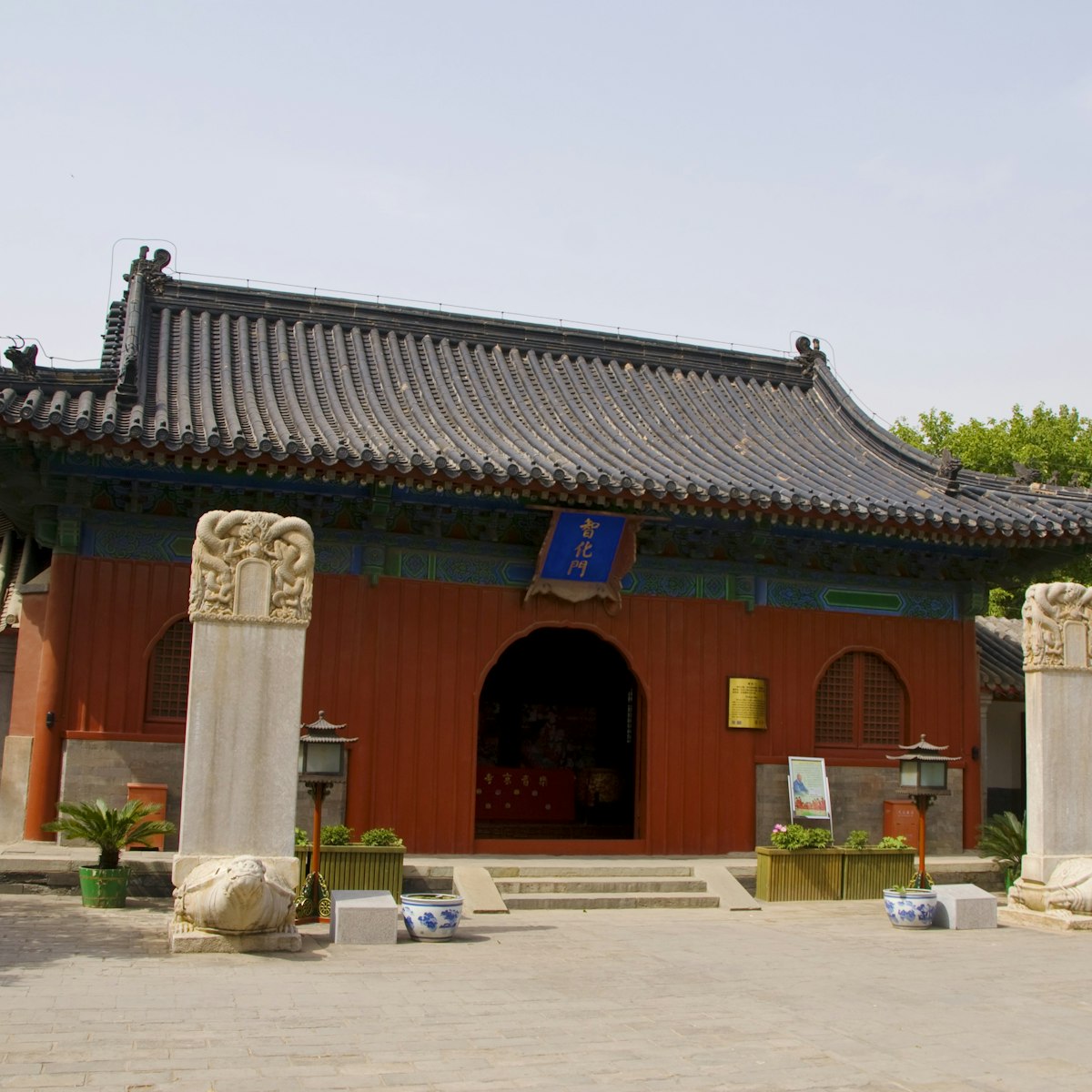
Zhihua Temple
Lost in a tumbledown hutong neighbourhood, this Buddhist temple is one of Beijing's best-preserved Ming dynasty structures. It was built in 1444 to honour…
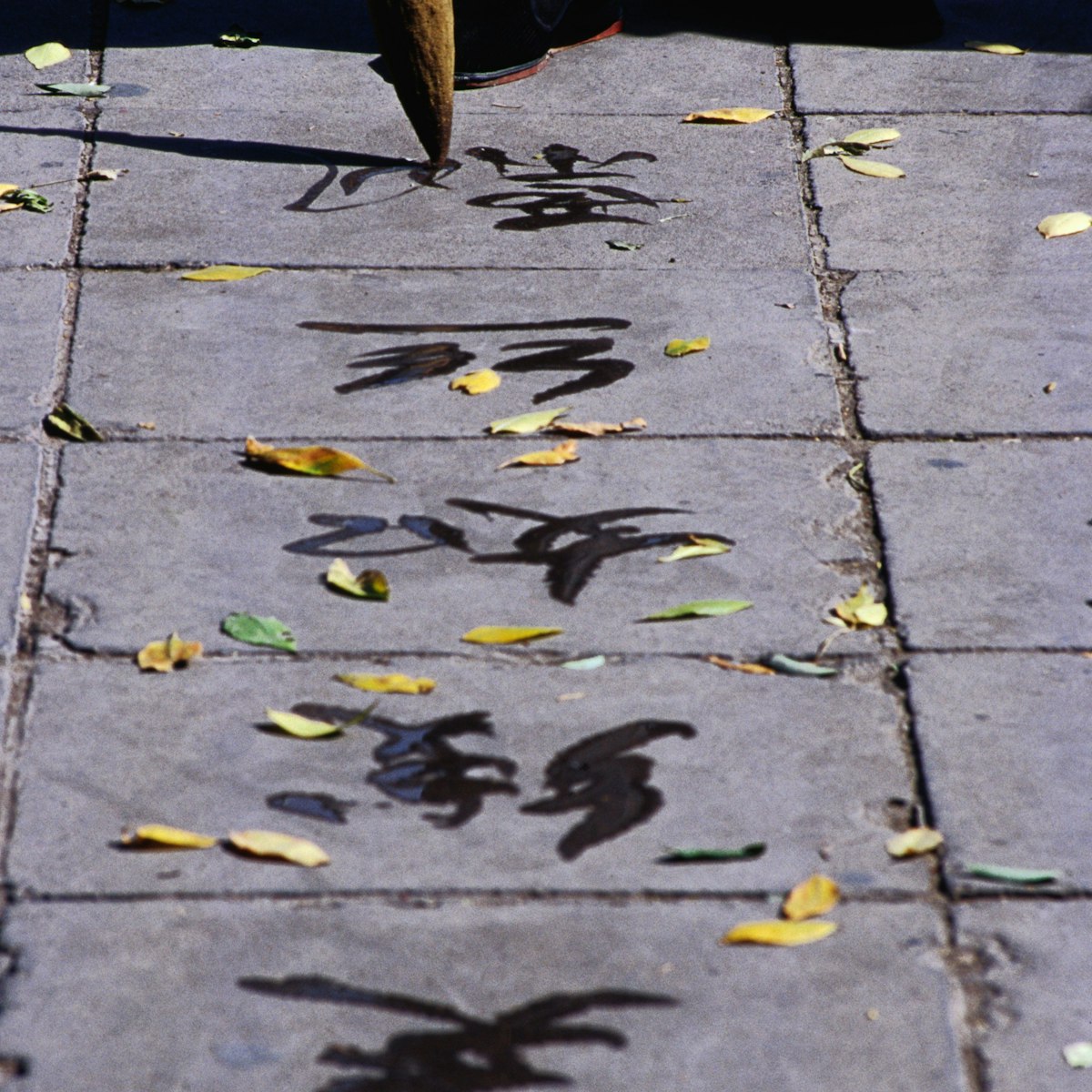
Jingshan Park
Beijing's finest park is also one of the only hills in the inner city, a mound that was created from the loess (sediment) excavated to make the Forbidden…

Workers' Cultural Palace
One of Beijing's best-kept secrets – despite being next to the Gate of Heavenly Peace – the Workers' Cultural Palace was gifted to the masses by Mao in…
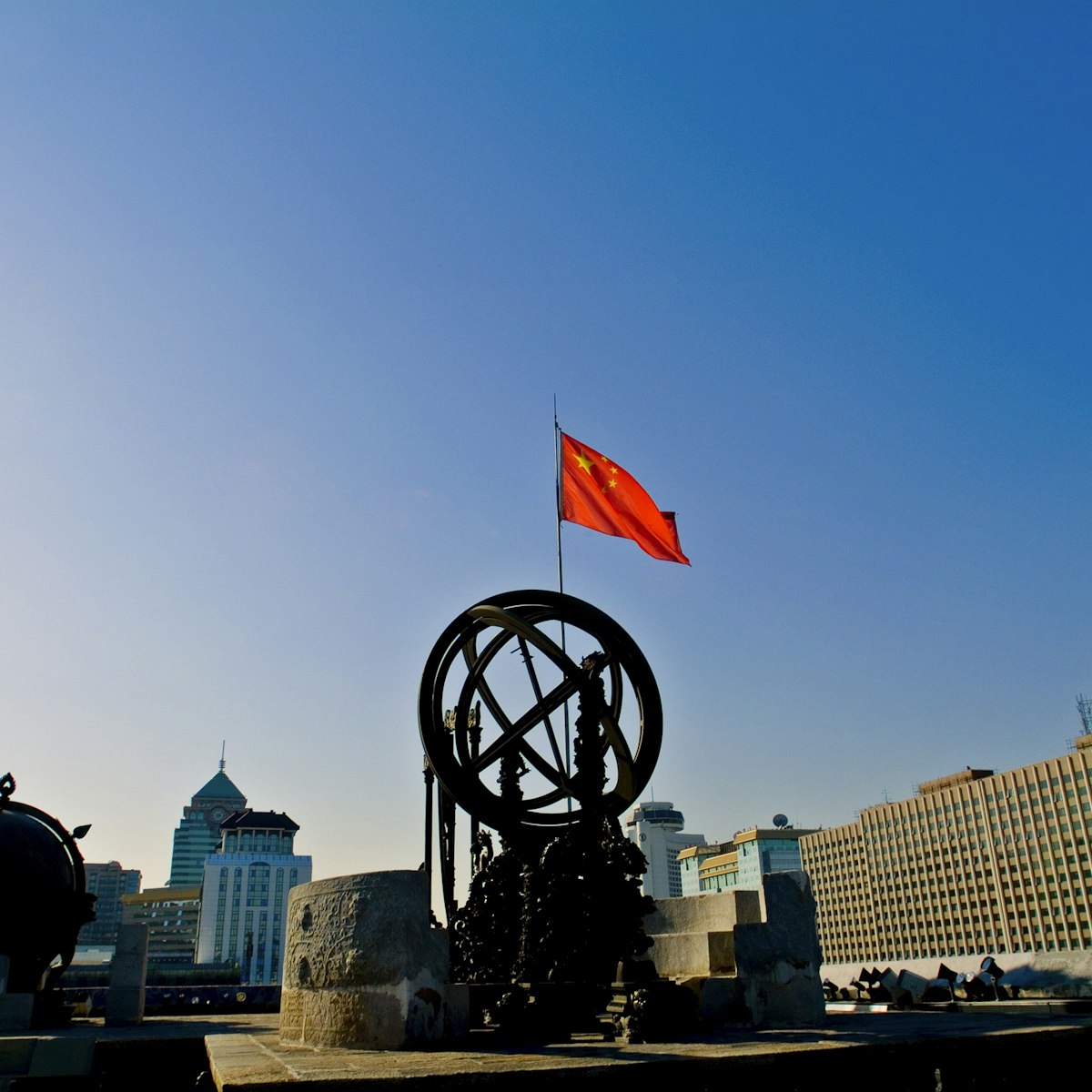
Ancient Observatory
Astronomers have been studying the mysteries of the cosmos here since 1442. Crowning the 18m-high brick tower – an earlier version of which would have…
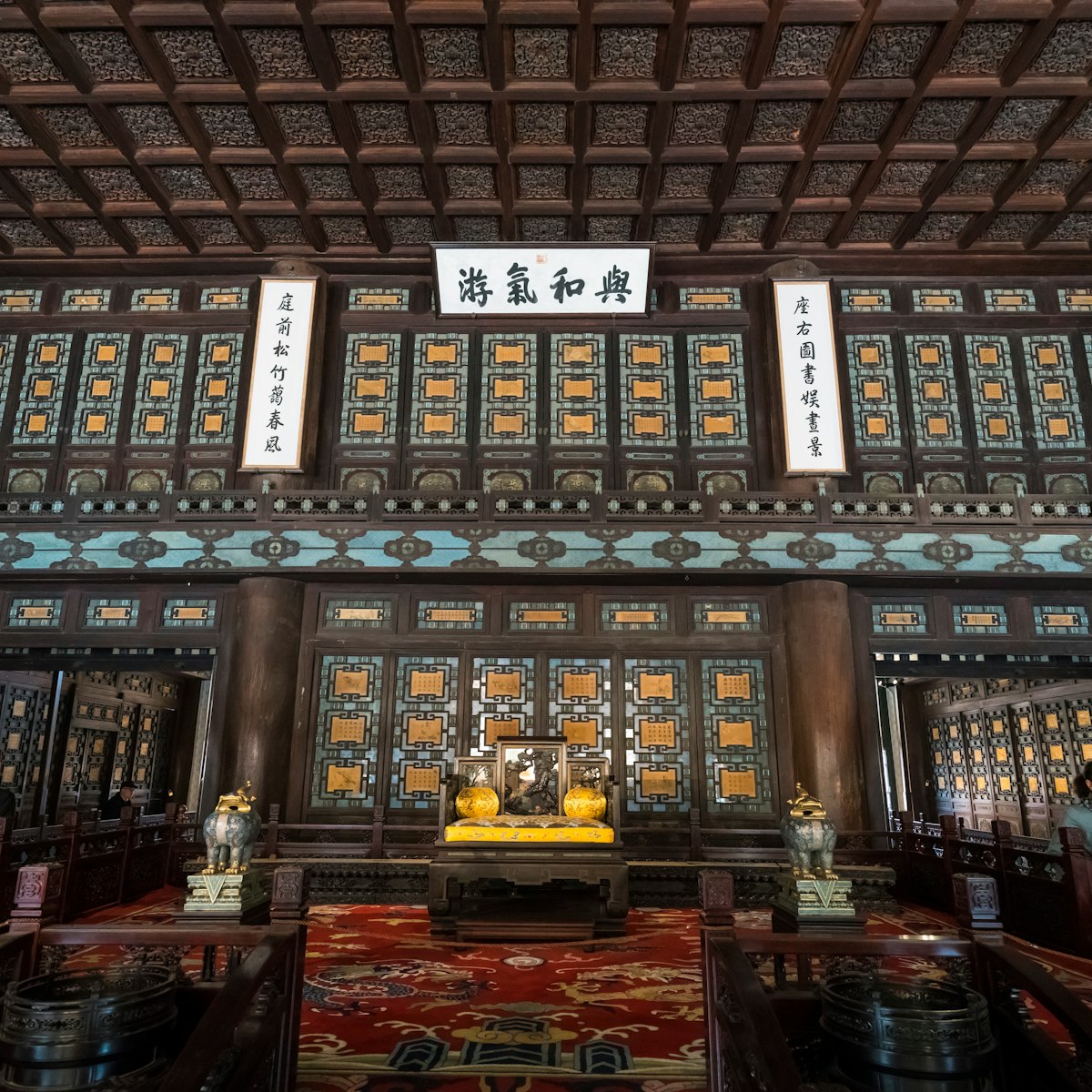
Treasure Gallery
In the northeastern corner of the complex is the Treasure Gallery (or Complete Palace of Peace and Longevity, 宁寿全宫, Níng Shǒu Quán Gōng), a…
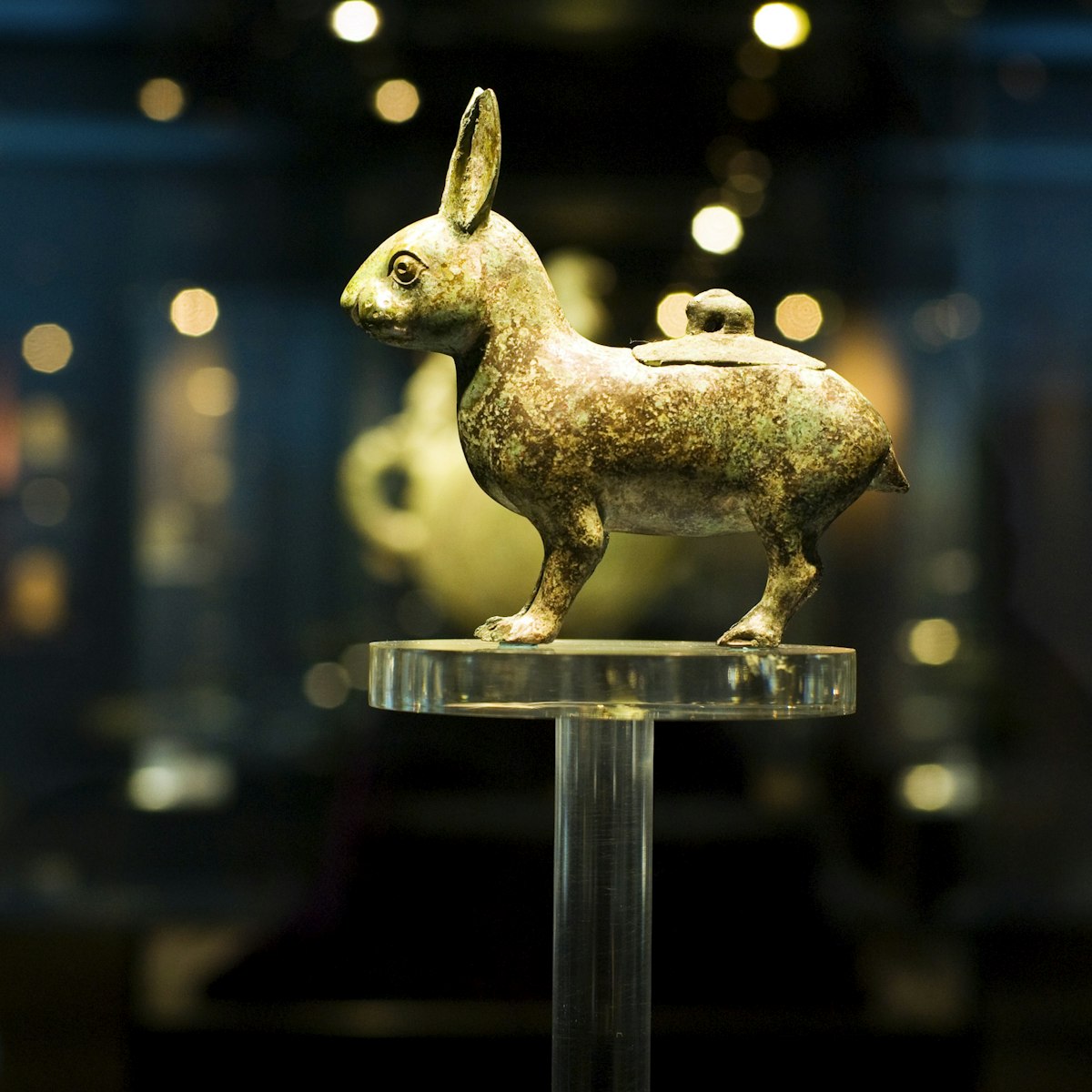
Poly Art Museum
A thrilling discovery, this exquisite collection of treasures is hidden halfway up an office building! China's state-owned Poly Group has funnelled a…
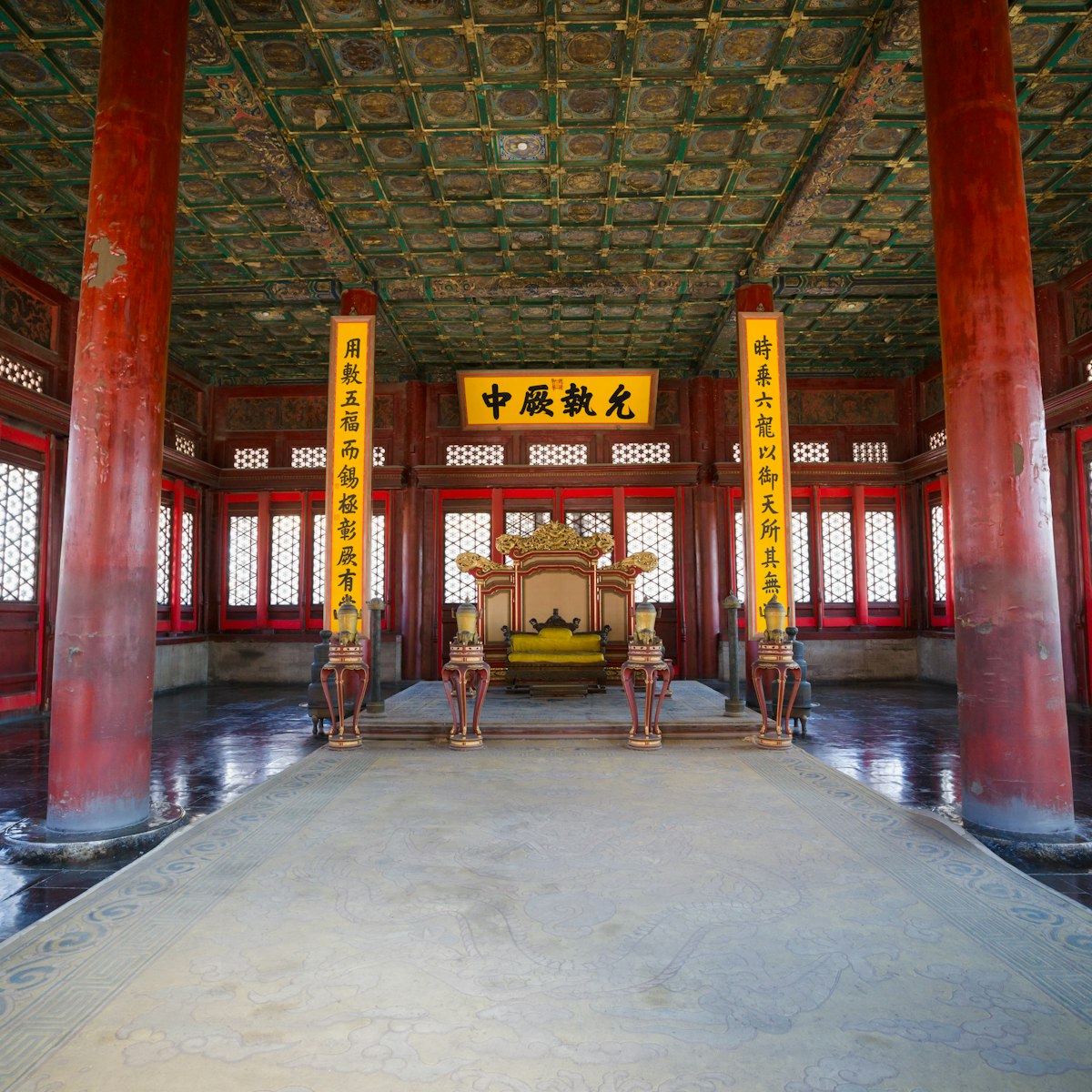
Hall of Central Harmony
Behind the Hall of Supreme Harmony is the Hall of Central Harmony, which was used as the emperor’s transit lounge. Here he would make last-minute…
Hall of Supreme Harmony
One of the Three Great Halls, this is the most important and largest structure in the Forbidden City. Built in the 15th century and restored in the 17th…
Gallery of Clocks
The Gallery of Clocks is one of the unmissable highlights of the Forbidden City. Relocated from the Hall for Ancestral Worship in 2018 (in order that the…
Sacrificial Hall
The main attraction within the Workers' Cultural Palace is the monumental Sacrificial Hall, as exquisite as any temple you'll find in Beijing. Built in…
Hall for Ancestral Worship
The hall where emperors worshipped their ancestors (under restoration at time of research). Once held the spirit tablets of deceased Qing emperors.
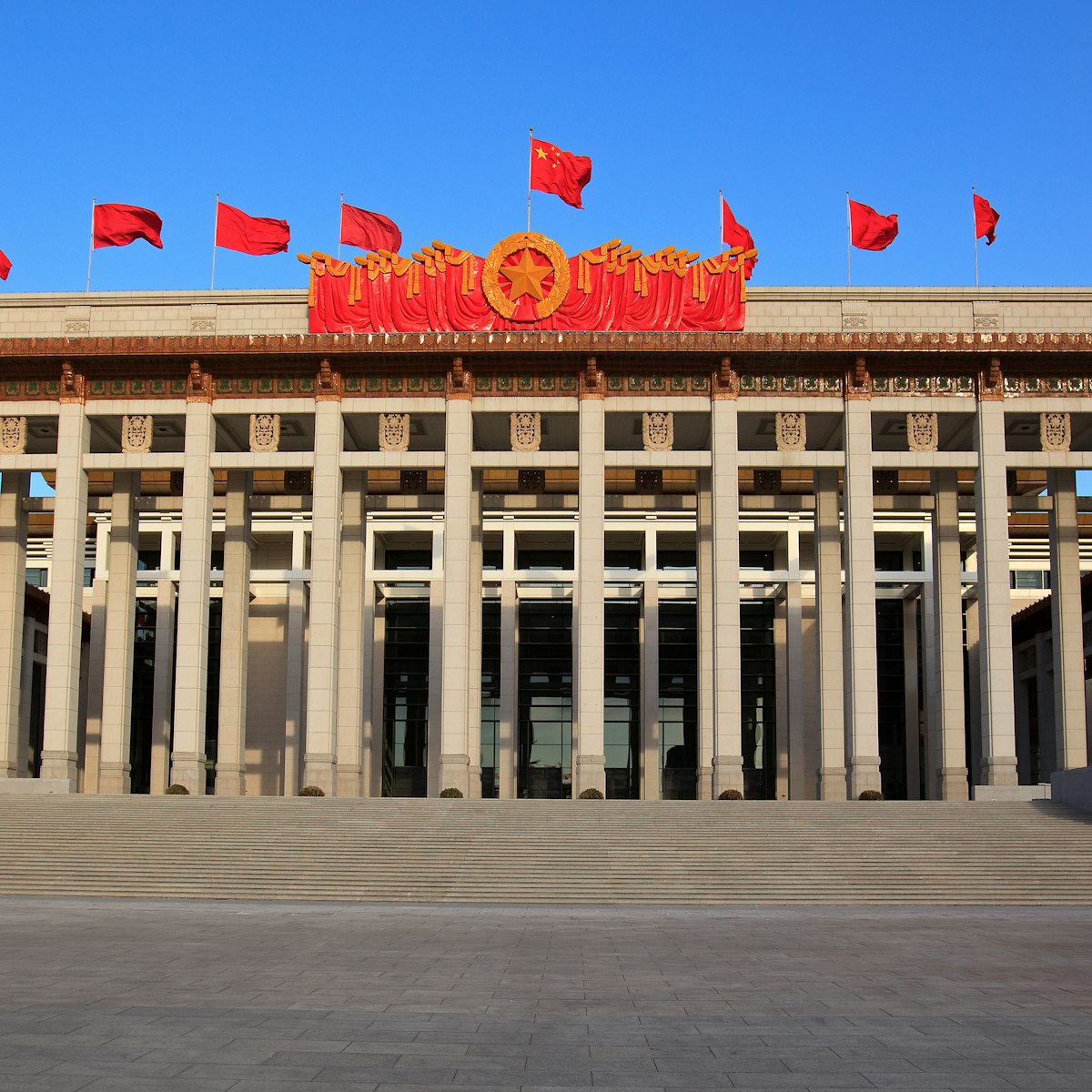
National Museum of China
Vast and energy-sapping, China's showpiece museum is housed in an immense 1950s Soviet-style building on the eastern side of Tian'anmen Sq, and claims to…
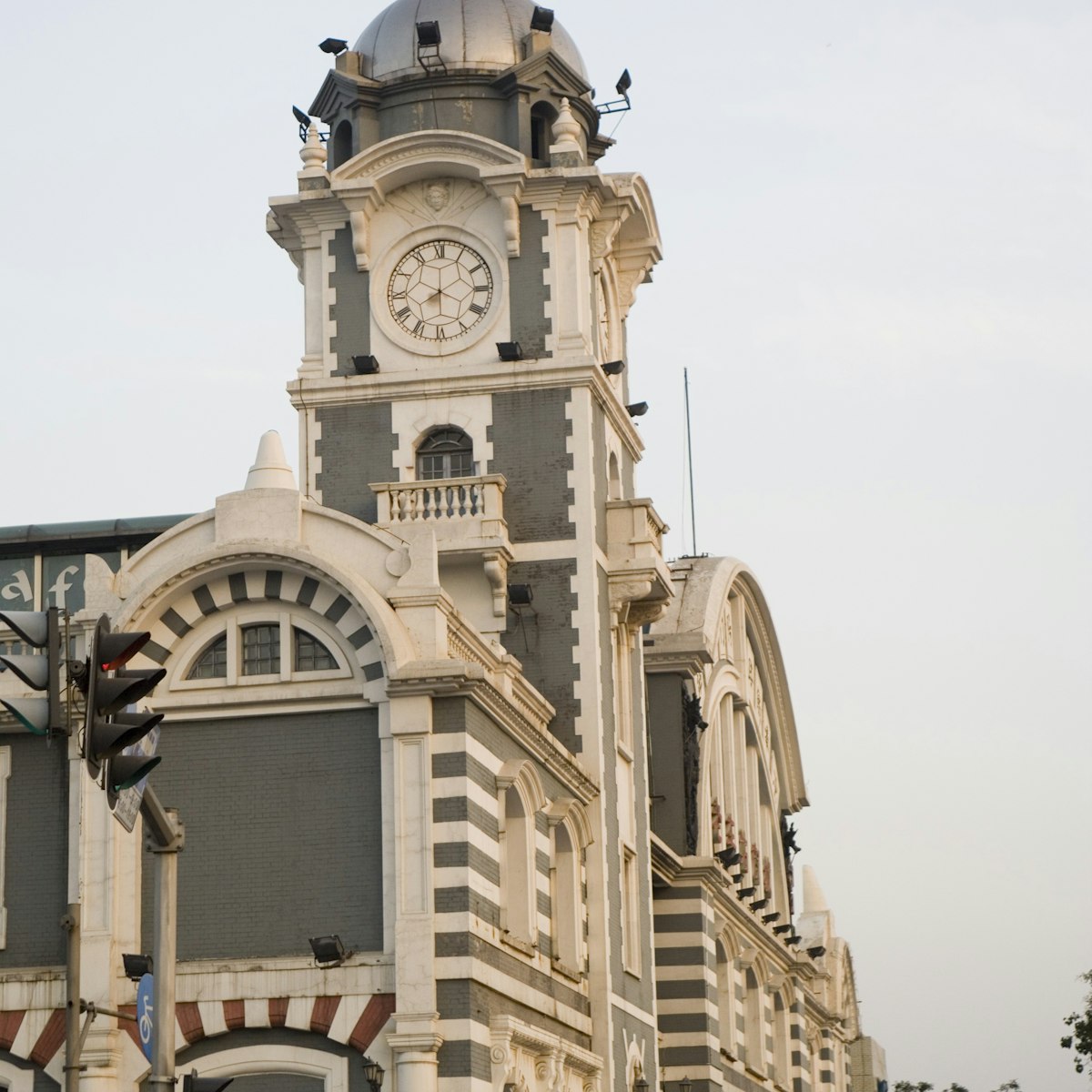
Former Legation Quarter
Following the Second Opium War in 1860, one of Britain's treaty demands was for permanent diplomatic digs in Beijing, hence the Legation Quarter, a three…
Great Hall of the People
Monolithic and intimidating, the Stalinist Great Hall of the People (1959) houses the highest organ of state power, the National People’s Congress (NPC)…

Qianmen, aka 'Front Gate', consists of a pair of gate-like structures: the northernmost is the 40m-high Zhengyang Gate, which dates from the Ming dynasty…
Zhongshan Park
Named after China's first president Sun Yatsen (alo called Sun Zhongshan), whose body was placed here briefly after his death, this lovely park, filled…
Zhengyang Gate
Qianmen (前门), or the Front Gate, consists of a pair of gate-like towers, the northernmost being the 40m-high Zhengyang Gate, which was also the largest of…
Meridian Gate
This mighty edifice is the Forbidden City's front door, where all visitors to the Palace Museum pass through. During imperial times, the central channel,…
Zhengyang Gate Arrow Tower
This is the forward-defensive structure of Zhengyang Gate, which sits behind it. The imposing building is a jiànlóu (arrow tower), which would have been…
Shouhuang Temple
A counter-narrative to Beijing's poor record of heritage preservation is that once off-limits parts of the old capital are opening to the public all the…
National Art Museum of China
Opened in 1963 with the personal endorsement of Mao Zedong, this gallery complex was conceived as the PRC's national nerve centre for artistic expression…
Nine Dragon Screen
The Nine Dragon Screen, a 5m-tall, 27m-wide spirit wall, is one of three such screens in China. It's a spectacular composition of coiling dragons picked…
Hall of Martial Valour
To the west of the Meridian Gate is the Hall of Martial Valour, well worth a detour to see what exhibition is currently installed. During the Ming dynasty…
Hall of Literary Brilliance
The Hall of Literary Brilliance complex, just to the east of the Forbidden City's entrance at the Meridian Gate was formerly used as a residence by the…
Palace of Prolonging Happiness
The most unique of the Forbidden City's six eastern palaces, the Palace of Prolonging Happiness features an unfinished 20th-century Western-style building…
Belvedere of Cheerful Melodies
This three-storey wooden opera house, built in 1776, was the Forbidden City’s largest theatre. Note the trap doors that allowed actors to make dramatic…
Hall of Preserving Harmony
The third of the Great Halls is the Hall of Preserving Harmony, used for banquets and later for imperial examinations. Descending from the rear of the…
Hall of Spiritual Cultivation
Built in 1776, the Hall of Spiritual Cultivation was intended to be used for Qing emperor Qianlong's retirement. He never moved in, although he did throw…
Altar of Land and Grain
This square, open-air altar (tán) was where the emperor would come to pray and give offerings to the gods of land and grain in return for favourable…
Hall of Imperial Supremacy
The main hall of the Palace of Tranquil Longevity (宁寿宫, Níng Shǒu Gōng) built around 1771 for Qing emperor Qianlong's retirement, though he never moved in…
Hall of Mental Cultivation
In the late Qing dynasty, the Hall of Mental Cultivation was where empress dowagers Cixi and Cian took charge of the state affairs behind a screen, when…
Imperial Garden
At the northern end of the Forbidden City is the Imperial Garden, where emperors and their consorts could retreat to read, relax, sip tea and stroll among…
Gate of Supreme Harmony
Originally built in 1420, the Gate of Supreme Harmony is the main gate of the Forbidden City's outer court. It was used by the emperor for his morning…
Three Great Halls
Raised on a three-tier marble terrace with balustrades are the Three Great Halls, the glorious ceremonial heart not just of the Forbidden City but of the…
East Prosperity Gate
The east gate of the Forbidden City, through which you can exit but not enter. Inside are exhibitions belonging to the Gallery of Historic Architecture.
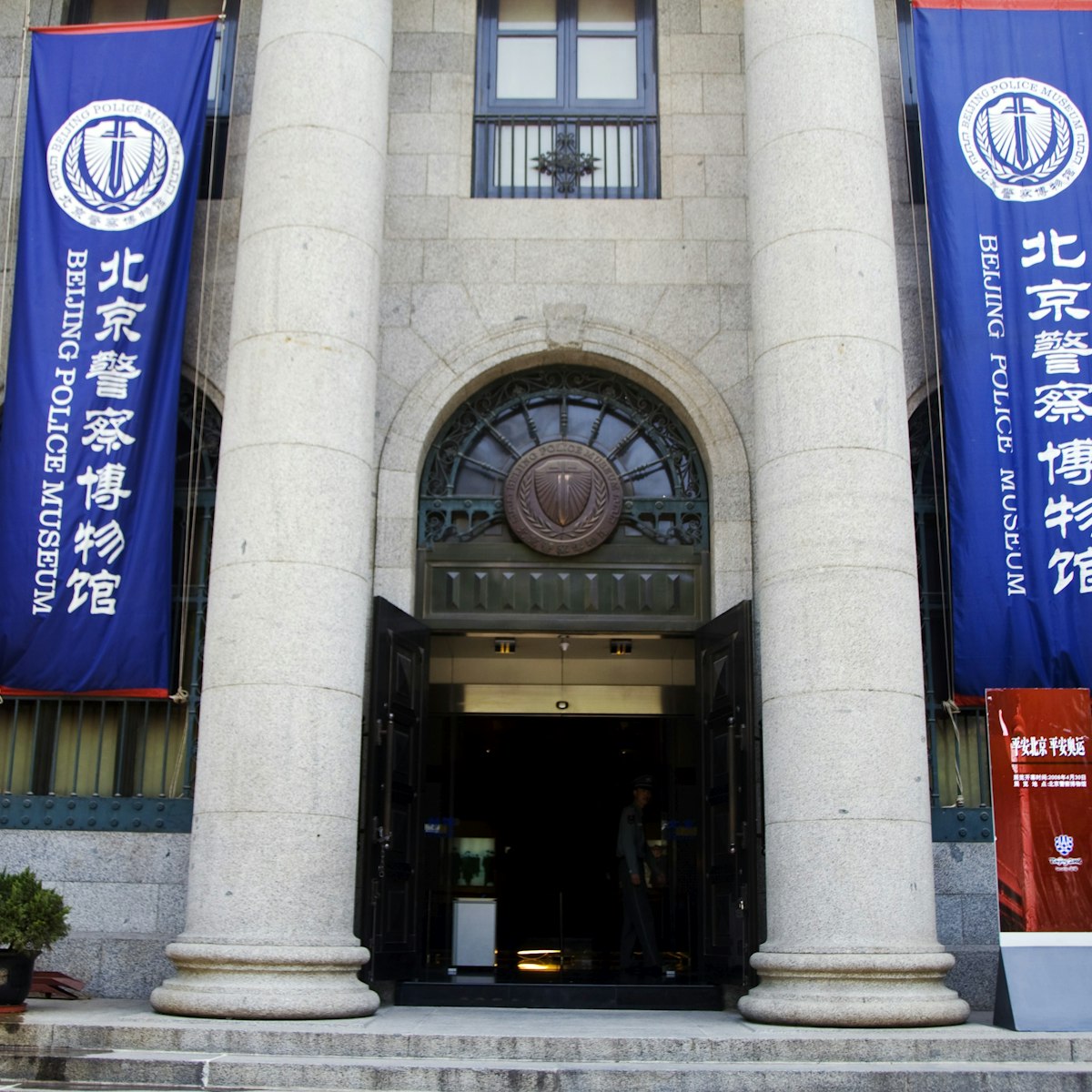
Beijing Police Museum
Propaganda notwithstanding, this is an engaging foray into the storied history of Beijing’s police force. Learn how China's first Security Bureau (PSB)…
More destinations you need to see
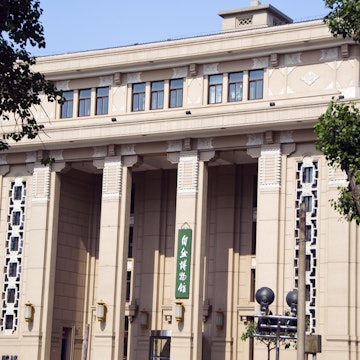
- Find a Tour
- China Tours
- Student Tours
- MICE Travel
- Destinations
- Virtual Tours
- Forbidden City Travel Tips & Tours, Beijing

Forbidden City
As the seat of power for hundreds of years, Beijing is full of examples of imperial extravagance and architectural design. In no place are these on better display than the Forbidden City, also known as the Palace Museum or gu gong in Chinese.
This immense complex, with its seemingly endless red and gold buildings, sits at the heart of Beijing and was the home of the emperors and their households, as well as the center of Chinese government, for almost 500 years, from 1420 of the Ming Dynasty to the end of the Qing Dynasty in 1912. It was declared a World Heritage Site in 1987 and is listed by UNESCO as the largest collection of preserved ancient wooden structures in the world.
Forbidden City Virtual Tour
Want to visit the forbidden city spontaneously with a professional live guide learn more about our guided virtual tour here, highlights and travel tips.
The Palace Museum is massive; it covers an area of approximately 150,000 square meters and is surrounded by a moat 3,800 meters long and 52 meters wide. The complex consists of an impressive 980 buildings, many of which are now open to the public.
Travelers must enter the Palace Museum at the South Gate. Note that before you can enter the Tiananmen area and walk through to the entrance of the Palace Museum, you will need to queue for a security check. You will need your passport to get a ticket and enter the Palace Museum. Starting from October 2, 2017, all visitors to the Forbidden City must book their tickets online. Find out how to buy Forbidden City tickets online here .
Despite its immense size, most visitors stick to the Forbidden City's central axis from the south entrance to the north exit. This route takes around two hours and allows you to take in all of the most magnificent gates and palaces, including the Meridian Gate ( wumen ), the Gate of Supreme Harmony ( taihemen ), the Hall of Supreme Harmony ( taihedian ), the Gate of Heavenly Purity ( qianqingmen ), the Palace of Heavenly Purity ( qianqinggong ), the Imperial Garden ( yuhuayuan ) and the Gate of Divine Prowess ( shenwumen ). The central axis usually attracts the most visitors and is crowded during peak hours.
Since a lot of the Forbidden City's many halls and palaces may look similar, we've provided a tourist map below to get you acquainted with some of its key sights. Simply click on the icons along the main south-north axis for more information. The complex also features good signage in both English and Chinese, and renting an audio guide will also help explain what you're seeing. If you want to make the most of your visit, we strongly recommend hiring a licensed guide to give you a thorough and informative tour of all the Forbidden City's top sights.
Tourist Map of Forbidden City
If you have more time and plan on taking any detours from the central axis, we recommend visiting the northeastern corner of the complex, called the Tranquil Longevity Sector, where the Empress Dowager and the many imperial concubines resided. Here, you'll find a well-preserved nine-dragon wall, one of just three of these ancient decorations that remain in China, as well as numerous atmospheric halls and gardens and an impressive, three-story opera house.
Another worthwhile stop is the impressive Hall of Clocks, which features lavish and intricate timepieces that were gifted to Qing emperors by various European leaders and diplomats from the 17th century on. This interesting museum (which costs 10 RMB extra to enter) can be reached by veering off to the right just after walking through the Hall of Preserving Harmony.
Depending on how in-depth you want to go, it can take up to a full day to explore all of the accessible areas in the Forbidden City. If you have a half day or full day to spend exploring the Forbidden City, you can find recommended tour routes and maps at the Palace Museum website .
If you want to beat the crowds, avoid going to the Forbidden City on weekends and Chinese Holidays, and plan your visit for the early morning or the afternoon. Learn more about how to avoid the crowds when traveling in China here .
Bring plenty of water if you are visiting during the summer or early autumn, as it gets rather hot and there is little shade inside. There are places to buy drinks and snacks inside the Palace Museum but expect touristy prices. The gift shops sell good souvenirs at fixed prices. Toilets are adequate and mainly Chinese style.
Be sure to wear comfortable shoes, as you can spend hours just walking around the complex on sometimes uneven stone courtyards.
After touring the Palace Museum, visitors must exit from the North or East Gate. There is no subway station near these two gates, so you will need to opt for a bus or taxi.
Jingshan Park is just opposite the North Gate; we recommend climbing the hill (Coal Hill) inside the park so you can get a bird's-eye view of the Forbidden City after your visit.
Accessibility Information
There is an accessible tour route for wheelchair users on the eastern side of the central courtyards. You can find the map of the wheelchair friendly route here . Following this route, visitors in wheelchairs can access all of the most magnificent palaces in the Forbidden City. Accessible toilets are also available along this route. There are map and signs showing the accessible route, and you can always ask the staff for additional information or help when you are not sure.
Beyond this accessible route, it would be difficult for wheelchair users to explore other parts of the Forbidden City, since the rest of the complex is full of stairs and high thresholds.
Limited public wheelchairs are also available for rental at no charge at the service center. A deposit of 500 CNY is required and will be returned when you return the wheelchair at the exit.
Opening Hours & Ticket Prices
Opening hours: April-October: 8:30am-5:00pm, last entry at 4:10pm / November-March: 8:30am-4:30pm, last entry at 3:40pm. Closed on Mondays. Entrance fee: April-October, 60 CNY; November-March, 40 CNY Ticket for Treasure Gallery/Hall of Clocks: 10 CNY Average time for this activity: 2 hours
Popular Tours
- 1-Day Beijing and the Great Wall tour
- 2-Day Beijing tour
- 3-Day Beijing tour
- Golden Triangle of China - 9-Day Beijing, Xi'an, Shanghai tour
- The Classic China Tour - 13-Day Beijing, Xi'an, Guilin, Yangshuo, Shanghai tour
- More Beijing tours ...
Customize a tour that includes a visit to this attraction
Inquiry form.

- [email protected]
- 86-773-286-5632 (Intl rates apply) 800-933-7181 (Free in USA & CA)
Toggle navigation
Beijing Attractions
Forbidden city.
- The Great Wall
- Map of Forbidden City
- Hall for Ancestry Worship
- Six Eastern Palaces
- Virtual Guide
- Hall of Mental Cultivation
- Palace of Tranquil Longevity
- Meridian Gate(Wu Men)
- Gate of Supreme Harmony
- Hall of Supreme Harmony
- Hall of Central Harmony
- Six Western Palaces
- Nine Dragon Screen
- Imperial Garden
- Palace of Double Glory
- Hall of Preserved Harmony
- Huge Stone Carving
- Gate of Celestial Purity
- Palace of Celestial Purity
- Hall of Celestial and Terrestrial Union
- Palace of Terrestrial Tranquility
- Tiananmen Square
- Summer Palace
- Beijing Hutong
- The Temple of Heaven
- Other Attractions
- Imperial Gardens & Mausoleums
- Temples, Monasteries & Mosques
- Shopping Streets
- Historical Relics
- Modern Beijing
- Beijing Parks
- Beijing Museums
- Activities for Kids
- Top 10 Beijing Attractions
- Former Celebrity Residences
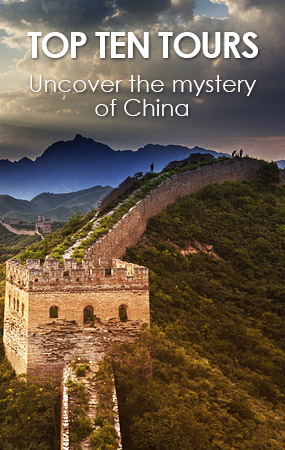
The Forbidden City sits in the central Beijing facing Tiananmen Square and has been designated as a National Palace Museum. The Forbidden City is counted as one of the world's five Palaces (the Forbidden City in Beijing, the French Palace of Versailles, Buckingham Palace, the White House and Kremlin). The palace of the Forbidden City is China 's largest and most significant ancient architectural complex with a total area of over 720 thousand square meters.
The Forbidden City is a “must see” site in Beijing with the maximum visiting numbers of visitors being up to 80,000 people per day.
The history of Forbidden City has been traced back to 1406, after Ming Emperor Zhuli seized the throne and decided to move the capital city to Beijing from Nanjing. The Emperor ordered his Beijing Palace built in style of the Palace in Nanjing. The palace had a 14 years construction period and was completed in 1420, the year of Yongle.
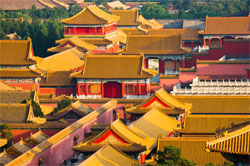
Rooms on both sides of the axis are symmetric distribution of many palaces do not lack magnificence. These rooms can be divided into two parts - the outer court and inner court.
The outer court consists of Hall of Supreme Harmony, Hall of Central Harmony and Hall of Preserve as the three main halls, Wenhua Hall and Wuying Hall are the two wings.
The inner court consists of the Hall of Celestial Purity, the Hall of Celestial and Terrestrial Union and Hall of Terrestrial Tranquility and the six rooms on the east and west for its two wings. There is a strict and orderly layout.
At the four corners of the Forbidden City lay delicate and exquisite turrets which were for observation and defense. The Forbidden City is built in a square shape, and the inner city is surrounded by 10 m high, 3400 m long wall. Outside the wall is a 52 meters wide moat.
Some of the rooms and halls in the Forbidden City have been set up as history museums, painting museums, pottery museums, bronze museum, art museum of the Ming and Qing Dynasties, the four treasures museum, watch museum and the Qing court judgments exhibition.
These museums contain a huge display a large collection of ancient art works. A total of 1,052,653 pieces are preserved in the Forbidden City, accounting for one sixth of the total number of the Chinese cultural relics. The Forbidden City is the largest history museum cultural relics in China. Many of these relics are unique and a priceless national treasure.
How to Visit The Forbidden City

The East Route: Meridian Gate → the three Hall of Taihemen→ Qianqingmen→ Six Eastern Palace → Ningshougong→ Zhenfei Well
The West Route: Meridian Gate → The Hall of Taihemen→ Qianqinggong → Yangxin Hall→ Six Western Palace
Best Time to Visit
The best time to visit Forbidden City is from late April to early June, late August to the end of November. The weather of these months is good with not too much rain. Late April to early June is spring time in Beijing. The spring blossoms in the Imperial Palace are gorgeous.
Recommended Beijing Tours including a visit of Forbidden City
The Forbidden City is the largest surviving palace complex in the world. Its ancient palatial structure has been influential in the subsequent development of Chinese architecture, as well as providing inspiration for many modern constructions. The Forbidden City is one of the must-see attractions in Beijing.
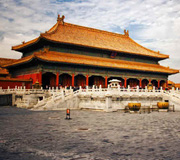
- One day Beijing Forbidden City Tour : best preserved imperial palace and the largest ancient palatial structure
- 4-day Essence of Beijing Tour : see the highlights of Beijing: the magnificent Forbidden City, the man-made world wonder - the Great Wall and old hutong alleys
- Half day Photography Tour of Corner Tower of the Forbidden City : one of the best shooting spots; inherited the flexibility of the traditional wood structure construction
Pictures of the Forbidden City
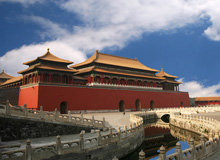
Our local experts are always ready to create you a hassle-free tour. Get an authentic experience by contacting one of our specialists. Get an authentic experience by contacting one of our specialists.
Vanessa Zheng
Tailor-made My Trip
- Skip to content

China travel guide, travel tips, attractions, & funny stuff!
The Forbidden City
B eijing’s most famous tourist attraction is the Forbidden City—where China’s emperors held court for 500 years from the 15 th century until 1911. Since the Chinese believed that the emperor was the Son of Heaven, they believed that the Forbidden City was literally at the center of the Universe (and you thought Donald Trump had a big ego).
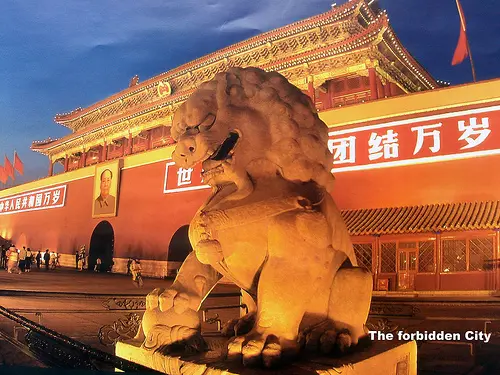
A UNESCO World Heritage Site since 1987, the Forbidden City was constructed to awe visitors and banish any doubt that this was indeed the home of the Son of Heaven. Not that there were many people to intimidate since ordinary Chinese were forbidden from even approaching the walls of the palace (hence the Forbidden Palace’s name, although today the Chinese call it Gùgōng (故宫), meaning “former palace”).
And while the immense complex—really a city within a city— sees thousands of foreign and domestic tourists daily, it’s so massive that you can easily find a secluded pavilion to recharge your batteries in peace.
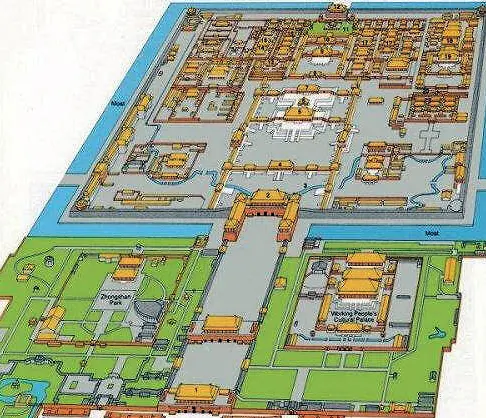
Guarded by a 170-foot wide moat and 30-foot high walls, the 183-acre site is a vast complex of buildings, halls, pavilions, and marble courtyards. The complex consists of almost 1,000 buildings and over 8,000 chambers, which housed an estimated 8,000-10,000 maids and other servants. Believe it or not, many servants (and even some emperors) lived their ENTIRE lives within the walls of the Forbidden City! And you thought your boss was stingy about vacation days.
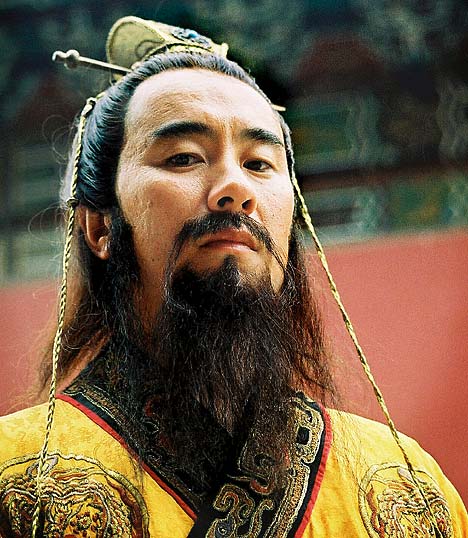
In addition to having a platoon of different wives, China’s emperors also had literally thousands of concubines available to serve them. Some would pick out a name from a silver tray and the lucky concubine would be delivered to his chambers (in your face, Hugh Hefner!). To ensure that the emperor was the only dude doing the impregnating, the only other males allowed inside his inner sanctum were his army of eunuch-servants (amazingly, it was considered a great honor to become a castrated member—pun intended—of the emperor’s court). Eunuchs would deliver concubines to the emperor’s bedchamber on their backs (since they could barely walk with bound feet). I’d imagine Tiger Woods would not have been eagerly invited to an overnight slumber party.
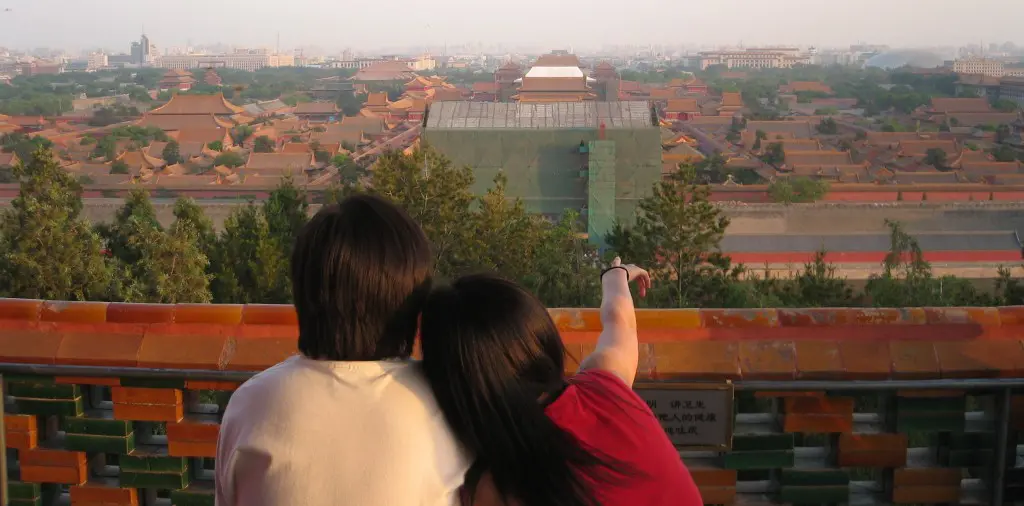
More Info & History
After deciding to move the imperial capital back to Beijing (from Nanjing in the south), the legendary Ming emperor Zhu Di ordered the construction of the Forbidden City in 1406. The scale of construction was epic, taking more than a million workers over 15 years to finish. As with the building of the Great Wall of China, hundreds of thousands were forcibly uprooted from towns and villages around the country and sent to Beijing.

To feed and accommodate the influx of people in the new capital, the emperor ordered the Grand Canal —first constructed in the late 5 th century—to be extended all the way north to Beijing. In other words, around the time that Europe descended into the Dark Ages, China was building a canal that would link Beijing to Hangzhou, some 1,000 miles to the south. And yet today, for some reason they can’t manufacture a radio that lasts more than a week.
The Forbidden City, like the rest of Beijing, was constructed in a grid pattern accordance to feng shui principles . The most important structures were built on a north-south axis—facing south to provide protection from negative yin influences such as cold winds, wandering ghosts, and barbarian invaders.
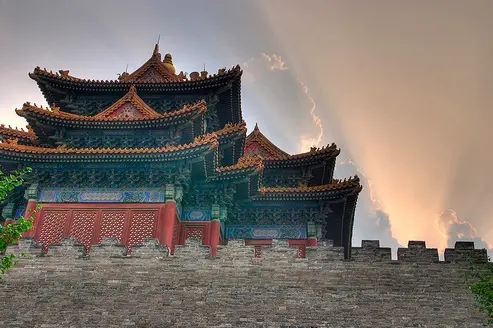
Speaking of barbarian invaders, some years back a Starbucks controversy started brewing over a small store inside the Forbidden City. A Chinese journalist started a grass-roots campaign to close down the location—demonizing it as a symbol of the insidious way Western influences are corrupting Chinese culture. Soon the Chinese media caught wind and Starbucks eventually closed down the store in 2007. (On an unrelated note, I’m starting a boycott of the Panda Express in the food court of the US Capitol. But mostly because it taste like crap).
Many of the 24 emperors who lived in the Forbidden City rarely ventured beyond its walls, except for the occasional trip to the Temple of Heaven, the Summer Palace, or Mountain Resort for some R&R. After seeing the sheer size of the place, it’s easy to see how they became disconnected from the real China. Living in their safe, little (okay, big) bubble, the last Chinese emperors were blind to the country’s problems until Western powers were literally blasting their way into China’s ports.
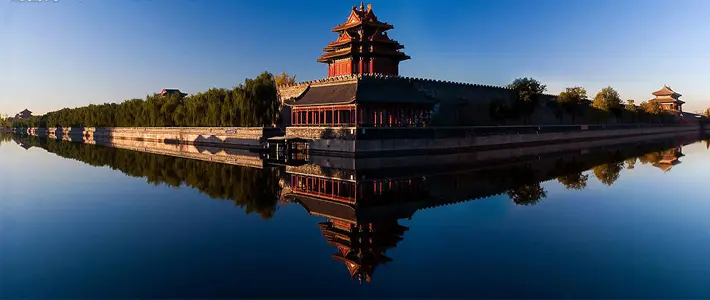
One famous symbol of this myopic mismanagement is the “Marble Boat,” which is still on display at a lakeside pavilion in the Summer Palace. At a time when China should’ve been scrambling to defend itself against the Western powers, the powerful but clueless Empress Dowager Ci Xi ordered an expensive restoration of the Marble Boat in 1893, by diverting funds that were earmarked for building a royal Navy (doh!). Naturally, no one dared to disagree with her brilliant plan for fear of having their head lopped off. Oh, and this was the same empress who would commonly order over 100 dishes for a single meal that reportedly could’ve fed thousands of starving peasants outside the palace walls.
Today, the Forbidden City’s imposing main gateway looks over Tiananmen Square — where Chairman Mao’s painting was famously pelted with eggs during the student uprising. And although fires and looting over the years have left the Forbidden City as a shadow of its former glory days, it’s still a pretty damn impressive shadow and a must-see tourist attraction.
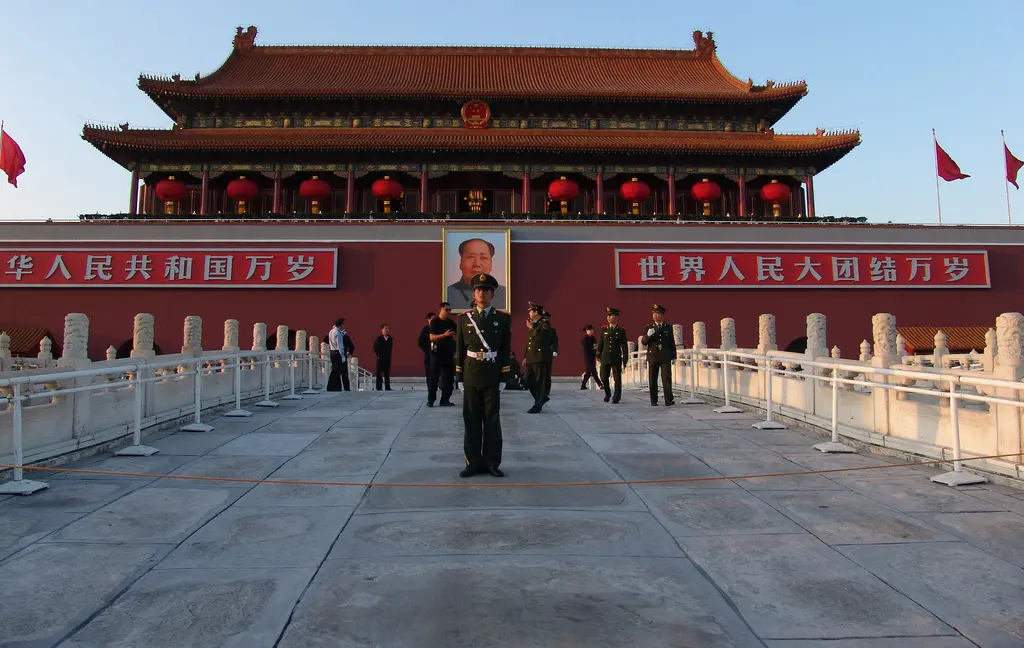
China Travel Resources
Are you looking for quality China travel resources? Check out this breakdown of my favorite travel tips and resources.
- Tours >
- Destinations >
- Things to do in Asia >
- Things to do in China >
- Things to do in The Forbidden City
Now you can find, compare, and share trips from 1,000+ operators and expert trip planners. Unlike most travel agencies and websites that only show options from large companies that pay big commissions, we show you all the options we can gather, and we’re adding more all the time. We want you to have all the available information to find your perfect trip, no matter who it’s with. Whether you’re looking for a short weekend getaway or a multi-country expedition, you can find it on Travelstride. About us.

...to foster a community connecting travelers to wonderful places, people, & experiences. Learn more.
Best Things to Do in The Forbidden City
The forbidden city, unlock community benefits.
- Save favorite trips and itineraries
- Get insider insights
- Receive personalized recommendations ...and much more
Top The Forbidden City Tours See all
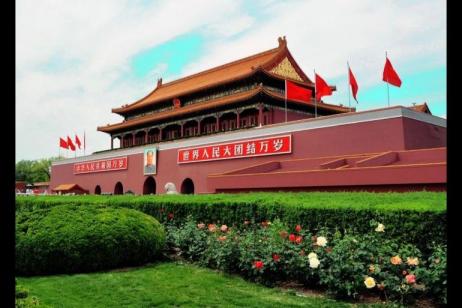
Want a tailor-made trip instead?
- You choose budget, destinations, activities, transport & lodging type
- Expert designs the itinerary for you, and once approved, takes care of logistics
Top The Forbidden City Travel Packages
The forbidden city tours reviews & ratings, travelstride featured in.
Top The Forbidden City Tour Companies
- G Adventures Reviews
- Explore! Reviews
- Trafalgar Reviews
- Discover Corps Reviews
- Uniworld Reviews
- On The Go Tours Reviews
- Peregrine Adventures Reviews
- Insider Journeys Reviews
- WildChina Reviews
- Tauck Reviews
- Great Value Vacations Reviews
- Audley Travel Reviews
- Butterfield & Robinson Reviews
- Viking River Cruises Reviews
- Senior Discovery Tours Reviews
- Cox & Kings - the Americas Reviews
- Europamundo Vacations Reviews
- China Links Travel Reviews
Why Travelstride
Click to send a new magic link to your inbox.
Welcome back!
By signing in, you agree to our Privacy Policy and Terms of Use
- Bookmark trips you like
- Share with your travel companions
- Track price changes
- Access private discounts on trips you save
TripFinder is a member-only feature. Dont worry, its free!
With a membership you:
- Save up to $700 per person!*
- Access private deals and offers
- See personalized trip recommendations
- Save favorite trips
Just use the email address and password provided in the email we sent.
With your free membership you:

The Forbidden City is located at the core of Beijing's central axis. It is one of the largest and best preserved ancient wooden structures in the world. As a world cultural heritage site, the Forbidden City has become a unique symbol of Chinese civilization, and one of the must-see attractions for foreigners coming to Beijing.

A tourist's photo in the Forbidden City [Photo by George Doupas from Greece]

Photo within the Forbidden City [Photo by Eric Marie Favreliere from France]

Gate of Supreme Harmony (Taihemen) [Photo by Ramesh Negi from India]

- Search Please fill out this field.
- Manage Your Subscription
- Give a Gift Subscription
- Newsletters
- Sweepstakes
- Attractions
- Landmarks + Monuments
The World's Most-visited Tourist Attractions
Since 1971, Travel + Leisure editors have followed one mission: to inform, inspire, and guide travelers to have deeper, more meaningful experiences. T+L's editors have traveled to countries all over the world, having flown, sailed, road tripped, and taken the train countless miles. They've visited small towns and big cities, hidden gems and popular destinations, beaches and mountains, and everything in between. With a breadth of knowledge about destinations around the globe, air travel, cruises, hotels, food and drinks, outdoor adventure, and more, they are able to take their real-world experience and provide readers with tried-and-tested trip ideas, in-depth intel, and inspiration at every point of a journey.
For nearly 500 years, the emperors living within Beijing's opulent Forbidden City dictated who could enter and leave. Well, the gates have opened, and tourists are pouring in to see it all for themselves. Attendance is up by 2.5 million since 2010.
The Forbidden City is a dream destination for some Americans, but most have never researched a trip to Everland or Lotte World. Yet these South Korean theme parks also rank among the world's 50 most-visited tourist attractions—beating out the Eiffel Tower (nearly 7 million), the Great Pyramids (4 million), and Stonehenge (1 million). And there are more surprises.
Where we choose to spend our vacation time says a lot about what we value. Despite—or perhaps because of—what the World Tourism Organization (UNWTO) calls "global economic challenges," more travelers are hitting the road than ever. International tourist arrivals increased by five percent in 2013, according to the UNWTO. That translates to a record of more than one billion trips. With its population of 1.36 billion, China has become the second-largest exporter of tourists. Russia, now the fifth-largest outbound market, increased travel spending by 26 percent.
Like it or not, theme parks clearly have worldwide appeal. France's Disneyland Park draws about the same number of visitors (10.5 million) as Sacré Coeur, and four of the world's 20 most-visited tourist attractions are Disney parks.
Many inspiring and iconic places can't quite keep up. The Smithsonian National Air and Space Museum narrowly missed the top 50, as did the British Museum in London (6.7 million), the Metropolitan Museum of Art in New York (6.3 million), and the Roman Colosseum and Forum (5.1 million each). The Berlin Wall Memorial Site logged only 500,000 visitors in 2013, though extra crowds arrived in November 2014 for the 25th anniversary of its fall.
Accessibility can be a factor. It takes extra effort to reach Yellowstone National Park (3.2 million) or the Terracotta Army in Xi'an, China (4.8 million). And Peru's Machu Picchu has restricted tourism to help maintain the site's integrity; only 2,500 can enter per day, or 912,500 per year.
So what is the most-visited tourist attraction in the world? And can 91 million people be wrong? Read on to see the results—and an explanation of our methods for calculating it all.
Julie Bang/Travel + Leisure
The Methodology: To tally up the world's most-visited attractions, we gathered the most recent data supplied by the attractions themselves or from government agencies, industry reports, and reputable media outlets. In most cases, it was 2013 data. Attractions that don't sell tickets gave us estimates as best they could.
We defined "tourist attractions" as cultural and historical sites, natural landmarks, and officially designated spaces. So Boston's shop-filled Faneuil Hall Marketplace (est. 1742) made the cut, but not Minnesota's Mall of America, which, with 40 million annual visitors, would otherwise have tied for No. 4. Short walkways and plazas also fit our definition of tourist attractions; that disqualified the Blue Ridge Parkway. We also omitted beaches, bridges, and sites that draw almost exclusively religious pilgrims.
Reported by Kate Appleton, Rich Beattie, Adrien Glover, Lyndsey Matthews, April Orcutt, Joshua Pramis, and Ann Shields
No. 1 Grand Bazaar, Istanbul
Annual Visitors: 91,250,000
Hand-painted ceramics, lanterns, intricately patterned carpets, copperware, gold Byzantine-style jewelry, and more eye-catching products vie for your attention within this 15th-century bazaar's vaulted walkways. It has since expanded and become increasingly touristy, but locals, too, are among the millions of bargain hunters. To haggle like a pro, lowball your starting offer and don't be afraid to walk away. And if it all gets overwhelming, break for a succulent doner kebab or strong cup of Turkish coffee.
Source: Grand Bazaar management
No. 2 The Zócalo, Mexico City
Jorge Castro/Travel + Leisure
Annual Visitors: 85,000,000
Formally known as the Plaza de la Constitución, the enormous Zócalo thrums with activity. It hosts military parades, cultural and political events, concerts, exhibitions, fairs, and public art installations. Metropolitan Cathedral and the National Palace flank this historic public square, and an imposing Mexican flag, raised and lowered daily, waves over the scene.
Source: Mexico Tourism Board
No. 3 Times Square, New York City
Annual Visitors: 50,000,000
Tourists flock to New York 's neon heart for the flashing lights, Broadway shows, megastores, and sheer spectacle—including costumed characters eager to pose for photo ops. Pedestrian-only areas with café tables introduced a few years ago have made it easier and more appealing to hang out here. Times Square can even be a convenient, if chaotic, base, thanks to hotels at every price point and easy access to public transportation: subways, rails, buses, and more yellow taxis than you can count.
Source: The Times Square Alliance
No. 4 (tie) Central Park, New York City
Annual Visitors: 40,000,000
New York has larger green spaces, but none is more famous than Central Park , which stretches across nearly 850 acres of prime Manhattan real estate—an oasis for both tourists and locals. You can ride in one of the horse-drawn carriages, check out the modest-size zoo, climb to the top of 19th-century Belvedere Castle, or take a break from pounding the pavement to sprawl on the Great Lawn, gazing at the skyscrapers above.
Source: Central Park Conservancy
No. 4 (tie) Union Station, Washington, D.C.
Opened in 1907, this busy station shuttles some 12,500 passengers daily in and out of Washington, D.C. But it also handles millions of tourists who pass through to take in the impeccably mixed architectural styles throughout the colossal building: from Classical to Beaux-Arts to Baroque. More than 70 retail outlets make Union Station a shopping destination, and it's also a jumping-off point for many D.C. tours.
Source: Union Station
No. 6 Las Vegas Strip
Annual Visitors: 30,500,000
In 2013, 77 percent of Vegas tourists—30.5 million—chose to stay at hotels right on the four-mile-long Strip. And why not? Roll out of bed and onto the Strip to catch the Bellagio fountains in action, shop, gamble, and, of course, people-watch (which can get especially fun later at night). For a cool new vantage point, hop aboard the High Roller , a 550-foot-tall Ferris wheel that debuted in March 2014. It's part of Linq, a flashy 300,000-square-foot shopping and entertainment complex by Caesars.
Source: Las Vegas Convention and Visitors Authority
No. 7 (tie) Meiji Jingu Shrine, Tokyo
Annual Visitors: 30,000,000
Built more than 100 years ago to honor the divine souls of Emperor Meiji and Empress Shoken, this Shinto shrine in bustling Tokyo is a peaceful haven surrounded by a holy forest of more than 100,000 trees. Seasonal gardens feature spring azaleas, summer irises, brilliant autumn leaves on Japanese maples and ginkgos, and black pines dusted with winter snow.
Source: Japan National Tourism Organization (JNTO)
No. 7 (tie) Senso-ji Temple, Tokyo
Tokyo's oldest temple was dedicated to the Bodhisattva Kannon, the most compassionate Buddha, in 628. Dramatic nighttime illumination highlights vermilion and crimson detailing in the Five-Storied Pagoda. Continuing centuries-long tradition, stalls along the temple's Nakamise Street sell food and goods to pilgrims, whose numbers swell around New Year's.
No. 9 Niagara Falls, New York and Ontario
Annual Visitors: 22,000,000
Straddling the border of the U.S. and Canada, three massive waterfalls, together called Niagara Falls , spill about 6 million cubic feet of water—from a maximum vertical drop of 165 feet—every minute. While there are about 500 taller waterfalls in the world, Niagara Falls is spectacular for its sheer power. It's also more accessible than many major falls, a short flight or drive for millions of regional tourists.
Source: Niagara Tourism & Convention Corp./Canadian Tourism Commission
No. 10 Grand Central Terminal, New York City
Annual Visitors : 21,600,00
Unlike harried commuters, visitors take their time in the main concourse of this Beaux-Arts landmark , pausing to view its glittering ceiling painted with a map of the constellations from the night sky. Shops, an annual holiday market, special events, and restaurants also attract attention. Two of the grandest venues are the Campbell Apartment, serving craft cocktails, and the historic Oyster Bar —featured on AMC's Mad Men —which shucks 2 million fresh bivalves a year.
Source: Grand Central Terminal
No. 11 Basilica of Our Lady of Guadalupe, Mexico City
Annual Visitors: 20,000,000
The Old Basilica , begun in the 16th century and completed in 1709, stands in stark contrast to the massive new basilica, designed by the Mexican architect Pedro Ramírez Vázquez, which was built in the mid-1970s and looks like a sports arena. It is, in fact, intended to hold 50,000 people, who come for mass—celebrated several times a day—and to see an image of the Virgin Mary that is said to have appeared on an apron in 1531.
No. 12 Disney World's Magic Kingdom, Orlando, FL
Annual Visitors: 18,588,000
The Most Magical Place on Earth is high on virtually every family's to-do list and remains the most-visited theme park on the earth. Expanded Fantasyland now includes the Seven Dwarfs Mine Train family-style roller coaster and a chance to meet Anna and Elsa from the smash-hit Frozen in the Princess Fairytale Hall near Cinderella Castle. Time-tested attractions include the Jungle Cruise and Space Mountain, the daily Disney character parade down Main Street, USA, and a fireworks spectacular that lights up the sky many nights.
Source: TEA/AECOM Global Attractions Attendance Report
No. 13 Faneuil Hall Marketplace, Boston
Annual Visitors: 18,000,000
Dating back to 1742, Faneuil Hall ("the Cradle of Liberty") once hosted speeches by such greats as Samuel Adams and George Washington. Today, the downtown marketplace has more than 100 specialty shops and eateries and occupies a pedestrian-only, cobblestoned area that swarms with tourists and street performers. Each winter, Faneuil Hall also hosts Boston's tallest Christmas tree, along with festive light displays and choirs.
Source: Faneuil Hall Marketplace
No. 14 Tokyo Disneyland
Annual Visitors: 17,214,000
Disney's Tokyo outpost has become the second most-visited theme park in the world (beating out Anaheim, CA's Disneyland, which held that title in 2010). It shares the sweetness of the original parks' Fantasyland with Peter Pan's Flight and Dumbo the Flying Elephant as well as Tomorrowland's Space Mountain and Star Tours—The Adventures Continue. A musical soundtrack and other renovations have improved the Adventureland classic: Jungle Cruise Wildlife Expedition, while a new after-dark night cruise promises more surprises.
No. 15 Disneyland Park, Anaheim, CA
Annual Visitors: 16,202,000
Though not as massive as its Orlando counterpart, the original Disney park , which occupies about 85 acres of land, has retro charm and some better features. Here the Pirates of the Caribbean attraction lasts almost twice as long and ends in a humid southern bayou with fireflies (instead of a gift shop). The Indiana Jones Adventure ride careens over lava, past swarms of beetles, and under that 16-foot rolling boulder. Thrill-seekers will also appreciate that the Big Thunder Mountain Railroad has reopened.
No. 16 Forbidden City, Beijing
Annual Visitors: 15,340,000
It doesn't have a street address—which is only fitting for a place that was once considered the center of the universe. Nowadays, tourists swarm this 178-acre walled compound of opulent halls, gardens, and winged pavilions. Attendance is up by 2.5 million since 2010. It can easily take half a day to explore the grounds, and history buffs will appreciate the self-guided audio tour—or a hired guide.
Source: Forbidden City Palace Museum and China Odyssey Tours

No. 17 Golden Gate National Recreation Area, San Francisco
Annual Visitors: 14,289,121
Beaches, cliffs, hills, forts, and towering redwood trees make up the Golden Gate National Recreation Area , easily accessible from San Francisco. Many visitors come to embrace the outdoors, whether hiking, biking, swimming, birding, riding horses, or whale-watching. But this scenic area is also rich in history and includes landmarks like Alcatraz prison and the Presidio, an 18th-century military post. You can even base yourself within the recreation area; Cavallo Point's rooms and suites occupy restored turn-of-the-20th-century Colonial Revival buildings that overlook San Francisco Bay .
Source: National Park Service
No. 18 Tokyo DisneySea
Annual Visitors: 14,084,000
DisneySea , the companion park to Tokyo Disneyland overlooking Tokyo Bay, took inspiration from aquatic myths, legends and the lore of the sea. Divided into seven "ports of call," the park emphasizes water attractions with Venetian gondolas, a Mermaid Lagoon, a journey to 20,000 Leagues Under the Sea and an Aquatopia with quirky boats in a sea of rocks, whirlpools and water spouts. But it's not all fountains and bubbles—the park also has scary rides like the Tower of Terror, Journey to the Center of the Earth, and Indiana Jones Adventure: Temple of the Crystal Skull.
No. 19 Notre Dame Cathedral, Paris
Annual Visitors: 14,000,000
A masterpiece of Gothic architecture—all soaring buttresses, crouching gargoyles, and magnificent rose windows— Notre Dame has survived attacks of Huguenots, sansculottes, occupying armies, and questionable renovations since its completion in 1345. In spite of its often violent past, visitors flock to the cathedral for the hushed peace and reflection it provides, even in the midst of Paris.
Source: Atout France, the France Tourism Development Agency
No. 20 Golden Gate Park, San Francisco
Annual Visitors: 13,000,000
Cascading three miles from the Panhandle down to the Pacific, Golden Gate Park serves as playground and haven for this diverse city. The park's offerings include museums (the de Young Museum and the Academy of Sciences), botanical wonders (the Conservatory of Flowers, the Japanese Tea Garden, a rhododendron forest, and more than 75,000 trees, among others), sporting fields and courts, playgrounds, and even a small herd of buffalo.
Source: San Francisco Recreation & Park Department
No. 21 Balboa Park, San Diego
Chelsea Loren/Travel + Leisure
Annual Visitors: 12,000,000 to 14,000,000
Balboa Park's 1,200 acres form a mini-city with 15 accredited museums, 19 gardens, nine performing arts groups, a miniature railroad, a golf course, tennis courts, lawn bowling, a gymnasium, a historic carousel, and a Super Sonic Samba School. Not to mention the world-famous San Diego Zoo , with three crowd-pleasing giant pandas. Balboa Park also features the Spreckels Organ, whose 4,518 pipes range from the size of a pencil to 32 feet tall.
Source: Balboa Park
No. 22 South Street Seaport, New York City
Annual Visitors: 12,000,000
This 12-block historic East River site in Lower Manhattan dates back to the 1600s, and its cobblestoned streets are packed with shops and restaurants. Pier 17 will reopen in 2016 after undergoing extensive renovation. Commercialism aside, the history runs deep here and is perhaps best experienced on one of the two 1800s tall-masted schooners the South Street Seaport Museum maintains. Go for a sunset sail with Gotham as a backdrop.
Source: The Howard Hughes Corporation
No. 23 San Antonio River Walk, San Antonio, TX
Annual Visitors: 11,500,000
Cypress-lined cobble-and-flagstone paths meander for four miles along both sides of the narrow San Antonio River. Locals and visitors come to the River Walk's horseshoe-shaped loop downtown to browse shops and hang out at restaurants like Boudro's for a prickly-pear margarita and guacamole prepared tableside. The Museum Reach river walk section stretches an additional 1.7 miles north, past art installations under every bridge and the San Antonio Museum of Art.
Source: San Antonio River Walk (Paseo del Rio)
No. 24 Epcot, Walt Disney World Resort, Lake Buena Vista, FL
Michela Sieman/Travel + Leisure
Annual Visitors: 11,229,000
Built to honor the late Walt Disney's utopian ideal of the innovative future (the name is an acronym for Experimental Prototype Community of Tomorrow), Epcot attracts guests who skew a little older than those of its neighbor, the Magic Kingdom. Restaurants are aimed at more sophisticated palates, and annual celebrations include a flower and garden show and an international food and wine festival. Perennial favorite rides like Soarin', Mission: SPACE, and The Seas with Nemo & Friends keep the kids and kids-at-heart happy. Expect visits to the Norway pavilion to spike when a Frozen -themed ride debuts in 2016.
No. 25 St. Peter's Basilica, Vatican City, Italy
Annual Visitors: 11,000,000
One of the holiest Catholic sites, St. Peter's Basilica teems with ornate gold, marble columns, paintings of angels, iconic statues, and works created by a who's who of Renaissance artists, including Raphael, Brunelleschi, Bernini, and Michelangelo, who sculpted the marble Pietà and designed the massive dome. For a nominal fee, you can climb 320 steps to the top and soak up the most famous panorama of Rome.
Source: Italian Government Tourist Board
No. 26 Great Wall of China
Annual Visitors: 10,720,000 (Badaling and Mutianyu areas combined)
Once used as a wartime defense, the Great Wall winds "like a dragon tail" from eastern China to western, spanning some 5,500 miles. While much of what is visible today was built during the Ming dynasty (1368–1644), construction began on various sections as far back as 770 B.C. Credit goes to the million slaves and prisoners of war who carried blocks of granite, bricks, stones, and dirt on their backs up to the top of the ridgelines. The Badaling section, closest to Beijing, draws the biggest crowds. Word has gotten out, inspiring some travelers to make the longer drive to the more serene Mutianyu section.
Source: National Tourism Administration of the People's Republic of China and China Odyssey Tours
No. 27 Sacré Coeur Basilica, Paris
Taylor McIntyre/Travel + Leisure
Annual Visitors: 10,500,000
Sacré Coeur lures visitors to the summit of Montmartre for a litany of reasons—while some come to pray and meditate, most come for the remarkable 360-degree views of the City of Light from its highest vantage point. The construction of the basilica, which started in 1871, was intended to restore peace to a site stained by violence during the Paris Commune.
No. 28 Disneyland Park, Marne-la-Vallée, France
Annual Visitors: 10,430,000
When Disney's first European theme park opened in 1992, many French protested the "cultural imperialism" of such an American symbol opening 40 minutes outside of Paris. Today it's one of the most-visited locations in Europe. So be prepared to queue for popular rides like It's a Small World, Space Mountain, Big Thunder Mountain, Pirates of the Caribbean, and Buzz Lightyear Laser Blast. A 3D ride inspired by the film Ratatouille opened in 2014; enter through a replica of Gusteau's restaurant.
No. 29 Disney's Animal Kingdom, Walt Disney World Resort, Lake Buena Vista, FL
Annual Visitors: 10,198,000
Since 1998, this animal-themed park has successfully marketed Mickey Mouse and silverback gorillas under one all-inclusive "roof." If it has four legs or wings or a tail, chances are you'll find it at this zoo/museum/school theme park. Don't miss the Kilimanjaro Safaris, Expedition Everest, or the 14-story Tree of Life sculpture carved with some 325 animals. Fun fact: at one point park creators also wanted to include a section for mythological creatures called "Beastly Kingdom."
No. 30 Disney's Hollywood Studios, Walt Disney World Resort, Lake Buena Vista, FL
Annual Visitors: 10,110,000
Disney describes this park (est. 1989) as " the Hollywood that never was and always will be ." Laid out much like a real-life motion picture studio, with a 154-acre network of streets and buildings and miniature replicas of famous landmarks, it showcases the golden age of film. But most kids make a beeline to Toy Story Midway Mania! at Pixar Place and Star Tours—The Adventures Continue.
No. 31 Universal Studios Japan, Osaka, Japan
Annual Visitors: 10,100,000
Opened in 2001 and a near twin to its Orlando sibling—albeit one with more sushi— this popular movie theme park is one of four operated by Universal in Japan. Highlights include a Jaws -like shark encounter, Jurassic Park roller-coaster ride, Sesame Street in 4-D, and now the Wizarding World of Harry Potter. Interesting fact: investment banking firm Goldman Sachs is the park's largest shareholder.
No. 32 Hollywood Walk of Fame, Hollywood, CA
Annual Visitors: 10,000,000 to 12,000,000
Nothing says Hollywood like the (literally) star-studded Walk of Fame , with each star bearing the name of a celebrity with enough cachet to be immortalized on the street. That means stars from James Dean and Marilyn Monroe to, more recently, Tina Fey and Neil Patrick Harris.
Source: Los Angeles Tourism & Convention Board
No. 33 Pike Place Market, Seattle
Annual Visitors: 10,000,000
One of the oldest continually operating farmers' markets in the U.S. (est. 1907), this nine-acre National Historic District is famous for kitschy Seattle souvenirs, salmon-throwing fishmongers, and its "gum wall" installation art. The many seafood restaurants include Market Grill and Emmett Watson's for oysters. It's just down the street from one of the original Starbucks—complete with an early-edition logo featuring a more, er, risqué mermaid.
Source: Pike Place Market
No. 34 Great Smoky Mountains National Park, North Carolina and Tennessee
Annual Visitors: 9,345,695
Originally Cherokee homeland, America's most-visited national park first opened in 1940 and covers some 520,000 acres of protected Tennessee and North Carolina forestland that's bisected by the Appalachian Trail. Whether hiking Chimney Tops (or any of the 800 miles of trails) or driving the super-scenic U.S. Highway 441, visitors are sure to get an eyeful of the mystical haze that inspired the park's name. To escape the crowds, park ranger Caitlin Worth recommends heading to Balsam Mountain Road, a high-elevation gravel road accessible from the southern end of the Blue Ridge Parkway.
No. 35 Musée du Louvre, Paris
Annual Visitors: 9,334,000
The world's largest museum is both the subject of ongoing architectural controversy—not everyone agrees with the 1989 addition of I. M. Pei's 69-foot-high glass pyramid entrance—and an art-lover's wonderland of some 35,000 masterworks. Throngs parade through the former 12th-century palace to see such famous highlights as Leonardo da Vinci's smiling La Gioconda , a.k.a. Mona Lisa —a painting that, rumor has it, was originally commissioned by François I to hang in his château at Fontainebleau . And the crush of visitors continues to increase, up about 10 percent since 2010. One tip: avoid peak crowds by timing your arrival to Wednesday or Friday evening, when the museum is open until 9:45 p.m.
No. 36 Navy Pier, Chicago
Annual Visitors: 8,900,000
While the USS Chicago —docked at the end of the pier—is a reminder of its World War I military past, this bustling Lake Michigan promenade now caters to civilians with a mix of carnival rides, dancing fountains, trinket stalls, an IMAX theater, and local food favorites Garrett Popcorn and Billy Goat Tavern. Don't miss the exceptional stained-glass museum featuring colorful works by Frank Lloyd Wright and Louis Comfort Tiffany.
Source: Navy Pier
No. 37 Disney's California Adventure, Anaheim, CA
Annual Visitors: 8,514,000
Cars Land, a 12-acre real-life rendition of Radiator Springs from the films that pay homage to Route 66 and retro-cars culture, remains a big draw at Disney's California Adventure . Guests "racing" in the Radiator Springs Racers attraction never know which car will get the checkered flag. Most fun, though, is still Soarin' Over California, a simulated hang-glider flight over the Golden State complete with motion, wind, and the sweet scent of orange blossoms.
No. 38 Sydney Opera House, Sydney
Annual Visitors: 8,200,000
With its dramatic cantilevered roof and harbor setting, the Sydney Opera House is easily Australia's most recognizable landmark—and its most visited. Few tourists leave Sydney without at least stopping here for a photo op. But you can do much more: go backstage for a tour, attend one of the 40-plus weekly performances, and watch the sun set over the city and Sydney Harbour Bridge from the alfresco Opera Bar. Make your grand exit on the scenic Manly Ferry, which passes right by.
Source: Sydney Opera House
No. 39 Universal's Islands of Adventure, Orlando, FL
Number of Visitors: 8,141,000
Hogwarts fans went hog wild when Islands of Adventure opened the Wizarding World of Harry Potter in 2010, and the attendance numbers continue to reflect Harry's magic touch. Shops, restaurants (The Three Broomsticks), and rides are all branded with the boy wizard; nonbelievers can find rides themed with Marvel superheroes and other trademarked characters. The Jurassic Park River Adventure, for instance, is a hairy river-raft ride with a terrifying T. rex attack, set in a habitat for animatronic dinosaurs.
No. 40 (tie) Smithsonian National Museum of Natural History, Washington, D.C.
Annual Visitors: 8,000,000
Dinosaur fossils, a huge stuffed elephant, and an insect zoo have been wowing kids for generations (and for free). The 126-million-item collection even includes the notorious Hope Diamond. But this National Mall favorite continues to innovate, in the last few years opening the Ocean Hall and the ambitious Hall of Human Origins, where visitors come face-to-face with specimens and models of their ancestors.
No. 40 (tie) Grand Palace, Bangkok
Number of Visitors: 8,000,000
The gold-spired Grand Palace in Bangkok is one of Thailand's most important sacred sites. The riverfront complex, built in 1782, housed Thai kings for 150 years. The Outer Court serves as the visitor entrance today; the Center Court was the king's residence; and the Inner Court, the quarters of his consorts and daughters. Keep an eye out for Wat Phra Kaew, the Temple of the Emerald Buddha, located near the Outer Court.
Source: Thailand Tourist Services
No. 40 (tie) Pier 39, San Francisco
Melissa Zink/Travel + Leisure
Of course it's corny—replete with candy shops, T-shirt emporiums, stuffed animals, and fried food—but this tourist magnet at the edge of Fisherman's Wharf offers great views of Alcatraz and the Golden Gate Bridge. Perhaps the wooden pier's biggest attraction is the noisy community of sea lions that bark and bask on the docks. Aquarium of the Bay is by the pier's entrance.
Source: PIER 39
No. 43 Palace of Versailles, France
Annual Visitors: 7,527,122
King Louis XIV did a pretty nice job redoing a place that started out as a mere hunting lodge and is now a UNESCO World Heritage Site. It's so nice, in fact, that people willingly trade a day in Paris cafés for the experience of wandering Versailles' hallways, like the gilded Hall of Mirrors—the best place to channel your inner Sun King.
No. 44 Ocean Park, Hong Kong
Annual Visitors: 7,475,000
Sure, there are roller coasters, but this 40-acre theme park stands out for attractions that are more down to earth. There's Panda Village, where, despite the name, visitors come to see playful otters; Pacific Pier, where you can feed seals and sea lions; and the Sea Jelly Spectacular, where you can marvel at some 1,000 jellyfish, including many phosphorescent species. A mountain divides the park, which you can navigate by bus, train, even cable car. (It's a bus ride away from central Hong Kong.)
No. 45 Bourbon Street, New Orleans
Annual Visitors: 7,470,000
You'd have to be a pretty big curmudgeon for Bourbon Street not to put you in a good mood. Free-flowing music and booze might have something to do with it. Restaurants and bars pack this historic strip of the French Quarter; Jean Lafitte's Blacksmith Shop is even rumored to be haunted. Of course, if you really like crowds, grab your mask and join the Mardi Gras circus.
Source: New Orleans Convention and Visitors Bureau
No. 46 National Museum of China, Beijing
Annual Visitors: 7,450,000
This museum on Tiananmen Square measures 2.07 million square feet—surpassing New York's Metropolitan Museum of Art's 2 million square feet—and reopened in 2011 after a decade-long renovation. It presents 5,000 years of Chinese history, as approved by the Ministry of Culture. (In other words, don't expect much on the Great Leap Forward.) Artifacts include ancient Chinese Buddhist sculptures, a cowboy hat Deng Xiaoping wore on a visit to the U.S., and glazed pottery from the Tang dynasty. The museum also hosts temporary shows on subjects ranging from Leo Tolstoy to African art.
No. 47 (tie) Hong Kong Disneyland, Hong Kong
Annual Visitors: 7,400,000
Hong Kong Disneyland features tried-and-true crowd-pleasers like Sleeping Beauty's castle and Space Mountain as well as the recent additions of Mystic Point (2013), Grizzly Gulch (2012) and Toy Story Land (2011), increasing the park's size in the last three years by 25 percent. What sets this park apart from the others? It was designed according to the Chinese rules of feng shui in a nod to local culture. It also has a dedicated stop on Hong Kong's efficient metro.
No. 47 (tie) Lotte World, Seoul
The world's largest indoor theme park is just the beginning of a complex that seems as big as Seoul itself. An outdoor amusement park, a folk museum, theaters, malls, an aquarium, and other venues round it out, along with—of course—plenty of karaoke machines.
No. 49 Everland, Gyeonggi-Do, South Korea
Annual Visitors: 7,303,000
Everland amusement park in South Korea has been thrilling kids since 1973 and knows how to keep them coming. The park is divided into themed sections that range from American Adventure (a rodeo experience, a wildly swinging Columbus ship) to Zoo-Topia (Amazon River ride, Safari World). It holds the record for the world's steepest wooden roller coaster.
No. 50 Taj Mahal, Agra, India
Annual Visitors: 7,000,000 to 8,000,000
The Taj Mahal is a graceful tribute to eternal love—a mausoleum that a 17th-century Moghul emperor built for his favorite wife, Mumtaz Mahal. Gardens and reflecting pools with fountains lead to the mausoleum made of white marble with inlaid flower patterns made of semiprecious stones. The number of visitors has more than doubled since 2010 (when it welcomed 3 million).
Source: Department of Tourism, Government of Uttar Pradesh
Related Articles

- How to Visit
- Forbidden City Tours
- Architecture
- 8 Fun Facts
- Top 20 FAQs
- Meridian Gate
- Gate of Supreme Harmony
- Hall of Supreme Harmony
- Hall of Central Harmony
- Hall of Preserved Harmony
- Gate of Heavenly Purity
- Palace of Heavenly Purity
- Hall of Celestial and Terrestrial Union
- Palace of Earthly Tranquility
- Imperial Garden
- Gate of Divine Prowess
- Hall of Martial Valor
- Hall of Mental Cultivation
- Six Western Palaces
- Palace of Compassion and Tranquility
- Palace of Longevity and Good Health
- Hall of Literary Glory
- Palace of Abstinence
- Hall for Ancestry Worship
- Six Eastern Palaces
- Palace of Tranquil Longevity
- Treasure Gallery
- Qianlong Garden
Forbidden City's Bureaucrat Hinders Post-Pandemic Tourism Boom
Is it really because of the “limited tourists” policy or others, it hinders china’s post-pandemic tourism boom., unfriendly booking system of the forbidden city, there should be some measures to meet the needs of more visitors., 1. resume the daily maximum visitors of 80,000, 2. cancel closing on every monday and open all year round.
3. Open at Night Accordingly
You may like.
History | Updated: April 19, 2024 Originally Published: July 2009
What You Need to Know About China’s Terra-Cotta Warriors and the First Qin Emperor
The thousands of clay soldiers guarding Qin Shi Huang’s tomb are enduring representations of the ruler’s legacy
:focal(3072x2048:3073x2049)/https://tf-cmsv2-smithsonianmag-media.s3.amazonaws.com/filer_public/eb/07/eb072ca5-f39d-4932-9e8c-8a837218c2e0/gettyimages-522660430.jpg)
Arthur Lubow ; Updated by Sonja Anderson
In March 1974, a group of peasants digging a well in China’s drought-parched Shaanxi province unearthed fragments of a clay figure—the first evidence of what would turn out to be one of the greatest archaeological discoveries of modern times. Near the unexcavated tomb of Qin Shi Huang —who proclaimed himself first emperor of China in 221 B.C.E.—lay an extraordinary underground treasure: an entire army of life-size terra-cotta soldiers and horses, interred for more than 2,000 years.
The site, where Qin Shi Huang’s ancient capital of Xianyang once stood, lies a half-hour drive from traffic-clogged Xi’an , population nine million . It is a dry, scrubby land, planted with persimmon and pomegranate—bitterly cold in winter and scorching hot in summer—and marked by dun-colored hills pocked with caves. But hotels and a roadside souvenir emporium selling five-foot-tall pottery figures suggest that something other than fruit cultivation is going on here.
Over the past 50 years, archaeologists have located some 600 pits , a complex of underground vaults, across a 22-square-mile area. Some are hard to get to, but three major pits are easily accessible, enclosed inside Emperor Qinshihuang’s Mausoleum Site Museum , constructed around the discovery site and opened in 1979 as the four-acre Museum of Qin Terra-Cotta Warriors and Horses . In one pit, long columns of warriors, reassembled from broken pieces, stand in formation. With their topknots or caps, their tunics or armored vests, their goatees or close-cropped beards, the soldiers exhibit an astonishing individuality . A second pit inside the museum demonstrates how they appeared when they were found: Some stand upright, buried to their shoulders in soil, while others lie toppled on their backs, alongside fallen and cracked clay horses. The site ranks with the Great Wall and Beijing’s Forbidden City as one of China’s premier tourist attractions.
/https://tf-cmsv2-smithsonianmag-media.s3.amazonaws.com/filer_public/f6/4a/f64ae048-e7e2-4f95-97c6-f3fcd3e4a9cc/2010_chine_4567500148.jpeg)
Specimens unearthed from the pits in Xi’an have stunned audiences around the world. Between 2007 and 2009, the British Museum , Atlanta’s High Museum , California’s Bowers Museum , the Houston Museum of Natural Science and the National Geographic Society Museum in Washington, D.C. all hosted traveling exhibitions featuring original terra-cotta warriors. More recently, the soldiers have made appearances at Seattle’s Pacific Science Center , New York City’s Metropolitan Museum of Art and England’s World Museum Liverpool .
Exhibitions have featured statuary—armored officers, infantrymen, and standing and kneeling archers—as well as terra-cotta horses and replicas of intricately detailed bronze chariots , drawn by bronze horses. These artifacts offer a glimpse of the treasure trove that attracts visitors to the Xi’an museum site, where more than 2,000 of the estimated 8,000 warriors have been disinterred so far.
The stupendous find at first seemed to reinforce conventional thinking—that the first emperor had been a relentless warmonger who cared only for military might. As archaeologists have learned, however, that assessment was incomplete. Qin Shi Huang may have conquered China with his army—believed to consist of 500,000-plus men—but he held it together with a civil administration system that endured for centuries. Among other accomplishments, the emperor standardized weights and measures and introduced a uniform writing script.
/https://tf-cmsv2-smithsonianmag-media.s3.amazonaws.com/filer_public/1e/2b/1e2bfebb-eabc-479e-a985-f1c6556eb90a/2015-09-22-091227_-_museum_der_grabanlage_des_qin_shi_huangdi.jpeg)
Digs have revealed that in addition to the clay soldiers, Qin Shi Huang’s underground realm, presumably a facsimile of the court that surrounded him during his lifetime, is also populated by delightfully realistic waterfowl , crafted from bronze and serenaded by terra-cotta musicians. The emperor’s clay retinue includes terra-cotta officials and even troupes of acrobats , slightly smaller than the soldiers but created with the same methods. “We find the underground pits are an imitation of the real organization in the Qin dynasty,” says Duan Qingbo , head of the mausoleum excavation team. “People thought when the emperor died, he took just a lot of pottery army soldiers with him. Now they realize he took a whole political system with him.”
Qin Shi Huang decreed a mass-production approach ; artisans turned out figures almost like cars on an assembly line. Clay, unlike bronze, lends itself to quick and cheap fabrication. Workers built bodies, then customized them with heads, hats, shoes, mustaches, ears and so on, made in small molds. Some of the figures appear so strikingly individual that they seem modeled on real people, though that is unlikely. “These probably weren’t portraits in the Western sense,” says Hiromi Kinoshita , who helped curate the 2007 exhibition at the British Museum. Instead, they may have been aggregate portraits: The ceramicists, says Kinoshita, “could have been told that you need to represent all the different types of people who come from different regions of China.”
The first emperor’s capital, Xianyang, was a large metropolis, where he reportedly erected more than 270 palaces, of which only a single foundation is known to survive. Each time Qin Shi Huang conquered a rival state, he is said to have transported its ruling families to Xianyang, housing the vanquished in replicas of palaces they had left behind. At the same time, the emperor directed construction of his tomb complex; some 720,000 workers reportedly labored on these vast projects.
/https://tf-cmsv2-smithsonianmag-media.s3.amazonaws.com/filer_public/fd/d4/fdd45365-cf40-40dc-9405-b434067e8b2c/qinshihuang19century.jpeg)
Upon the death of his father, Yiren , in 246 B.C.E., the future Qin Shi Huang—then a 13-year-old prince named Ying Zheng—ascended the throne of the Qin kingdom. Celebrated for its horsemen, Qin sat on the margin of civilization, regarded by its easterly rivals as a semi-savage wasteland. Its governing philosophy was as harsh as its terrain. Elsewhere in China, Confucianism held that a well-run state should be administered by the same precepts governing a family: mutual obligation and respect. Qin rulers, however, subscribed to a doctrine known as legalism , which rested on the administration of punitive laws.
In his early 20s, Ying Zheng turned for guidance to a visionary statesman, Li Si , who likely initiated many of the sovereign’s accomplishments. Under Li’s tutelage, Ying Zheng introduced a uniform script (thereby enabling subjects of vastly different dialects to communicate). Standardization, a hallmark of the Qin state, was applied to weaponry as well: Should an arrow shaft snap or the trigger on a repeating crossbow malfunction, the component could be easily replaced. The young ruler also presided over the creation of an advanced agricultural infrastructure that incorporated irrigation canals and storage granaries.
With methodical zeal, Ying Zheng set about conquering the warring states that surrounded him in the late third century B.C.E. As his armies advanced, principalities fell. No one could thwart consolidation of an empire that eventually stretched from parts of present-day Sichuan in the west to coastal regions along the East China Sea . Having unified the entire civilized world as he knew it, Ying Zheng in 221 B.C.E. renamed himself, adopting the title of huangdi , or emperor.
View this post on Instagram A post shared by China Xinhua News 新华社 (@chinaxinhuanews)
He then invested in infrastructure and built massive fortifications. His road network likely exceeded 4,000 miles, including 40-foot-wide speedways with a central lane reserved for the imperial family. On the northern frontier, the emperor dispatched his most trusted general to reinforce and connect existing border barriers, creating a bulwark against nomadic marauders. Made of rammed earth and rubble, these fortifications became the basis for the Great Wall , most of which would be rebuilt in stone and brick during the 15th century under the Ming dynasty.
As the grandeur of his tomb complex suggests, Qin Shi Huang kept an eye on posterity. But he also longed to extend his life on earth—perhaps indefinitely. Alchemists informed the emperor that magical herbs could be found on what they claimed were three Islands of the Immortals in the East China Sea. The emissaries most likely to gain entry to this mystical realm, they asserted, were uncorrupted children. Around 219 B.C.E., Qin Shi Huang reportedly dispatched several thousand youngsters to search for the islands. They never returned. A few years later, the emperor sent three alchemists to retrieve the herbs. One of them made it back, recounting a tale of a giant fish guarding the islands. Legend has it that the emperor resolved to lead the next search party himself; on the expedition, he used a repeating crossbow to kill a huge fish. But instead of discovering life-preserving elixirs on his journey, the emperor apparently contracted a fatal illness.
As he lay dying in 210 B.C.E., 49-year-old Qin Shi Huang decreed that his estranged eldest son, Fusu , should inherit the empire. The choice undercut the ambitions of a powerful royal counselor, Zhao Gao , who believed he could govern the country behind the scenes if a more malleable successor were installed. To conceal Qin Shi Huang’s death—and disguise the stench of a decomposing corpse—until the body returned to the capital, Zhao Gao took on a cargo of salted fish. The delaying tactic worked. Once Zhao Gao managed to return to Xianyang, he was able to operate on his home turf. He managed to transfer power to Ying Huhai , a younger, weaker son.
/https://tf-cmsv2-smithsonianmag-media.s3.amazonaws.com/filer_public/b7/5b/b75b2850-f07d-43c3-b7ad-8ada86ac9303/gettyimages-76681496.jpg)
Ultimately, however, the scheme failed. Zhao Gao could not maintain order, and the country descended into civil war. The Qin dynasty outlived Qin Shi Huang by only four years. The second emperor died by suicide; Zhao Gao eventually was killed. Various rebel forces coalesced into a new dynasty, the Western Han .
For archaeologists, one indicator that Qin rule had collapsed suddenly was the extensive damage to the terra-cotta army. As order broke down, marauding forces raided the pits where clay soldiers stood guard and plundered their real weapons. Raging fires, possibly set deliberately, followed the ransacking, weakening support pillars for wooden ceilings, which crashed down and smashed the figures. Some 2,000 years later, archaeologists discovered charring on the walls of one pit.
Throughout recorded Chinese history, the first emperor’s Epang Palace —located on the Wei River , south of ancient Xianyang—was synonymous with ostentation. The structure was said to have been the most lavish dwelling ever constructed, with an upper-floor gallery that could seat 10,000 and a network of covered walkways that led to distant mountains to the south.
/https://tf-cmsv2-smithsonianmag-media.s3.amazonaws.com/filer_public/fb/33/fb33dc2a-c336-4b16-a105-d2293f748f3f/soldiers2.jpg)
“All Chinese people who can read, including middle-school students, believed that the Qin dynasty collapsed because it put so much money into the Epang Palace,” says Duan. “According to excavation work from 2003, we found it was actually never built—only the base. Above it was nothing.” Duan notes that if the palace had been erected and demolished, as historians thought, there would be potsherds (ceramic fragments) and telltale changes in soil color. “But tests found nothing,” he says. “It is so famous a symbol of Chinese culture for so long a time, showing how cruel and greedy the first emperor was—and archaeologists found it was a lie.” Duan also doubts accounts of Qin Shi Huang’s expedition for life-prolonging herbs. His version is more prosaic: “I believe that the first emperor did not want to die. When he was sick, he sent people to find special medicines.”
The emperor’s tomb lies beneath a forested hill, surrounded by cultivated fields about a half-mile from the museum. Out of reverence for an imperial resting place and concerns about preserving what might be unearthed there, the site has never been excavated . According to a description written a century after the emperor’s death, the tomb contains a wealth of wonders, including man-made streambeds contoured to resemble the Yellow and Yangtze Rivers, flowing with shimmering, quicksilver mercury that mimics coursing water. (Analysis of soil in the mound has indeed revealed a high level of mercury .)

Answers about the tomb are not likely to emerge anytime soon. “I have a dream that one day science can develop so that we can tell what is here without disturbing the emperor, who has slept here for 2,000 years,” says Wu Yongqi , former director of the original Museum of Qin Terra-Cotta Warriors and Horses. “I don’t think we have good scientific techniques to protect what we find in the underground palace. Especially if we find paper, silk or textiles from plants or animals; it would be very bad if they have been kept in a balanced condition for 2,000 years, but suddenly they would vanish in a very short time.” He cites another consideration: “For all Chinese people, he is our ancestor, and for what he did for China, we cannot unearth his tomb just because archaeologists or people doing tourism want to know what is buried there.”
Whatever future excavations reveal about Qin Shi Huang’s enigmatic nature, some things seem unlikely to change. The emperor’s importance as a seminal figure of history won’t be diminished. And the mysteries that surround his life will likely never be completely resolved.
Get the latest History stories in your inbox?
Click to visit our Privacy Statement .
Arthur Lubow | READ MORE
Arthur Lubow is a journalist who has written for national magazines since 1975 and is the author of Diane Arbus: Portrait of a Photographer .
/https://tf-cmsv2-smithsonianmag-media.s3.amazonaws.com/accounts/headshot/Sonja_headshot.png)
Sonja Anderson | READ MORE
Sonja Anderson is a writer and reporter based in New York City.

Avoid These Tourist Traps In London And Visit These Destinations Instead
O ne of the world's greatest cities, London is packed with tourist attractions so impressive that you'll want to add them all to your itinerary. From the Tower of London to Buckingham Palace to the Churchill War Rooms, the list of unmissable landmarks seems endless. Don't worry, though -- it's possible to visit most of them in just a two-day trip . When you're on a tight schedule, it's important to avoid time- and money-wasting tourist traps in favor of visiting sites that are worthy of your attention.
Whether it's an overrated and overpriced wax museum, a kitschy dungeon experience, or a super crowded viewpoint, there are many places to avoid visiting in the U.K.'s heady capital. The confusing part? Some of them top multiple lists of must-see attractions. That's where we come in.
As someone who lived in this captivating English city for six years, I have first-hand knowledge of the biggest tourist traps to avoid when traveling to London. Plus, I can offer more impressive (and often less costly) destinations to visit instead. Don't want to take my word for it? No problem. I combined my first-hand knowledge with reviews and suggestions from other locals to create this list.
Read more: 50 Underrated Tourist Destinations Around The World
Skip Hop-On Hop-Off Bus Tours And Ride A London Bus
While hop-on hop-off bus tours can be a convenient way to explore a big city, they often come with a hefty price tag. If the tour is based in London, you can expect to pay over $50 per adult for a one-day pass. Instead, board a London bus, which will cost less than $7 for a day of travel. Bus fare for one ride is about $2 and the daily cap is under $7. To pay for their ride, visitors must use a contactless card or an Oyster Card, the visitor's version of which can be purchased online and mailed to your home before you leave.
Double-decker London buses offer spectacular city views, with many routes passing right by London's landmark attractions. One of our faves is the historic Routemaster Bus 15, which we suggest boarding at the Tower of London. Hop on at Great Tower Street (Stop TT) and ride west to Charing Cross Station. Be sure to sit up top for the best views along this heritage route -– you can't miss St. Paul's Cathedral and Trafalgar Square.
Bus 24 is another great option for sightseers. Hop on at Victoria Station and ride it to Camden High Street. Along the way, you'll pass Westminster Abbey, the Horse Guard's Parade, Trafalgar Square, and Downing Street. Grab a bite at Camden Market when you disembark or stay on until you reach Hampstead Heath where you can catch unbeatable views of the city.
Skip Madame Tussauds And Visit Buckingham Palace
It may tout itself as a top London attraction, but Madame Tussauds would be more honest if they said they were the top rip-off site. Booking in advance will save some money -- the standard online rate for an adult begins at just over $47 versus the walk-up price, which begins at almost $60. But that's still a lot of quid to dish out for wandering around an overcrowded and noisy space filled with okay-ish wax replicas of A- and B-list celebs. Yes, it's fun to take photos with the royal family and fool friends into thinking you met them IRL, but is it worth it? We don't think so.
Instead, we suggest visiting Buckingham Palace for a potential King Charles III sighting. Realistically, you probably won't spy a royal outside the palace, but at least you'll see a historic monument up close. Celebrities more your thing? Book a reservation at one of the city's most popular restaurants. Chiltern Firehouse has hosted acting greats Jennifer Lawrence and Bradley Cooper as well as soccer superstar David Beckham. 34 Mayfair is another good bet for great food and celeb spotting. Imelda Staunton and royal family members have all eaten here.
Skip Changing Of The Guard And Visit The Queen's Gallery
While you should add Buckingham Palace to your list of must-see London tourist attractions, you may want to avoid a visit during the Changing of the Guard. This formal ceremony marks the change between the old guard (on-duty soldiers) and new guard (soldiers taking over duty) for the royal palaces. Marching with a band from Wellington Barracks to the Palace, the new guard will arrive at the palace at about 10:45 a.m. A well-known event, this is a big tourist draw, which means you can expect hefty crowds queuing up an hour or more in advance, as well as pickpockets who arrive to take advantage of the chaotic atmosphere. This tourist trap, which takes place every Monday, Wednesday, Friday, and Sunday, is one you'll be happy to miss. Sadly, watching this famed ceremony these days feels more like witnessing an overhyped marching band than it does an esteemed historic ritual.
Instead, ditch the crowds and glimpse art from the Royal Collection in the Queen's Gallery or visit the Royal Mews , where you can see the royal stables and the 260-year-old Gold State Coach used at King Charles III's Coronation. The Mews are open Thursday through Monday from early March to early November. Neighboring St. James Park is another interesting place to visit. One of London's famed Royal Parks, it is bordered by three palaces and boasts a fabulous view of Buckingham Palace in particular.
Skip Platform 9 ¾ At King's Cross Station And Visit Warner Brothers Studio Tour London
If you're traveling with a Harry Potter-obsessed kid, you may want to visit Platform 9 ¾ at King's Cross Station. But if you're alone, or with other adults who couldn't care less, we advise you to skip this overrated tourist trap. If you're already planning to be in King's Cross Station and have time to scope out this attraction, that's one thing; but if you're traveling there with the sole purpose of visiting this site, think twice.
Set between platforms 9 and 10 (obvs) this point of interest includes nothing but a brick wall denoted with a sign. Stuck into the wall is part of a trolley loaded with fake suitcases and an empty owl cage. Those hoping for a quick photo and to score some Potter swag will be pleased; the Harry Potter Shop at Platform 9 ¾ is open daily, even on bank holidays, and it sells everything from wands to clothes to makeup.
For those who'd rather have an unforgettable and truly magical Harry Potter experience, though, head to Warner Brothers Studio Tour London -- The Making of Harry Potter in nearby Leavesden. Instead of merely looking at a wall, visitors can board the Hogwarts Express, "fly" on a broomstick, walk through the Great Hall, and explore the Forbidden Forest. Step foot in Diagon Alley, try a Butterbeer, or check out some of the film's famous props and costumes. You won't be sorry you visited.
Skip London Dungeon And Visit The Tower Of London
No matter how much the kids beg you to visit the London Dungeon, stay strong and just say "no." This kitschy tourist trap is a waste of your hard-earned money (tickets start at over $37 for adults) and it's so hokey you'll roll your eyes more times than you can count on both hands. This pitiful attraction is peppered with costume-clad actors who like to scream and cackle and its two rides (the Drop Dead: Drop Ride and the Tyrant Boat Ride) will make you wish you were at Walt Disney World; even "It's a Small World" would be more enjoyable. An escape room has also been added to increase the venue's income stream –- it costs $153 for a private game for six people.
Want a historic experience with a side of chills? Head to the Tower of London instead. There, you can tour the Torture at the Tower Exhibition, where you can get up close and personal with the stretching machine (a.k.a. the rack) and other ancient torture devices in the Lower Wakefield Tower. The Bloody Tower is another point of interest you won't want to miss. The most infamous prison on the grounds, this is where you'll learn about the alleged murder of two young princes -– Edward V and his little brother Richard –- by their uncle, Richard III.
Skip The London Bridge Experience And Visit Churchill War Rooms
Looking for a good spooking? Do yourself a favor and skip The London Bridge Experience. A tourist trap designed to bring the city's macabre history to life with the help of actors with a penchant for jump scares, you can expect to meet zombie-like versions of ghastly heavyweights Jack the Ripper and William Wallace during your visit. Tickets cost about $37 for the experience, which takes anywhere between 35 and 50 minutes. That means you could be spending more than $1 a minute. Entry fees also include a trip to the London Tombs, deemed the U.K.'s "best scare attraction," according to their site . Zombified dentists, doctors, and creepy clowns await visitors in the lower vaults of this venue, ready to pounce and scream in your face.
Instead, we suggest visiting the Churchill War Rooms. Also located underground, this fascinating historic facility is part of the Imperial War Museums. Located in the basement of Whitehall, this once-secret complex was used by former Prime Minister Winston Churchill, top government ministers, and military planners to conduct meetings and develop plans during the country's war effort during World War II. Known as the Cabinet War Rooms, this clandestine spot was used daily during the war, until August 16, 1945. Or experience that stomach drop feeling by walking the glass floors at Tower Bridge. Set nearly 138 feet above the Thames, the views are both terrifying and impressive. Tickets cost under $16 per adult.
Skip The Sherlock Holmes Museum And Visit The Sherlock Holmes Pub
We don't recommend visiting the Sherlock Holmes Museum unless you have a detective-obsessed kid who doesn't realize that the famed character is fictional. Set inside a Georgian townhouse at 221B Baker Street in Marylebone, this four-story museum has been open since 1990. Inside lie antique furnishings mentioned in the books and pretty creepy-looking mannequins. Tickets cost over $21 which isn't exorbitant, especially for London, but considering you won't be there long (the museum's quite small), this seems a bit of a waste.
Instead, head to The Sherlock Holmes in St James. Self-described as a "Victorian-themed public house," this watering hole features a recreated version of the famed fictional detective's apartment upstairs. The entire pub is dotted with references to Sir Arthur Conan Doyle's beloved books, making it easy to feel as if you're within the pages. Plus, there's a beer garden –- the museum certainly doesn't have one of those.
Skip The SEA Life London Aquarium And Visit The London Zoo
You'll find everything you'd expect to see at the SEA Life London Aquarium. From penguins to sharks to turtles, they're all there. And as far as aquariums go, this is a pretty good one. But when you're in one of the world's greatest cities that lies on the banks of a river, not an ocean, there are plenty of better things to see. Standard tickets to the Sea Life London Aquarium cost $24 online or $51 at the door. Again, that's pretty on par for London attractions, however, it's a steep price to pay for a tourist trap.
Instead, visit London Zoo in Regent's Park. The oldest scientific zoo in the world, this family-friendly attraction was opened in 1828 for fellows of the Zoological Society of London. In 1847, the public was invited to visit. Today, the zoo is home to 14,0000 animals including a giant, 425-pound silverback gorilla, Sumatran tigers, and Linne's two-toed sloths. While tickets aren't cheap (an adult will cost about $40 to visit on a weekday), it's easy to spend a whole day here. Or, if you aren't willing to part with that much cash, visit the smaller, and lesser-known, Battersea Park Children's Zoo . Adult tickets are more reasonably priced, at $16. There are over 100 animals at this little zoo, including wallabies, meerkats, otters, and lemurs, and plenty of opportunities to interact with animals like coatis, donkeys, and goats.
Skip The Shard And Visit Level 10 At The Tate Modern
There's no denying that The Shard is impressive. In fact, it's one of the most spectacular buildings in the world . The viewing platform was opened by the queen on February 1, 2013, with the main restaurants (Aqua, Oblix, and Hutong) following suit that summer. Set across the Thames from another bucket-list-worthy London building, the Gherkin, this engineering masterpiece towers 1,016 feet above the city and boasts 11,000 glass panels.
Dubbed a "vertical city," there's plenty to do inside, like spend serious coin on a meal with a view, or zip up one of the 44 elevators to the viewing platform. That 360-degree view will cost you, though -- about $36, or more if you add a glass of champagne. And if you visit on a day that's rainy or misty (honestly, London is often both of those things), you're basically paying for a ride in a lift.
Instead, head to Level 10 at Tate Modern, where you can enjoy a drink or snack (including sandwiches and salads) while ogling the impressive view of the Thames, St. Paul's Cathedral, the BT Tower, and Blackfriar's Bridge. You won't have to pay a thing unless you choose to grab a bite or a warm cuppa. The Skygarden at 20 Fenchurch Street is another must-visit for a free skyline vista. The highest public garden in London, this leafy space is as stunning as its views are remarkable.
Skip The London Eye And Visit Hamstead Heath
We are well aware that some of you will disagree with this addition to our list of tourist traps to avoid when traveling to London, but hear us out. Yes, the London Eye is iconic. Yes, it offers fantastic views of the city. And yes, it's deemed a top London attraction you won't want to miss . That said, visiting this popular landmark can cause more headaches than enjoyment. First created as a temporary point of interest, this 443-foot-tall, "cantilevered observation wheel" is the largest of its kind in the world, according to its website . And if you catch a ride on one of its 32 pods on a sunny day, you can see up to 25 miles in all directions. The problem is that thousands of others have the same idea, which means you could stand in line for more than two hours on a particularly busy day. Standard tickets start at over $32 online or more than $57 for a walk-up.
Instead, visit Hampstead Heath for a unique city view you probably never knew existed. Parliament Hill stands over 321 feet tall, making it one of the highest natural points in the city. If the weather is ideal, you can see to the Gherkin, St. Paul's Cathedral, and the Houses of Parliament. Speaking of the Gherkin, it's another great spot to enjoy unparalleled views. Grab a drink and snack at Iris Bar at Searcys at the Gherkin , then relax with a side order of stunning vistas.
Skip Harrods And Visit Peter Jones And Liberty
Harrods is to London as the Colosseum is to Rome -– a historic icon that's become synonymous with the city. The world's most famous luxury department store, this Knightsbridge institution is impossible to miss -– it's eight floors tall and an entire block long, not to mention over one million square feet in size. Inside, you'll find 20 restaurants, a beauty salon, a bank, and 300 separate departments selling over 5,000 brands. You'll also see price tags so high you might suffer sticker shock. Due to its notoriety, Harrods is often packed with tourists, making it difficult to enjoy the plush interior.
If you're hoping to shop during your London holiday, there are plenty of excellent places to visit instead. Sloane Square is home to the Peter Jones & Partners department store. Owned by John Lewis, this vast shop is filled with enough enticing merchandise that you'll find it tough to leave empty-handed. Grab a bite at The Top Floor Restaurant (on the 6 th floor) for captivating views of Chelsea and beyond.
Liberty is another recognizable landmark located on Regent Street. A heritage-listed building; this stunning Tudor-style store is as beautiful outside as it is indoors. Built between 1922 and 1924, it is worth a visit, if only to admire the impressive architectural features (the price tags here are also quite shocking).
Our Ranking Methodology
Having lived in London for six years with two young children, I visited pretty much every tourist attraction the city has. From renowned points of interest like the Tower of London to remarkable museums, I've seen the top sightseeing destinations multiple times, including many kitschy tourist traps I wish I'd skipped. To create this list, I used my experiences at these attractions to determine which locales are tourist traps that should be avoided and I included alternatives that are more than worthy of your time and money. I also consulted reviews from other locals and travelers, as well as their tips, to ensure the list is solid.
Read the original article on Explore .
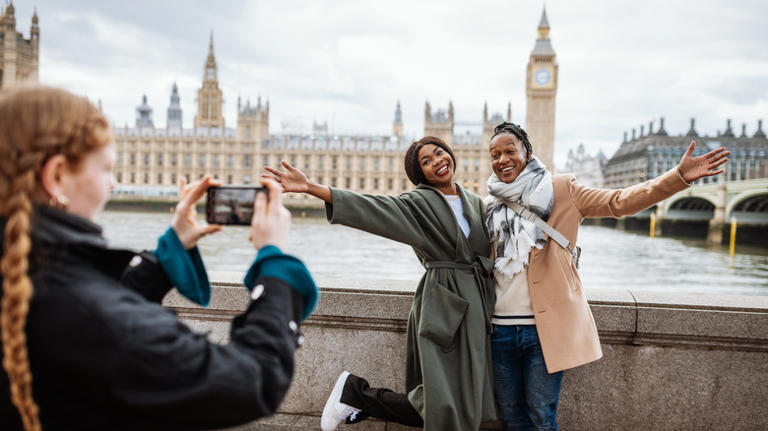
Tourists won't stop visiting a forbidden WWII-era landmark even as it's being destroyed due to over-tourism
- The Haiku Stairs in Oahu, Hawaii, have long attracted tourists who hike them illegally.
- Officials decided to remove the landmark, popularized by social media, due to over-tourism concerns.
- Five people were arrested last week as visitors flock to see the stairs before they're gone.

At least five people have been arrested, and dozens more issued warnings as tourists flock to a World War II-era landmark in Hawaii that is being destroyed due to over-tourism.
The Haiku Stairs , also known as the Stairway to Heaven, climb nearly 4,000 steps along a ridge in the Koʻolau mountains on the island of Oahu. The US Navy built the steep metal stairway — which leads to the top of a 2,800-foot peak — during World War II to reach a naval radio station.
Though previously open to hikers who obtained permits, the Haiku Stairs were fully closed to the public in 1987. However, some people continued to hike the stairs illegally.
Related stories
In recent years, videos posted on TikTok and Instagram of people illegally climbing the stairs — and instructing others on how to get to them — made the location even more popular with tourists.
In August 2021, the Honolulu City Council voted to remove the Haiku Stairs despite resistance from some community members advocating for the structure's preservation. Reasons for their removal included illegal trespassing on the stairs, disruptions to locals, and liability for the city.
When Hawaii officials announced the removal of the Haiku Stairs would begin in April, it set off another influx of visitors scrambling to visit them before they were gone for good.
On April 23, the Honolulu Police Department arrested five people for trespassing at the stairs and issued 11 citations, local Hawaii News Now reported. Another 60 people were given warnings, according to CNN .
The Honolulu Police Department did not immediately respond to a request for more information from Business Insider.
The stair removal project is set to cost over $2.5 million and take at least six months.
People illegally hiking the stairs have required risky rescues in the past. A woman and her dog were rescued in September after falling 50 feet while hiking the Haiku Stairs trail.
In October 2022, local outlet KHON2 reported 118 people had been rescued on the Haiku Stairs since 2010.
Watch: Video shows the devastation from Hawaii wildfires
- Main content
- Share full article
Advertisement
Supported by
Deep Beneath London, Onetime Bomb Shelters Will Become a Tourist Attraction
Used for spying, a phone exchange and more over the years, a semi-secret web of tunnels in central London could open to the public in 2027.

By Claire Moses
Reporting from 98 feet below street level in London
There’s a locked door on the eastbound platform of the Chancery Lane station of the London Underground. The door is unassuming, sturdy and white.
Behind it is a wide set of stairs leading to a roughly mile-long maze of tunnels built in the 1940s that were first intended to serve as a World War II shelter and later used for espionage, the storage of 400 tons of government documents and telecom services.
Welcome to the Kingsway Exchange tunnels, set roughly 100 feet below street level in the center of London, sprawling beneath the Underground’s Central Line. Soon they could enter a new chapter: Angus Murray, the owner of the complex, who bought the tunnels last summer, has applied for planning permission to the local authorities together with the architecture firm WilkinsonEyre to turn the tunnels into a tourist destination that could handle millions of people a year.
Mr. Murray’s London Tunnels is planning to invest a total of 220 million pounds (about $275 million) on restoring and preserving the tunnels, as well as adding technology for art installations and other attractions. Mr. Murray hopes to open the complex in 2027, and said that it would be able to host temporary art exhibitions, fashion shows and more.
At the moment, entering the tunnels requires riding a small elevator tucked behind a side door in an alleyway off a wide street in central London. (Visitors to the attraction would use a different, bigger entrance, Mr. Murray said.)
When the elevator doors open, you step into a World War II-era tunnel — one of 10 civilian shelters proposed by the British government after the beginning of the Blitz, the eight-month bombing of London by the Germans that started in September 1940. The tunnels were never used as shelters. By the time they were completed in 1942, the Blitz was over.
During the Cold War, the British government instructed its telephone department, which later became British Telecom, to set up a secret communications system in the tunnels that could survive a nuclear attack. The famous hotline between the Kremlin and the White House ran through the complex, according to the project’s website. Some of the phone exchange’s equipment in the tunnels still survives today, even though it hasn’t been used since at least the 1980s.
“The idea was that it would provide a degree of protection,” said Martin Dixon, a trustee for Subterranea Britannica , a charity that documents and tries to preserve underground spaces.
“If the Cold War had turned into something more serious, it would have allowed communications on some level to continue,” Mr. Dixon, who joined Subterranea Britannica about 40 years ago, said.
The tunnels under the Chancery Lane station of the tube are more than a mile long and in some places have a diameter of almost 25 feet. Those dimensions make them among the largest sets of tunnels built for people in a metropolitan city, Mr. Murray said.
“They have a fascinating history,” he said.
For a group of Post Office and telecoms workers in the decades after World War II, the tunnel complex became a workplace, some aspects of which have survived. In one room, the stuffy smell of an old carpet is inescapable. Another still holds the remnants of a canteen. Yet another has fake windows framing images of nature as decorations. There are still offices, as well as rooms where workers could spend the night.
Some parts of the tunnels are lined with fake walls, and doors with nothing behind them. The effect is not unlike watching a scene from the dystopian Apple TV+ show “Severance .”
A bar where postal workers could drink is also still there, and Mr. Murray said he hoped to revive it and make it London’s deepest underground bar.
The tunnels’ communication operation became obsolete in the 1980s, and in 2008 British Telecom put the tunnels up for sale . BT employees used to go down into the complex up until the 1990s to inspect for fire safety and other conditions. The tunnels were otherwise vacant.
Many details of the new attraction still need to be ironed out, but Mr. Murray said the cost of the experience would probably be in the same price range as that of other major tourist sites in London. (The Tower of London’s entry fee is about $40, and Westminster Abbey’s is about $36.)
Mr. Dixon, of Subterranea Britannica, said he was excited about the prospect of the Kingsway Exchange turning into an attraction — provided it’s safe and the history is preserved.
“I’ve seen thousands of underground spaces, from the mundane to the spectacular,” he said. The Kingsway Exchange is particularly interesting, he added, because of all the different functions it had. “It played its part in World War II, and was ready to play its part in the Cold War.”
Claire Moses is a Times reporter in London, focused on coverage of breaking and trending news. More about Claire Moses
China's Top 15 Must-Visit Attractions: Historical, Cultural, Scenic & More
With a vast territory and a long history, China offers so much to see and explore. We have listed for you the top 15 must-visit attractions in China for any classic China tour.
Content Preview
- 1. The Great Wall
- 2. Forbidden City
- 3. Terracotta Army
- 4. Giant Pandas
- 5. Yellow Mountains
- 6. Li River
- 7. Potala Palace
8. Zhangjiajie National Forest Park
- 9. Mogao Caves
- 10. The Bund
- 11. West Lake
- 12. Daocheng Yading Nature Reserve
- 13. Victoria Harbor
- 14. Lijiang Old Town
- 15. Erhai Lake
1. The Great Wall of China in Beijing
In the eyes of most travelers, you haven't been to China if you haven't climbed the Great Wall .
One of the iconic symbols of China, the Great Wall is the longest wall in the world , an awe-inspiring feat of ancient defensive architecture. Its winding path over a rugged country and steep mountains takes in some great scenery. It deserves its place among "the New Seven Wonders of the World" and the UNESCO World Heritage Sites in China.
T he most integrated and best-preserved sections are close to Beijing. Among them, the Jinshanling section has the most beautiful scenery and is very suitable for hiking.
The Mutianyu section has a better architecture with densely spaced watchtowers and easy to climb, which is suitable for families with the elderly and children. Which Sections of the Great Wall Should I Visit?
The Simatai section is good for a night tour of the Great Wall. See our 4-Day Beijing Highlights and Great Wall Night Tour
There is no better way to explore China's Great Wall than by hiking or walking along with it. Tread the centuries-old bricks and walk through watchtower ruins. Take your time and feel the history come to life. See 1-Day Jinshanling Great Wall Hiking Tour
Discover real reviews of Highlights Travel Family 's best-rated service across trusted platforms.
2. The Forbidden City in Beijing — Imperial Palace for 24 Emperors
It was once a "palace" city where ordinary people were forbidden entry . An extravagant demonstration of ancient Chinese architecture, over 8,000 rooms with golden roofs are elegantly designed and painted in red and yellow.
The Forbidden City was the imperial palace of the Ming and Qing Dynasties for 560 years till 1911. 24 emperors lived there. Listed as World Cultural Heritage, it also houses many Chinese cultural and historical relics and treasures . See 4-Day Beijing Private Tour with Visit to Forbidden City
It is recognized as one of the five most important palaces in the world (with the Palace of Versailles in France, Buckingham Palace in the UK, the White House in the US, and the Kremlin in Russia). Read on How to Visit the Forbidden City — for Discerning Travelers
3. The Terracotta Army in Xi'an — 2,000-Year-Old Underground Army
The Terracotta Army has been laid underground for more than 2,000 years . However, in 1974, farmers digging a well uncovered one of the greatest archaeological sites in the world. In 1987 it became World Cultural Heritage.
It is significant because the hundreds of detailed life-size models represent the army that triumphed over all other Chinese armies in the Warring States Period (475—221 BC), and who were the decisive factor in forming a united China.
It raises interesting questions about why it was made, which await your consideration when you come face-to-face with soldiers of the past. See our 3-Day Essence of Xi'an Tour including Terracotta Warriors
You could make your own warriors at a cave-dwelling where there are only a few craftsmen left who continue to work in a traditional way . Read more about How to Visit the Terracotta Army Hassle Free
All our tours are customized . Our travel consultants will create an itinerary based on your interests, group sizes, travel length, and other requirements.
4. Giant Pandas in Chengdu — China's "National Treasure"
The giant panda is not only deeply loved by the Chinese, but by many foreigners too, and not just children. Although there are many zoos in China and elsewhere, where you can see a giant panda, the best place to see them is Chengdu — the giant panda's "hometown" .
There are three places you can see pandas close up : Chengdu Panda Breeding and Research Center, Dujiangyan Panda Valley, and Bifengxia Panda Base.
- Chengdu Panda Center is in the north of the city and is more established.
- Dujiangyan and Bifengxia Panda Bases are 1-2 hours from Chengdu and you can see pandas in their natural habitat.
- You can get even closer to the pandas by taking a volunteer program in Dujiangyan or Bifengxia Panda Valley . See our 1-Day Dujiangyan Panda Volunteer Program Tour
Read more about How to Plan a Panda Tour
5. The Yellow Mountains near Shanghai — Legendary Wonders
In east China, close to Shanghai and Hangzhou, the Yellow Mountain Scenic Area (Huangshan) woos travelers with its five wonders : sunrises , seas of clouds , oddly-shaped rocks , twisted pine trees , and hot springs . The Yellow Mountains are the most famous peaks in China.
The villages nearby such as Hongcun Village were once considered to be the utopia of ancient China . Villagers have diverted water into "house gardens" and "water yards", which exist only in this village. The village, in its breathing-taking setting, looks like a Chinese painting. Canola flowers in spring can be the icing on the cake.
Bishan Village is the best choice if you want to enjoy some quiet moments with your partner. Stay in a typical Hui-style inn, feel the freshness of the air on an early morning walk, and drink a coffee while enjoying nature in its unspoiled beauty. See our 3-Day Ancient Villages and Yellow Mountains Tour
6. The Li River in Guilin & Yangshuo — China's Most Celebrated Scenery
The karst landscape along the Li River has captured the heart of artists. Generations of Chinese painters and poets have been inspired by the beauty of nature there, using their pens and brushes to capture the breathtaking natural scenery. When Chinese travelers seek a place for natural beauty, they first think of Li River and Yangshuo .
The Li River was listed as one of the "World's Top Ten Watery Wonders" by America's National Geographic Magazine. Several world-famous figures have visited the Li River, including former US Presidents Bill Clinton and George Bush (senior), and Bill Gates.
The 83-kilometer-long section of the Li River between Guilin and Yangshuo is the most beautiful. The river landscape is decorated with startling hills, steep cliffs, and farming villages, and is lined with bamboo groves.
Taking a leisurely cruise or a 3–4-hour family-friendly moderate hike (more on Li River hiking ) are good ways to enjoy the Li River's beauty.
Guilin & Yangshuo offer many interesting activities. You could challenge yourself to an SUP (stand-up paddleboard, i.e. a mini raft) on the Yulong River, take a bamboo raft , have a cycling tour into the countryside, or take an exciting drive with an all-terrain vehicle . See 5-Day Dynamic Guilin and Yangshuo Tour
7. The Potala Palace in Tibet — Heart of the Roof of the World
The Potala Palace is a symbol of Tibet . In 1994 it was declared a UNESCO World Cultural Heritage Site. It is a huge treasure house of materials and articles from Tibetan history, religion, culture, and art. The palace is widely known for its precious sculptures, murals, scriptures, Buddhist statues, antiques, and religious jewelry housed within it.
You could witness the architectural miracle containing the regal heritage of Tibet, listen to stories of Dalai Lamas who lived in the palace, and view the palace from the four best angles .
Tibet doesn't accept independent travelers . Traveling with a travel agency is required. Read more about Tibet Travel Restrictions or contact us to explore the main highlights from Lhasa to Everest Base Camp. See our 8-Day Lhasa to Everest Base Camp Private Tour
Zhangjiajie National Forest Park , the inspiration of Avatar, is a must-see place for its out-of-this-world scenery . It is huge with many different scenic areas. The "floating mountains and peaks" that inspired Avatar are concentrated in this park.
The top-rated scenic areas are Yuanjiajie, Tianzi Mountain, and Gold Whip Stream. These three areas can be visited by tourists of any age.
Walking is not hard at the main attractions, where cable cars, elevators, a tram, and shuttle buses are available and concrete paths and steps have been built. See our 4 Days Essence of Zhangjiajie
9. The Mogao Caves in Dunhuang
"In the West, there is the Louvre; in the East, there are the Mogao Caves."
The Mogao Caves are famous for their exquisite murals and Buddhist statues . The Mogao Caves were included in UNESCO's world cultural heritage list in 1987.
Artists from different periods of the Middle Ages left their work there. All kinds of works spanning over one thousand years complement each other.
Standing out in the desert, the Mogao Caves are like a glittering pearl that adorns the Silk Road .
In addition to visiting these wonderful caves, you could get some hands-on archaeological experience. We can take you to the Dunhuang Research Academy. There, you can linger over copies of murals created by masters and can copy a sample mural on a mud slab with your own hands under the guidance of the teacher.
- 5-Day Dunhuang In-Depth Private Tour including Visit to Mogao Caves
- 13-Day Beijing–Xi'an–Dunhuang–Urumqi–Shanghai Tour - Silk Road Highlights and China's Gateway Cities
10. The Bund in Shanghai — Stunning Skyline, Colonial Architecture
The Bund is one of the most recognizable architectural symbols of Shanghai. It showcases the world with its colonial European buildings and skyscrapers on the other side of the Huangpu, housing one of the world's foremost business districts.
The Bund was Shanghai's most prosperous area in the late 19th century and early 20th century. When the first British company opened an office at the Bund in 1846, it became the epitome of elegance .
one of the best ways to explore the Bund is to take an in-depth cultural walk where you could step into some of the iconic old buildings and learn about the stories behind them. A night cruise on the Huang Pu Rover could also be a good choice.
11. West Lake in Hangzhou — Paradise on Earth
Hangzhou is renowned as China's "paradise on earth" owing to its beautifully crafted landscape . West Lake was created after the Chinese love for garden-style parks for recreation.
West Lake is a place of tranquility where urbanity becomes a silhouette on the northeast horizon and mountains near and far surround it on the other three sides. The occasional pagoda and Chinese-style arched bridge add atmosphere to the tree-lined walkways, verdant islands, and hills.
To admire the beauty of West Lake, you can leisurely bike around the lake, walk around the lake, or take a short cruise on the lake . We could also find a perfect location for you to enjoy afternoon tea while enjoying the beautiful view of West Lake. See 4-Day Shanghai & Hangzhou with Watertown Tour
12. Daocheng Yading Nature Reserve — Gemstone-Colored Lakes, Colorful Forests, Meadows
Daocheng Yading Nature Reserve is called "the last pure land on earth" and "the last Shangri-La" due to its breathtaking natural scenery.
"I want to go there with my sweetheart to see the clear blue sky, the snowcapped mountains, and the golden meadows, to experience an autumn fairy tale." A Chinese romantic drama movie, I Belonged to You , made Daocheng a desirable romantic place to visit.
As early as 1928, the Austrian-American explorer Joseph F. Rock visited Daocheng and captured its beauty, printing pictures of it in the National Geographic magazine and making it known to the world .
The Tibetan cultural experience is another highlight of this route . You can see many ancient monasteries and Tibetan-style houses during the trip.
- 8-Day Chengdu to Shangri-La Adventure Tour - Chengdu, Xinduqiao, Daocheng, Riwa, Xiangcheng, and Shangri-La
- 9-Day Panorama Western Sichuan Tour — Chengdu, Wolong (Baby Pandas), Rilong, Danba, Tagong, Litang, Riwa, Yajiang, and Moxi
All our tours can be customized. The itinerary can be adjusted according to your group size, time, interests, and other requirements. Just contact us .
13. Victoria Harbor in Hong Kong — Mighty Skyscraper Skyline
The view over Victoria Harbour from Victoria Peak is to Hong Kong as climbing the Great Wall is to China ; it offers the iconic outlook over Hong Kong's "high rise" to success and prosperity.
Victoria Peak is the best spot to have a bird's eye view of Hong Kong . Viewed from the peak, both day and night scenes are worth taking in. See high-rise buildings around the busy Victoria Harbour stretching out towards the Chinese mainland. At night the scenery is gorgeous when the Symphony of Lights of various buildings dances in unison .
14. Lijiang Old Town in Yunnan — Cobbled Pedestrian Streets, Small Waterways
Lijiang Old Town in Yunnan is characterized by ancient cobbled streets, stone bridges, and water-wheel-driven canals decorated with flowers. Shops, cafés, bars, restaurants, snack stalls, and hotels can be found everywhere .
The big waterwheels are a landmark of Lijiang Old Town. As you enter the old town, you will see them. The river flowing through the old town keeps them rotating. Bar Street is next to them, which is busy at night.
You could also go to Naxi Hieroglyphs and Painting Exhibition Hall to experience Naxi art . The Naxi are the only people who still use hieroglyphs to write in the world .
- 8-Day Kunming, Dali, Lijiang, and Shangri-La Tour - Meet the Amazing Beauty of Yunnan
- 9-Day Yunnan Family Tour - Kunming, Dali, Lijiang, and Shangri-La
All our Yunnan tours can be customized. Contact us to create a trip for you according to your group size, time, budget, interests, and other requirements.
15. Erhai Lake in Dali — One of the Most Beautiful Lakes in China
Erhai Lake is the most beautiful place in Dali . It is a plateau lake. Erhai Lake is in the shape of an ear, hence its name Erhai ('Ear Sea'). This plateau lake is like a deep blue gem set in the green land. The water of the lake is calm and blue. The soft and gentle wind by the lake will make you feel relaxed.
Every December, flocks of black-headed gulls from Siberia fly in to spend the winter at Erhai Lake .
Biking is the best way to travel around the lake . Capturing the beauty of the landscape bathed in sunshine and breezes is a real pleasure. There are two cycle routes around Erhai Lake : Haixi (on Erhai's west shore) and Haidong (on Erhai's east shore). The Haixi route is more suitable for young or inexperienced riders. Haidong route is quiet and has panoramic views. Contact us to arrange mountain bikes with helmets for you.
- 4-Day Dynamic Dali Tour - Hike and Bike
- 6-Day Kunming, Dali, and Lijiang Tour - Yunnan Ethnic Minorities Tour
- 7-Day Dali, Lijiang, and Shangri-La Tour - A Feast of Landscapes and Ethnic Minority Culture
The Most Popular China Tour Itineraries
Our tour services are personalized . We will help you to maximize your travel experience by suggesting the optimal trip for the time you have and the places you want to see. Just contact us .
- The Golden Triangle (8 days): Beijing, Xi'an, and Shanghai — the most popular destinations for a first trip
- Classic Wonders (11 days): Beijing, Xi'an, Guilin, and Shanghai — classic architecture, culture, and scenery
- Find more ideas from our China tours .
- 2-Week Private China Tour: Beijing–Xi'an–Lhasa-Shanghai
- 9-Day Beyond the Golden Triangle
- 11-Day China Family Tour
- 12-Day Beijing, Xi'an, Guilin, Shanghai Tour for Your Summer Vacation
- 15 Best Places to Visit in China (2024)
- Best (& Worst) Times to Visit China, Travel Tips (2024/2025)
- How to Plan a 10-Day Itinerary in China (Best 5 Options)
- 8 Days in China: Top 15 Tours and Itineraries (2024/2025)
- China Weather in January 2024: Enjoy Less-Crowded Traveling
- China Weather in February 2024: Places to Go, Costs, and Crowds
- China Weather in March 2024: Destinations, Crowds, and Costs
- China Weather in April 2024: Where to Go (Smart Pre-Season Pick)
- China Weather in May 2024: Where to Go, Crowds, and Costs
- China Weather in June 2024: How to Benefit from the Rainy Season
- China Weather in July 2024: How to Avoid Heat and Crowds
- China Weather in August 2024: Weather Tips & Where to Go
- China Weather in September 2024: Weather Tips & Where to Go
- China Weather in October 2024: Where to Go, Crowds, and Costs
- China Weather in November 2024: Places to Go & Crowds
- China Weather in December 2024: Places to Go and Crowds
Get Inspired with Some Popular Itineraries
More travel ideas and inspiration, sign up to our newsletter.
Be the first to receive exciting updates, exclusive promotions, and valuable travel tips from our team of experts.
Why China Highlights
Where can we take you today.
- Southeast Asia
- Japan, South Korea
- India, Nepal, Bhutan, and Sri lanka
- Central Asia
- Middle East
- African Safari
- Travel Agents
- Loyalty & Referral Program
- Privacy Policy
Address: Building 6, Chuangyi Business Park, 70 Qilidian Road, Guilin, Guangxi, 541004, China

IMAGES
VIDEO
COMMENTS
The Forbidden City covers an area of about 72 hectares (180 acres) with a total floor space of approximately 150,000 square meters (1,600,000 square feet). ... The Forbidden City is a must-see attraction for visitors to Beijing. Visitors are limited to 80,000 a day. It is advisable to book well in advance.
Forbidden City is the busiest attraction in Beijing, so it is always full of people. Some tips for you to avoid the crowds: 1. Go earlier. It opens at 8:30 am, so arrive at 8 am and queue at the beginning. ... The Forbidden City turret is also a great place for photos. Beihai Park is a 5-minute from the North Gate of the Forbidden City.
Location: 4 Jingshan Front Street, Dongcheng District, Beijing, China. Meridian Gate is the mainly enterance for visitors. There are three ways to get to the Forbidden City: By subway: Take Subway Line 1 and get off at Tiananmen West (Exit B) or Tiananmen East Station (Exit B). By bus: Take bus 2, 82, or 120 and get off at Tiananmen East Stop.
Forbidden City. Enclosed by 3.5km of citadel walls at the very heart of Beijing, the Unesco-listed Forbidden City is China's largest and best-preserved collection of ancient buildings - large enough to comfortably absorb the 16 million visitors it receives each year. Steeped in stultifying ritual, this otherworldly palace was the reclusive ...
It is considered to be among the world's top 5 most important palaces of all time, and is China's most popular single-site tourist attraction. Read on for the top facts pertinent to tourists. Chinese name: 故宫 Gùgōng /goo-gong/ 'Formers Palace' 1. The Forbidden City is the world's largest imperial palace.
The Forbidden City, nestled in the heart of Beijing, holds a distinguished place as a UNESCO World Heritage site and stands as an enduring symbol of China's rich cultural heritage. For more than 500 years, it served as the regal abode for Chinese emperors and their households during the illustrious reigns of the Ming and Qing dynasties.
Within its six centuries of history, Beijing's Forbidden City has turned from being the residence of Ming and Qing emperors to being one of the most visited open-air museums in the world. One of China's top attractions together with the Great Wall, the Forbidden City is a complex consisting of 980 buildings that were once inaccessible to commoners.
It is about 7 miles (11km) to the north of the imperial palace. You can take sightseeing bus line 3 from the palace to East Beichen Road (Bird's Nest) Station. :) 6 main halls along the central axis and 2 galleries are must-see inside the Forbidden City. You can visit it in 2 hours, half-day or one day in-depth.
Forbidden City & Dongcheng Central. Propaganda notwithstanding, this is an engaging foray into the storied history of Beijing's police force. Learn how China's first Security Bureau (PSB)…. 1. 2. Discover the best attractions in Forbidden City & Dongcheng Central including Forbidden City, Tian'anmen Square, and Gate of Heavenly Peace.
💛12 Hidden Attractions Around the Forbidden City. A lot of people tend to visit Beijing and prioritize popular tourist attractions such as the Forbidden City, Tiananmen Square, and the National Museum. However, there are numerous hidden treasure attractions located near the Forbidden City that not many people know about.
As the seat of power for hundreds of years, Beijing is full of examples of imperial extravagance and architectural design. In no place are these on better display than the Forbidden City, also known as the Palace Museum or gu gong in Chinese.. This immense complex, with its seemingly endless red and gold buildings, sits at the heart of Beijing and was the home of the emperors and their ...
The Forbidden City is closed every Monday unless it is a Chinese national holiday, in which case you shouldn't visit either because of the huge crowds. Forbidden City Opening Hours. Months. Opening Hours. Ticketing Time. April to October. 8:30-17:00. 8:30-16:00.
The Forbidden City is an extremely popular tourist attraction not only for international tourists, but for Chinese tourists and locals as well. Yes, even if people only have a day in Beijing or a short stopover, ... Getting to the Forbidden City. Public transport, in particular the subway, is the easiest, cheapest and most convenient way to ...
1 Apr - 31 Oct. 8.30am - 5.00pm. 1 Nov - 31 Mar. 8.30am - 4.30pm. Enjoy the opportunity to get up close with China's imperial history with a visit to the Forbidden City. Make the most of your travel time with a guided tour and discover all the mystery, intrigue, and beauty within the four walls of the palace.
The Forbidden City is one of the must-see attractions in Beijing. One day Beijing Forbidden City Tour: best preserved imperial palace and the largest ancient palatial structure. 4-day Essence of Beijing Tour: see the highlights of Beijing: the magnificent Forbidden City, the man-made world wonder - the Great Wall and old hutong alleys.
The Forbidden City. B eijing's most famous tourist attraction is the Forbidden City—where China's emperors held court for 500 years from the 15 th century until 1911. Since the Chinese believed that the emperor was the Son of Heaven, they believed that the Forbidden City was literally at the center of the Universe (and you thought Donald ...
The romantic sounding Forbidden City is the name of the imperial palace which was active from the Ming to the Qing dynasties, roughly 500 years. This enormous complex consists of 980 buildings, covering an area of over 180 acres. Today you can visit the Palace Museum with its extensive collection of art and artifacts and walk among the outer ...
The Forbidden City is a large palace complex that is now a museum and a very popular tourist attraction in Beijing. ... The grand palaces and the precious relics displayed in the Forbidden City are the biggest attractions. The appearance and furnishings of some palace halls have been restored to what they were like in the Ming and Qing ...
2021-05-31 |. The Forbidden City is located at the core of Beijing's central axis. It is one of the largest and best preserved ancient wooden structures in the world. As a world cultural heritage site, the Forbidden City has become a unique symbol of Chinese civilization, and one of the must-see attractions for foreigners coming to Beijing.
For nearly 500 years, the emperors living within Beijing's opulent Forbidden City dictated who could enter and leave. Well, the gates have opened, and tourists are pouring in to see it all for ...
Forbidden City's Bureaucrat Hinders Post-Pandemic Tourism Boom. Forbidden City, a UNESCO World Heritage Site and a landmark of China, is becoming an unattainable site on the travel list of more and more visitors. That's because it's more and more challenging to acquire an entry ticket. Every day, only 30,000 tickets are issued but the ...
The site ranks with the Great Wall and Beijing's Forbidden City as one of China's premier tourist attractions. An aerial view of a pit filled with terra-cotta soldiers Thierrytutin via ...
Double-decker London buses offer spectacular city views, with many routes passing right by London's landmark attractions. One of our faves is the historic Routemaster Bus 15, which we suggest ...
At least five people have been arrested, and dozens more issued warnings as tourists flock to a World War II-era landmark in Hawaii that is being destroyed due to over-tourism. The Haiku Stairs ...
Lau Shui Heung Reservoir, one of the most popular hiking trails in Hong Kong, on December 20. Most of Hong Kong's underappreciated natural attractions are within 45 minutes of the city centre.
Many details of the new attraction still need to be ironed out, but Mr. Murray said the cost of the experience would probably be in the same price range as that of other major tourist sites in London.
The top 15 famous tourist attractions in China include the famous Great Wall, Terracotta Army, the Forbidden City, and more. See more information and photos. ... The Forbidden City was the imperial palace of the Ming and Qing Dynasties for 560 years till 1911. 24 emperors lived there.